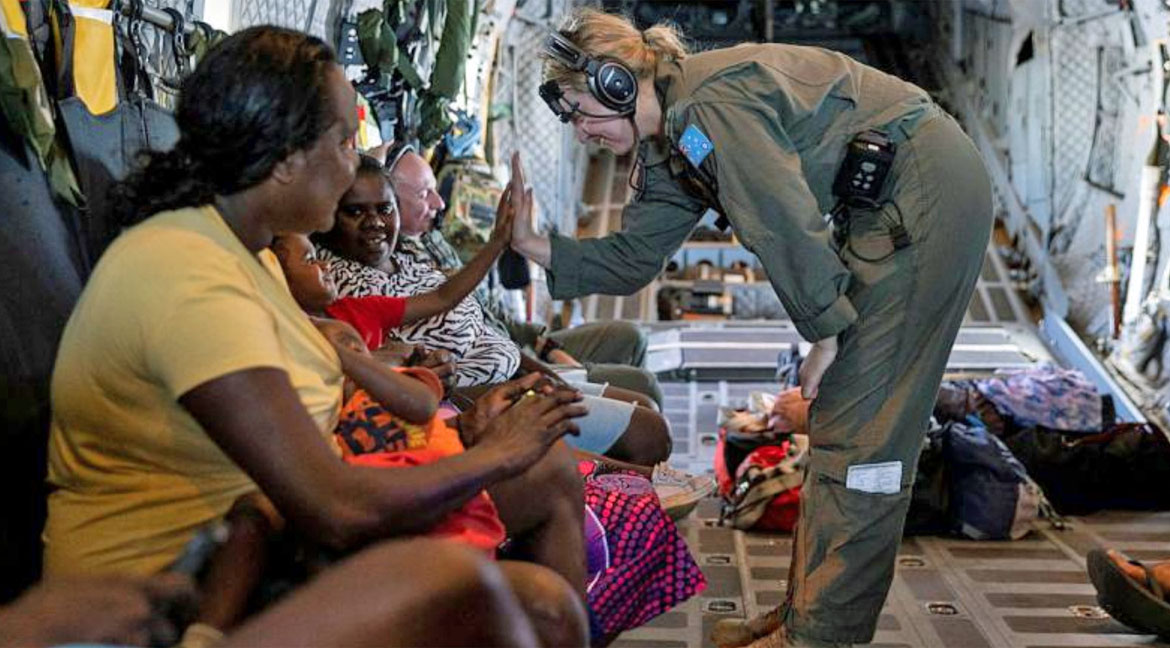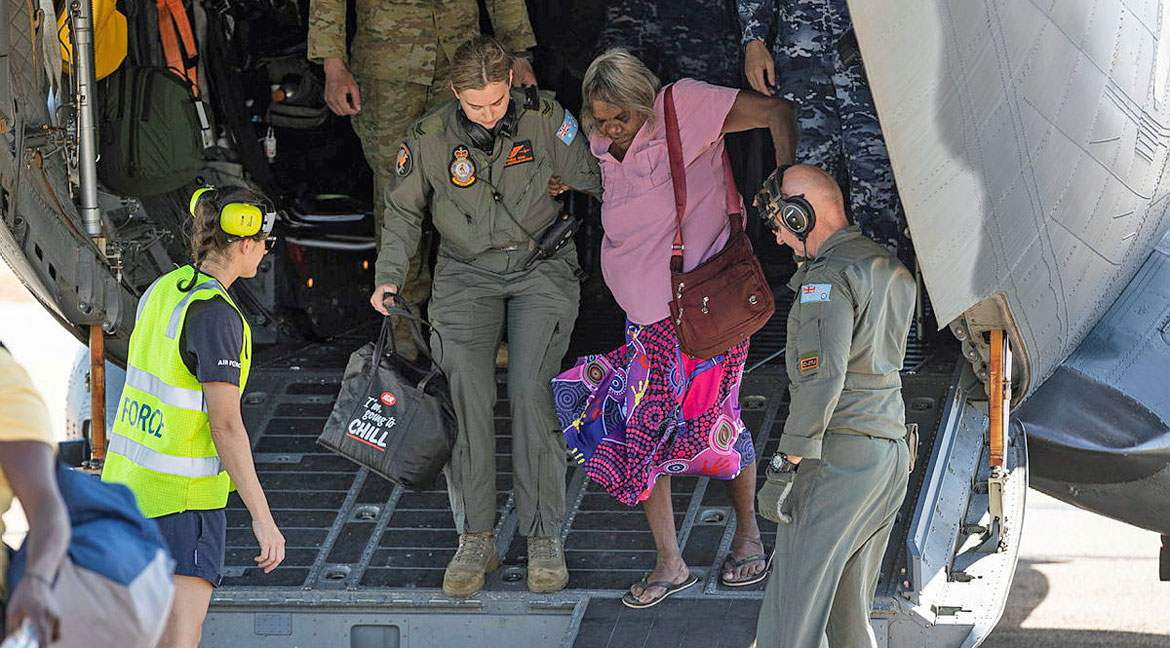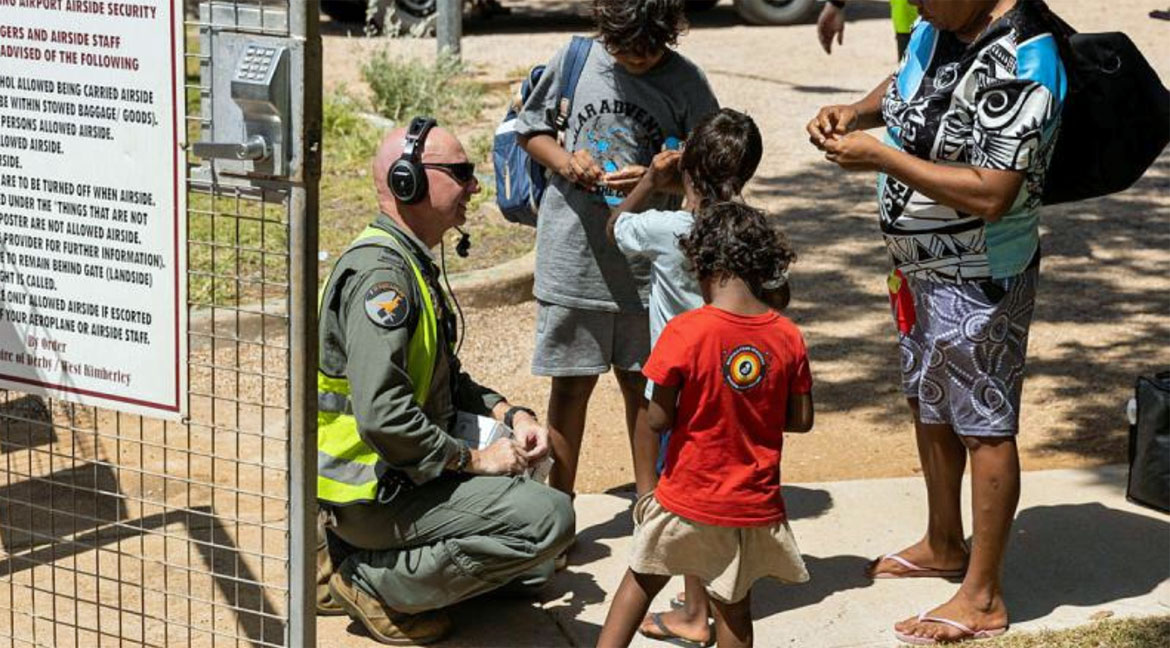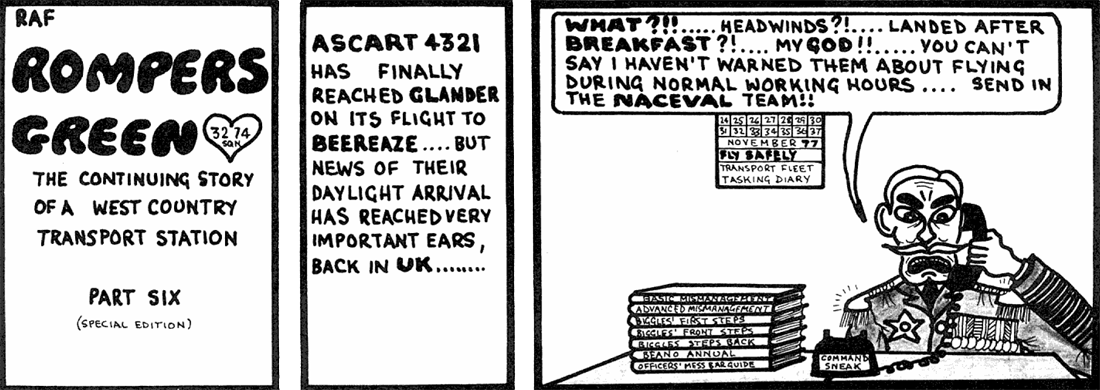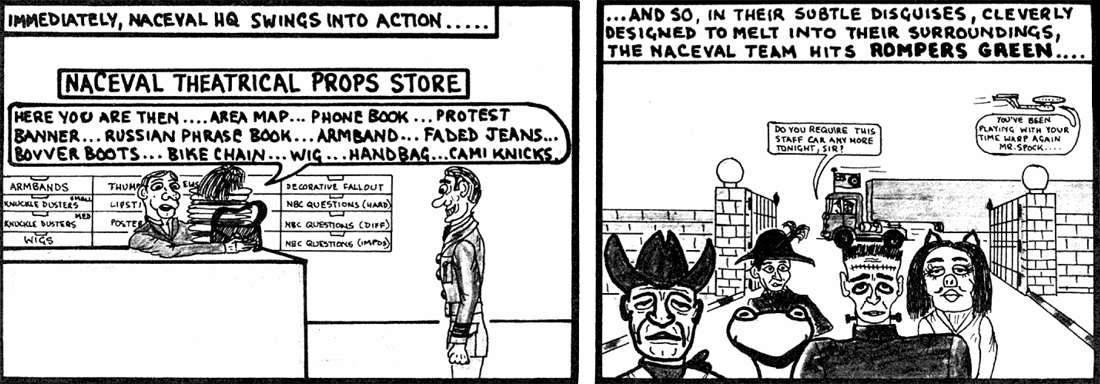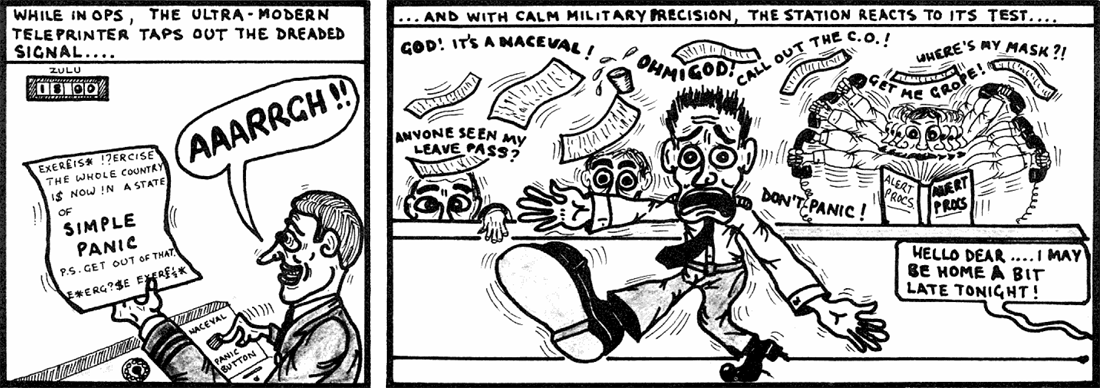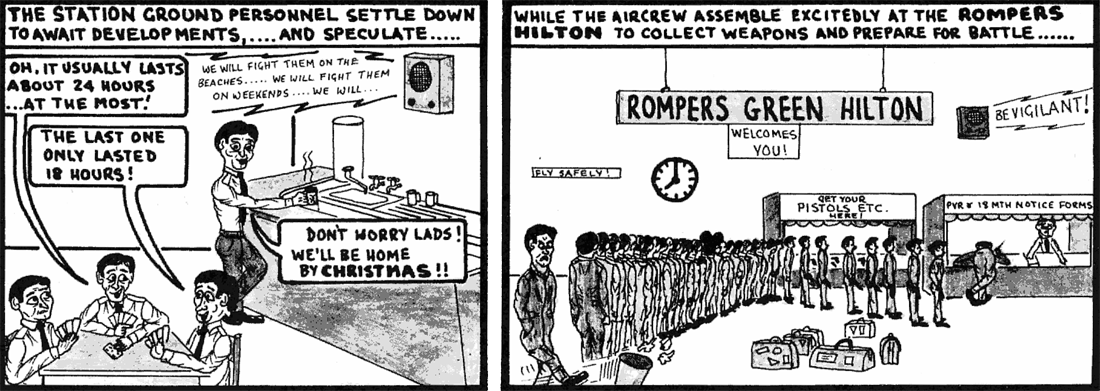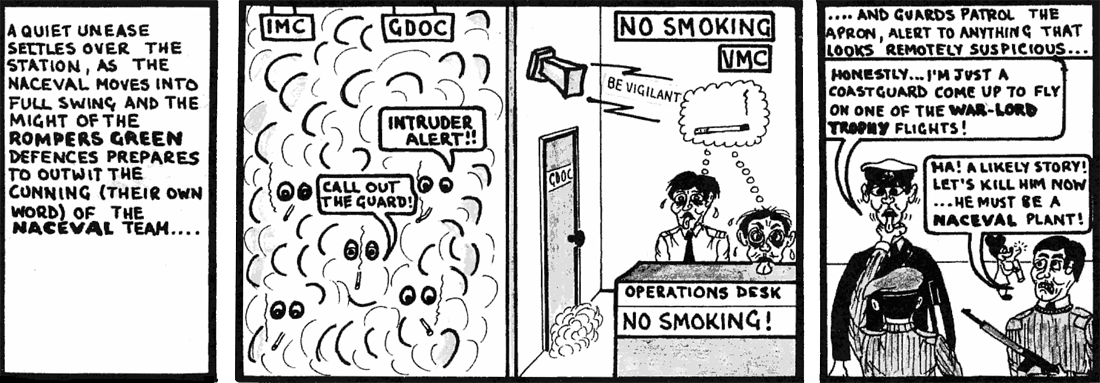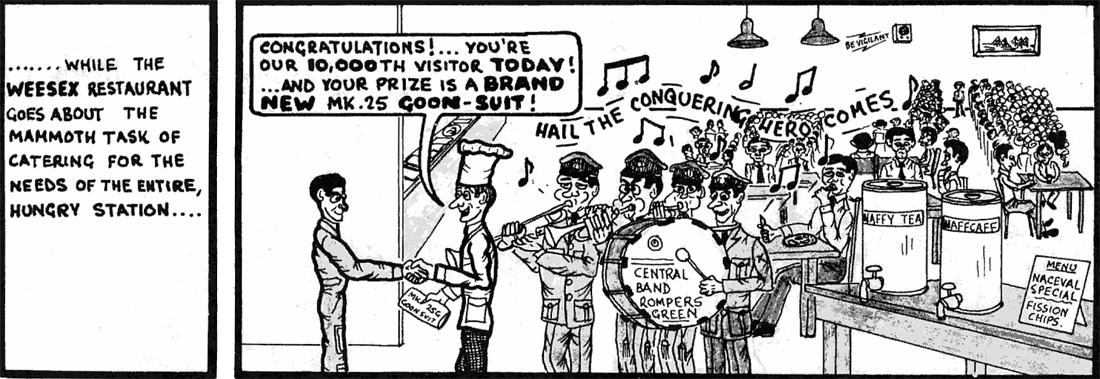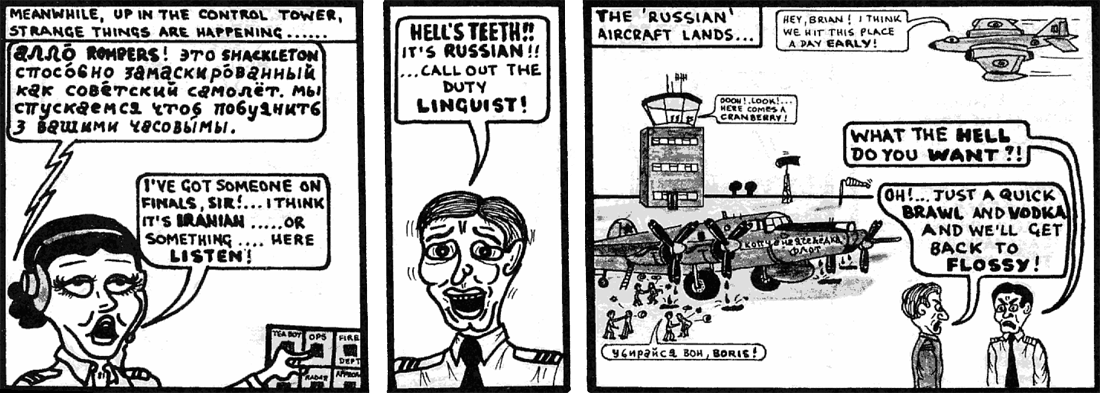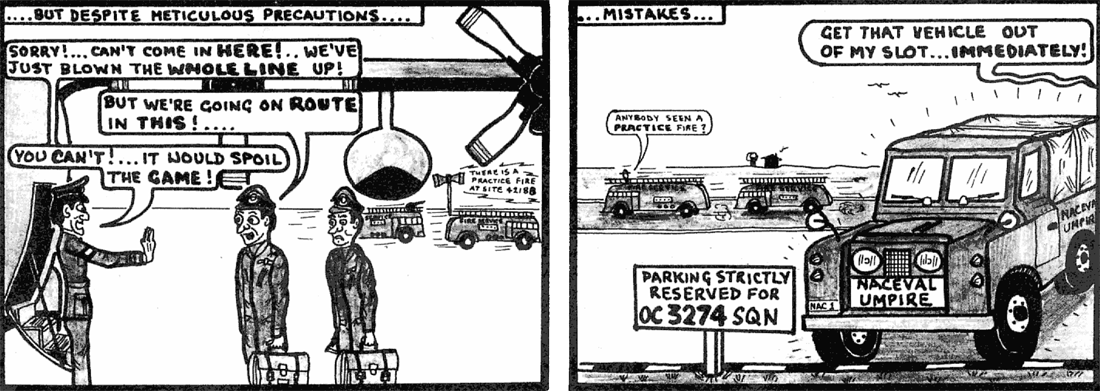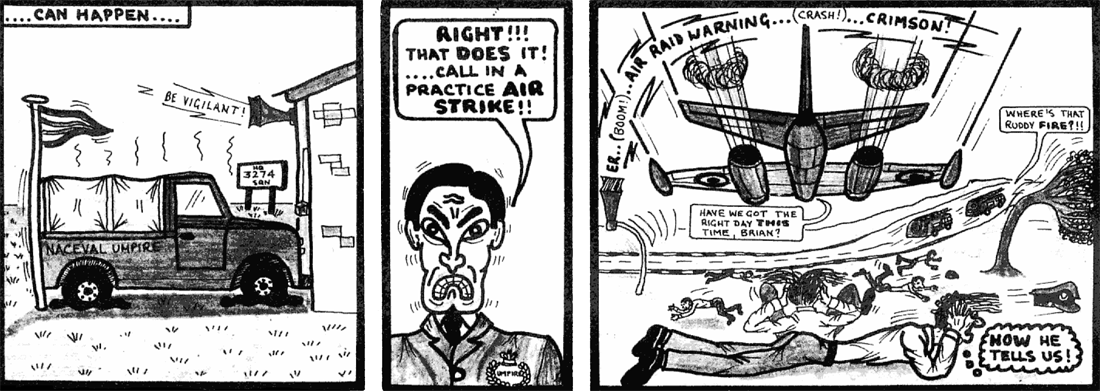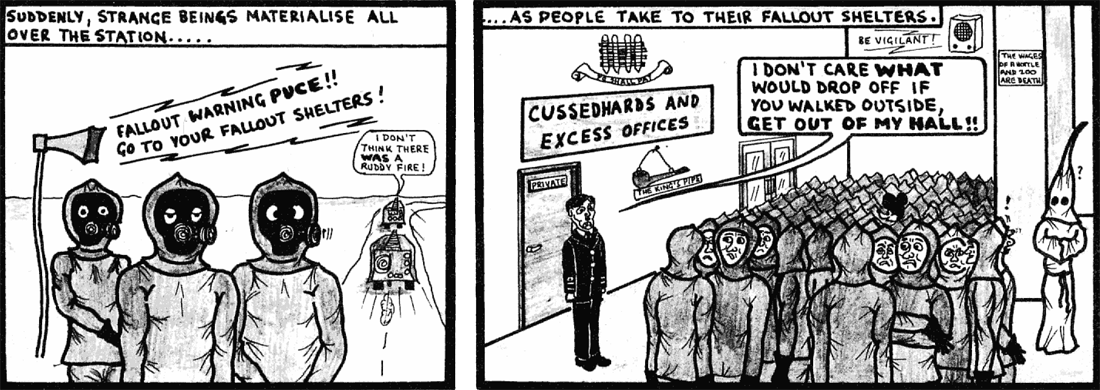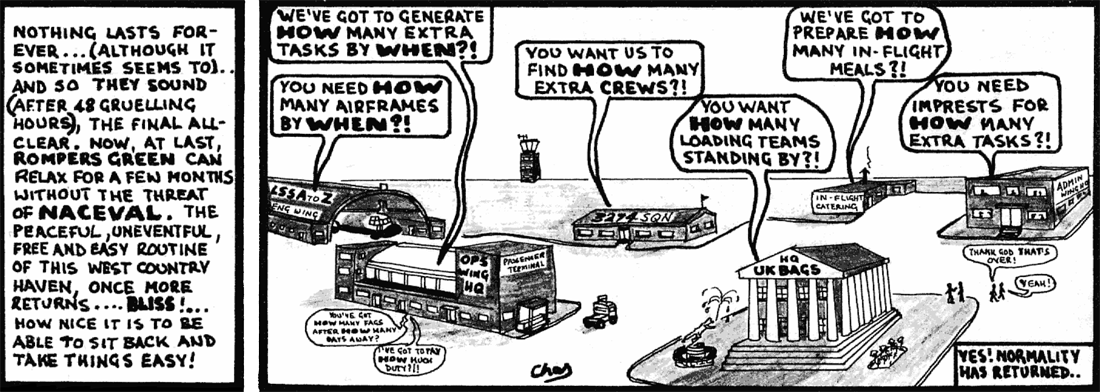David Powell, Princes Risborough, Bucks
Before one trip, I think it was a Phantom USA spares pickup, arriving at the aircraft at Brize Norton, I had to give the Loadmaster a signed piece of paper certifying that I was not the DPOW. This was duly taken up to the Cockpit for the skipper's approval before we were allowed on board!
Before one trip, I think it was a Phantom USA spares pickup, arriving at the aircraft at Brize Norton, I had to give the Loadmaster a signed piece of paper certifying that I was not the DPOW. This was duly taken up to the Cockpit for the skipper's approval before we were allowed on board!


From: John Furney, Dymock, Gloucestershire
Subject: Turning the clock back
Hi Tony,
Delighted to see in the Christmas edition a picture of “Two Originals” namely Mike Green and Ian Stacey.
Thought that this picture may turn the clock back to when they were actually working for a living at RAF Abingdon in 1964. It also shows two other UKMAMS officers at the time John Dunn and Nigel Saunders, and of course I was also there but behind the camera. The lady, the most important person at RAF Abingdon to all imprest holders, namely, the station accountant, Pat Meekins, very much an honorary member of UKMAMS at that time.
Happy New Year!
John Furney
Subject: Turning the clock back
Hi Tony,
Delighted to see in the Christmas edition a picture of “Two Originals” namely Mike Green and Ian Stacey.
Thought that this picture may turn the clock back to when they were actually working for a living at RAF Abingdon in 1964. It also shows two other UKMAMS officers at the time John Dunn and Nigel Saunders, and of course I was also there but behind the camera. The lady, the most important person at RAF Abingdon to all imprest holders, namely, the station accountant, Pat Meekins, very much an honorary member of UKMAMS at that time.
Happy New Year!
John Furney
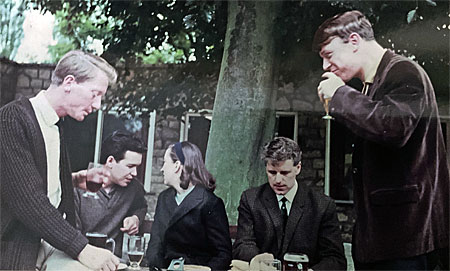
Abingdon, 1964
John Dunn, Mike Green, Pat Meekins,
Nigel Saunders and Ian Stacey
John Dunn, Mike Green, Pat Meekins,
Nigel Saunders and Ian Stacey
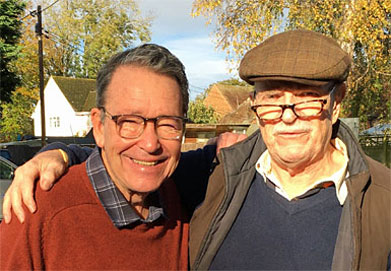
Abingdon, 2022
"Two Originals" Mike Green and Ian Stacey
"Two Originals" Mike Green and Ian Stacey

Rishi Sunak is slammed for using RAF jet to travel from London to Leeds
Rishi Sunak was under fire today for using an RAF jet to fly 200 miles to Leeds for an NHS photo op. Downing Street defended the prime minister for using a military Envoy passenger plane for the 36-minute journey from London to West Yorkshire on Monday, saying there was 'a great deal of pressure on his time'. Number 10 posted pictures online showing him boarding the French-made executive jet, which can carry 14 people, late last night, in front of a saluting serviceman.
A train from Kings Cross to Leeds takes a little over two hours. But rail services across the north of England have been dogged by problems in recent months. There have also been extensive strikes affecting services across the country.
The PM's official spokesman told reporters today: 'The transport the prime minister takes will vary and always be done in the interest of what's most effective.'
dailymail.co.uk
A train from Kings Cross to Leeds takes a little over two hours. But rail services across the north of England have been dogged by problems in recent months. There have also been extensive strikes affecting services across the country.
The PM's official spokesman told reporters today: 'The transport the prime minister takes will vary and always be done in the interest of what's most effective.'
dailymail.co.uk
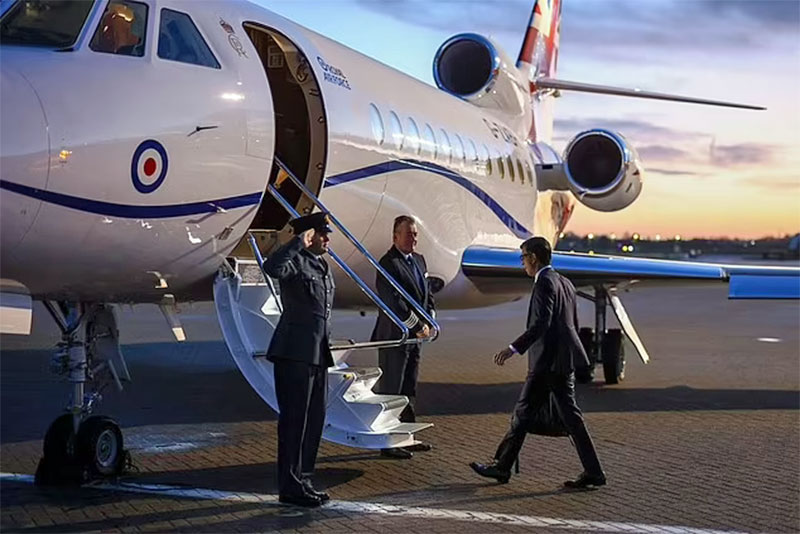

From: Steve Cross, Doncaster, South Yorks
Subject: First posting following the Movements School
Hi Tony,
My first posting fresh out of the Movements School; not sure why I deserved a posting to Air Movements at RAF Lossiemouth and recall that I wasn’t overly excited to go.
After a short 12-hour train journey from home, I arrived in front of a sympathetic P.A. Clerk who helped negotiate with the SNCO i/c mobility to at least see me. I could hear the argument that the establishment was for a seasoned SAC, not some sprog straight from school! I did volunteer to go home and await the next posting, but the clerk persisted and I was directed to a world war vintage command caravan. Up the steps I went and with a degree of dread and confidence knocked loudly on the door.
After a gruff motion to enter, the sergeant didn’t look too impressed. As I sat in front of his desk, the phone rang. After what seamed like an age of playing who dares blinks, I picked up the phone and managed to answer the query. From that moment on I had impressed the Sergeant and gained a fantastic mentor in Ken Grant.
My time at Lossie was momentous, enjoying a great family of movers and suppliers, whilst building up my levels of alcoholic tolerance. For those that know - I miss the ‘Tufty Club’.
All the best,
Steve
Subject: First posting following the Movements School
Hi Tony,
My first posting fresh out of the Movements School; not sure why I deserved a posting to Air Movements at RAF Lossiemouth and recall that I wasn’t overly excited to go.
After a short 12-hour train journey from home, I arrived in front of a sympathetic P.A. Clerk who helped negotiate with the SNCO i/c mobility to at least see me. I could hear the argument that the establishment was for a seasoned SAC, not some sprog straight from school! I did volunteer to go home and await the next posting, but the clerk persisted and I was directed to a world war vintage command caravan. Up the steps I went and with a degree of dread and confidence knocked loudly on the door.
After a gruff motion to enter, the sergeant didn’t look too impressed. As I sat in front of his desk, the phone rang. After what seamed like an age of playing who dares blinks, I picked up the phone and managed to answer the query. From that moment on I had impressed the Sergeant and gained a fantastic mentor in Ken Grant.
My time at Lossie was momentous, enjoying a great family of movers and suppliers, whilst building up my levels of alcoholic tolerance. For those that know - I miss the ‘Tufty Club’.
All the best,
Steve


From: John Leek, La Ronde Deux Serves
Subject: First posting following the Movements School
Hi Tony,
Finished Movements School in December 1961 and, together with Mick Antley, was posted to Khormaksar arriving in January of 1962.
We flew out on a BUA Britannia all wearing winter clothing. By the time we were over Sudan, the aircrew started tweaking up the heating and on our arrival, nearly everyone was down to shirtsleeves; except the Army o/c pax who kept his three-piece suit on and suffered!
Regards,
John
Subject: First posting following the Movements School
Hi Tony,
Finished Movements School in December 1961 and, together with Mick Antley, was posted to Khormaksar arriving in January of 1962.
We flew out on a BUA Britannia all wearing winter clothing. By the time we were over Sudan, the aircrew started tweaking up the heating and on our arrival, nearly everyone was down to shirtsleeves; except the Army o/c pax who kept his three-piece suit on and suffered!
Regards,
John


Procurement of new Canadian military aircraft for Arctic operations put on hold
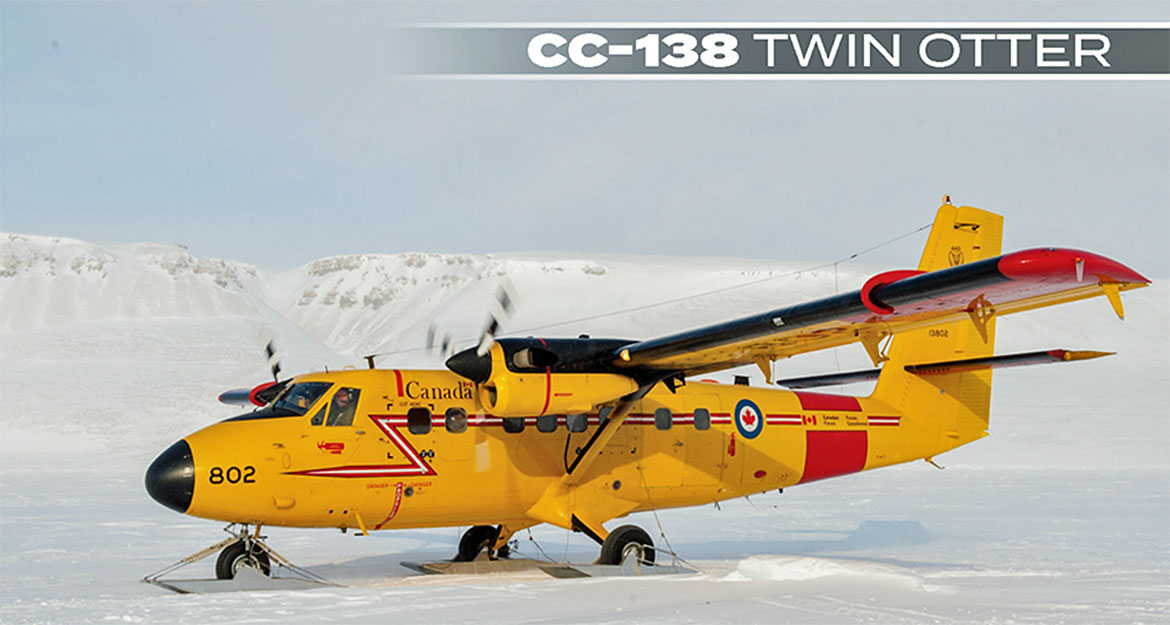
Canada has put off a project to replace its five-decade-old Twin Otter military aircraft used in Arctic operations. The move comes despite the government’s earlier assurance that it is committed to improving its defense capabilities in the north. Instead of procuring new aircraft, Ottawa will extend the service life of its aging Arctic planes. An evaluation of the fleet’s estimated life expectancy is now being conducted to determine what additional work needs to be done, according to the Canadian Department of National Defence.
“The Twin Otter remains a robust, versatile aircraft that continues to serve the RCAF exceptionally well in the conduct of Northern Operations,” the department told Ottawa Citizen.
Procurement of new planes was supposed to start in 2024, with initial deliveries expected to be carried out in 2027.
Operational since 1971, the Twin Otter military aircraft underwent its first life extension in 2017 as part of Canada’s “Strong, Secure, Engaged” defense policy. New wings have been integrated into the plane, allowing it to continue operating until at least 2025. However, since some other key components are now obsolete, the country’s fleet of four Twin Otters is feared to have limited capabilities in the vast Arctic.
“At present, the current CC-138 fleet does not have the capacity to support the majority of taskings,” Royal Canadian Air Force Col. Dave Pletz said in 2022.
Ottawa Citizen
“The Twin Otter remains a robust, versatile aircraft that continues to serve the RCAF exceptionally well in the conduct of Northern Operations,” the department told Ottawa Citizen.
Procurement of new planes was supposed to start in 2024, with initial deliveries expected to be carried out in 2027.
Operational since 1971, the Twin Otter military aircraft underwent its first life extension in 2017 as part of Canada’s “Strong, Secure, Engaged” defense policy. New wings have been integrated into the plane, allowing it to continue operating until at least 2025. However, since some other key components are now obsolete, the country’s fleet of four Twin Otters is feared to have limited capabilities in the vast Arctic.
“At present, the current CC-138 fleet does not have the capacity to support the majority of taskings,” Royal Canadian Air Force Col. Dave Pletz said in 2022.
Ottawa Citizen

C-130 aircraft begin drawdown from Middle East operations
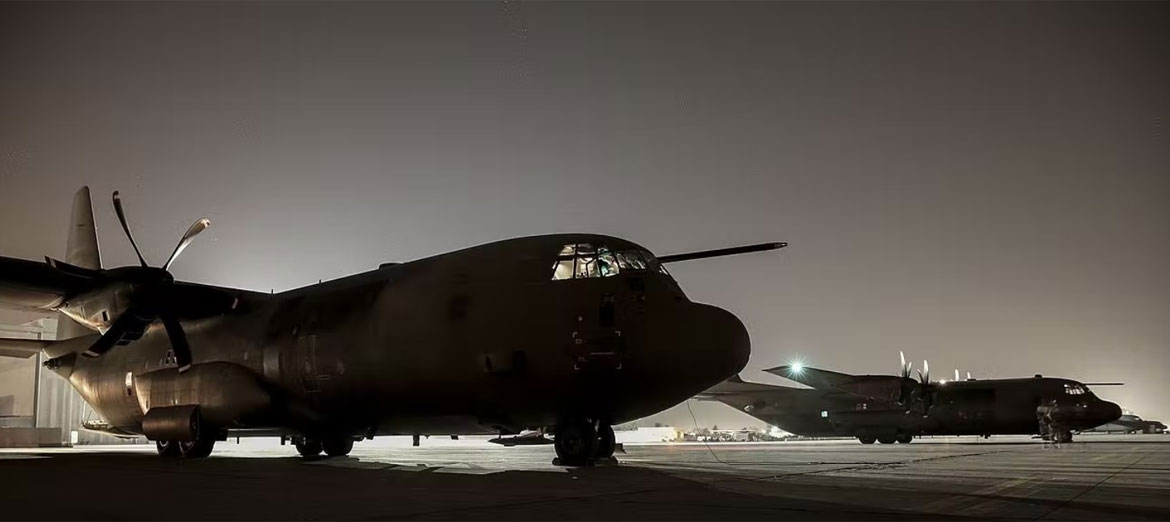
Royal Air Force C-130J Hercules aircraft, which have been supporting Operation SHADER, have returned to RAF Brize Norton after completing over eight years of continuous deployment in support of the coalition commitment to combatting Da’esh.
The role of the Hercules aircraft in transporting personnel and freight in theatre is being transitioned to the A400M Atlas, and both types of aircraft will continue to operate in tandem before the responsibility is fully transferred later this year.
The Hercules aircraft, which has been in service since 1967, has played a vital role in supporting a wide range of UK military and humanitarian relief operations across the globe.
Wing Commander Sjoberg, Officer Commanding 47 Squadron, was quoted here as saying: “It was a great honour to fly home the first RAF Hercules after over eight years of continuous operations in support of the counter-Da’esh fight. The Hercules was central to the first ever Operation SHADER mission, when vital supplies were dropped to the Yazidi people on Mt Sinjar on 9 August 2014. I would like to pay tribute to the hundreds of engineers, aircrew, support staff, industry partners and families of the Hercules force who have supported Operation SHADER non-stop since 2014 – their contribution has been enormous.
"Although one Hercules will remain committed to SHADER until later this year, flying home [Hercules] ZH877 marks the beginning of the changes leading to the aircraft’s retirement in June. Hercules draw down is tinged with sadness for many of us, but it is heartening to see our friends on the Atlas force continuing to deliver on SHADER and increasing their own exciting capabilities every day.”
Wing Commander Bailey, Officer Commanding LXX Squadron, was also quoted: “This is a significant moment for the Atlas Force. As the Detachment Commander for the C130J mission which commenced Operation SHADER on 9 August 2014, I recognise the enormous contribution that the C130J engineers and aircrew have made to underwrite this operation over the past eight years. The Atlas is a great aircraft, and our force is ready to take this task on. We aim to do justice to this proud heritage and the mantle which 47 Squadron leaves behind.”
ukdefencejournal.co.uk
The role of the Hercules aircraft in transporting personnel and freight in theatre is being transitioned to the A400M Atlas, and both types of aircraft will continue to operate in tandem before the responsibility is fully transferred later this year.
The Hercules aircraft, which has been in service since 1967, has played a vital role in supporting a wide range of UK military and humanitarian relief operations across the globe.
Wing Commander Sjoberg, Officer Commanding 47 Squadron, was quoted here as saying: “It was a great honour to fly home the first RAF Hercules after over eight years of continuous operations in support of the counter-Da’esh fight. The Hercules was central to the first ever Operation SHADER mission, when vital supplies were dropped to the Yazidi people on Mt Sinjar on 9 August 2014. I would like to pay tribute to the hundreds of engineers, aircrew, support staff, industry partners and families of the Hercules force who have supported Operation SHADER non-stop since 2014 – their contribution has been enormous.
"Although one Hercules will remain committed to SHADER until later this year, flying home [Hercules] ZH877 marks the beginning of the changes leading to the aircraft’s retirement in June. Hercules draw down is tinged with sadness for many of us, but it is heartening to see our friends on the Atlas force continuing to deliver on SHADER and increasing their own exciting capabilities every day.”
Wing Commander Bailey, Officer Commanding LXX Squadron, was also quoted: “This is a significant moment for the Atlas Force. As the Detachment Commander for the C130J mission which commenced Operation SHADER on 9 August 2014, I recognise the enormous contribution that the C130J engineers and aircrew have made to underwrite this operation over the past eight years. The Atlas is a great aircraft, and our force is ready to take this task on. We aim to do justice to this proud heritage and the mantle which 47 Squadron leaves behind.”
ukdefencejournal.co.uk

From: George Graves, Carlisle, Cumbria
Subject: First posting following the Movements School
Hi Tony,
Like you, I completed my my movements course in 1966 and most of the class, just like yours, were posted to Aden or other Middle East posts (including your old mate, Pete Harper).
So, what a pleasant surprise I got when told I was posted to RAF Seletar in Singapore and on to FEAF MAMS for two and a half years. I soon got into the MAMS way of work-hard play-hard. I can honestly say that was my best ever RAF posting.
Regards
George
Subject: First posting following the Movements School
Hi Tony,
Like you, I completed my my movements course in 1966 and most of the class, just like yours, were posted to Aden or other Middle East posts (including your old mate, Pete Harper).
So, what a pleasant surprise I got when told I was posted to RAF Seletar in Singapore and on to FEAF MAMS for two and a half years. I soon got into the MAMS way of work-hard play-hard. I can honestly say that was my best ever RAF posting.
Regards
George
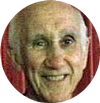

From: Wade Seymour, Kingston, NS
Subject: First posting following the Movements School
Hi Tony,
I remember at CFB Cornwallis when we were about to graduate from our TQ3 course, we were brought into a room with one of the instructors who had a list of postings. The order that we were brought in was by how we were doing on the course from 1st to 20th.
I was in the middle and I wanted to be posted back to the Maritimes. The only posting available was Cornwallis, where we had just finished our Basic Training. I took Cornwallis and the guys on my course really gave me a ribbing; but as it turned out it was the best posting I had in my career!
Wade
Subject: First posting following the Movements School
Hi Tony,
I remember at CFB Cornwallis when we were about to graduate from our TQ3 course, we were brought into a room with one of the instructors who had a list of postings. The order that we were brought in was by how we were doing on the course from 1st to 20th.
I was in the middle and I wanted to be posted back to the Maritimes. The only posting available was Cornwallis, where we had just finished our Basic Training. I took Cornwallis and the guys on my course really gave me a ribbing; but as it turned out it was the best posting I had in my career!
Wade


Derby Day for Australian Defence
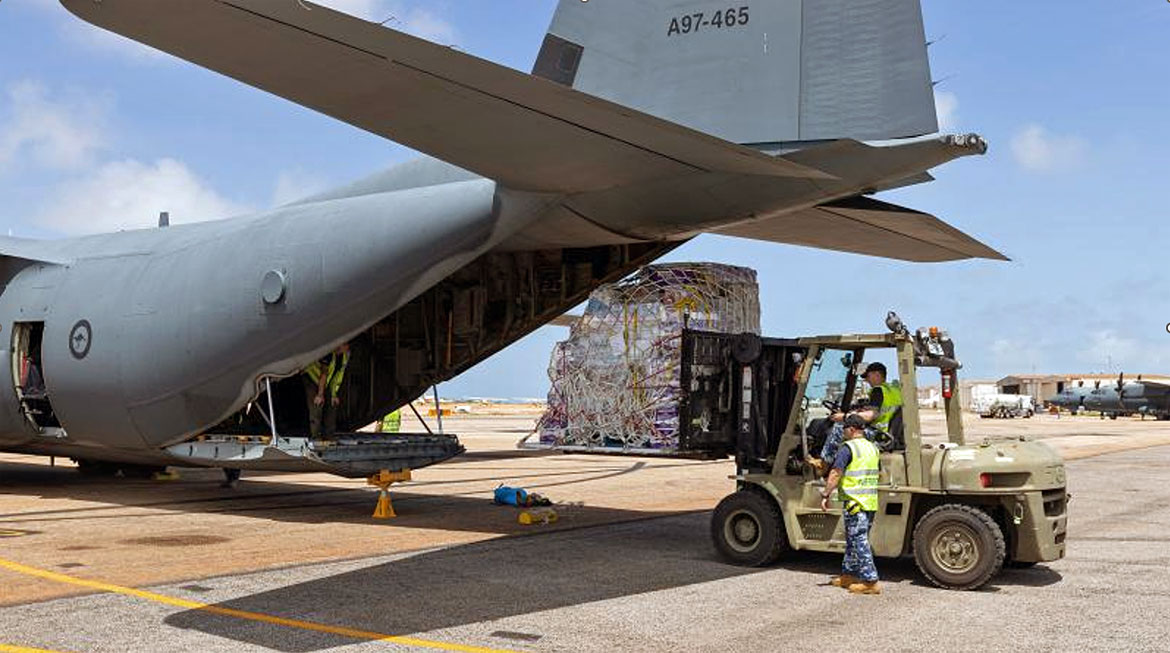
Defence planes have transported more than 20 tonnes of food and supplies from Broome into the isolated town of Derby in Western Australia following a priority request from the WA Department of Fire and Emergency Services. Roads into the town have been cut off by severe flooding that occurred in the aftermath of Ex-Tropical Cyclone Ellie, resulting in food supplies being critically low in the town. Local transport providers in Broome and in Derby worked with Defence crews to load and unload the food supplies throughout the day.
Deputy Commander of the Task Element Flying Officer Amie Ballon said that there had been challenges to overcome to transport the stores, particularly the cold and frozen foods. “The cold stores needed to be moved fridge-to-fridge within a time limit of two hours, so there was a logistical piece where we had to get goods to and from the aircraft and load them onto the fridge at the other end within that timeframe,” she said.
A second logistical challenge was to coordinate a high volume of Defence aircraft traffic with only a limited amount of space on the Broome airport apron. As well as the C-130J Hercules and C-27J Spartan aircraft delivering food stores, three Army MRH-90 Taipan and two CH-47 Chinook helicopters were also using the tarmac, while a C-17A Globemaster landed to deliver equipment to Broome.
Despite the challenges for the RAAF crews and ground staff, Flying Officer Ballon said all members of the team had been happy to assist. “These are real-time emergency services that we are providing. We are learning lots on the go and everybody is really happy to be here in order to facilitate this for the WA government,” she said.
defence.gov.au
Deputy Commander of the Task Element Flying Officer Amie Ballon said that there had been challenges to overcome to transport the stores, particularly the cold and frozen foods. “The cold stores needed to be moved fridge-to-fridge within a time limit of two hours, so there was a logistical piece where we had to get goods to and from the aircraft and load them onto the fridge at the other end within that timeframe,” she said.
A second logistical challenge was to coordinate a high volume of Defence aircraft traffic with only a limited amount of space on the Broome airport apron. As well as the C-130J Hercules and C-27J Spartan aircraft delivering food stores, three Army MRH-90 Taipan and two CH-47 Chinook helicopters were also using the tarmac, while a C-17A Globemaster landed to deliver equipment to Broome.
Despite the challenges for the RAAF crews and ground staff, Flying Officer Ballon said all members of the team had been happy to assist. “These are real-time emergency services that we are providing. We are learning lots on the go and everybody is really happy to be here in order to facilitate this for the WA government,” she said.
defence.gov.au

From: Philip “Nobby” Clarke, Swaffam, Norfolk
Subject: First posting after Movements School
Hi Tony,
A bit of history before the Movements School. I joined up at RAF Hereford 8th September 1966, passed out on 11th August 1967 and was posted to RAF North Luffenham as a Supplier General. I spent 2 1/2 years before my Movements Course at RAF Abingdon, 106 JAMC 26th January 1970 to 20th March 1970.
Then I was off to RAF Lyneham to catch a Comet to RAF Akrotiri where I worked in the cargo shed on Bravo Pad. It was a great tour in Cyprus for 2 1/2 years and spent my 21st birthday in Cyprus. A lot of great memories and made some great mates.
Cheers!
Nobby
Subject: First posting after Movements School
Hi Tony,
A bit of history before the Movements School. I joined up at RAF Hereford 8th September 1966, passed out on 11th August 1967 and was posted to RAF North Luffenham as a Supplier General. I spent 2 1/2 years before my Movements Course at RAF Abingdon, 106 JAMC 26th January 1970 to 20th March 1970.
Then I was off to RAF Lyneham to catch a Comet to RAF Akrotiri where I worked in the cargo shed on Bravo Pad. It was a great tour in Cyprus for 2 1/2 years and spent my 21st birthday in Cyprus. A lot of great memories and made some great mates.
Cheers!
Nobby


From: Andy Kay, Bowling Green, KY
Subject: First posting following the Movements School
Hi Tony,
I'm pretty sure that when I went through in '73 and did my basic Movements course it was called the Air Movements Training School but later changed to RAF Movements School - is that right? [Yes Andy – you are correct sir! It was changed from AMTS back to the original name at Kidbrooke in 1954, RAF Movements School - RAFMS].
Anyway, "Join the RAF and see the world" they said in the recruiting office. However, on passing out of the school I was posted to RAF Northolt, which being on the Central Line of the London Underground, was approximately an hour from Mum and Dad with only a single change to the District Line and onwards to sunny East Ham in the depths of East London. See the world my arse. On the plus side, I could nip home whenever I was off shift and get Mum to do all my laundry for me. Win.
Northolt, for those that never enjoyed it, was not a bad posting. The work was easy, everything was done in best blues of course because of the VIP movements which were the bread and butter of the station, and we got to meet (or at least eyeball) some high ranking people in the services and government. Busiest destination consisted of 2 or 3 flights a day heading over to Aldergrove, some of them with very odd passengers indeed. Not as exciting as many, but I'm pretty sure in my time nobody passed out of the AMTS and went directly overseas, only to 3 or 4 stations in the UK, the most exotic of which was Thorney Island for a couple of blokes.
Regards,
Andy
Subject: First posting following the Movements School
Hi Tony,
I'm pretty sure that when I went through in '73 and did my basic Movements course it was called the Air Movements Training School but later changed to RAF Movements School - is that right? [Yes Andy – you are correct sir! It was changed from AMTS back to the original name at Kidbrooke in 1954, RAF Movements School - RAFMS].
Anyway, "Join the RAF and see the world" they said in the recruiting office. However, on passing out of the school I was posted to RAF Northolt, which being on the Central Line of the London Underground, was approximately an hour from Mum and Dad with only a single change to the District Line and onwards to sunny East Ham in the depths of East London. See the world my arse. On the plus side, I could nip home whenever I was off shift and get Mum to do all my laundry for me. Win.
Northolt, for those that never enjoyed it, was not a bad posting. The work was easy, everything was done in best blues of course because of the VIP movements which were the bread and butter of the station, and we got to meet (or at least eyeball) some high ranking people in the services and government. Busiest destination consisted of 2 or 3 flights a day heading over to Aldergrove, some of them with very odd passengers indeed. Not as exciting as many, but I'm pretty sure in my time nobody passed out of the AMTS and went directly overseas, only to 3 or 4 stations in the UK, the most exotic of which was Thorney Island for a couple of blokes.
Regards,
Andy


British Atlas force conducts training in Norway
A team of experienced instructors from XXIV Squadron, consisting of a Qualified Flying Instructor and a Qualified Mission Aircrew Instructor, provided support to an LXX crew during one of their first missions operating the A400M Atlas aircraft. The mission involved a return journey from RAF Brize Norton to Bardufoss in Norway, in support of Exercises JOINT VIKING and AQUILA ENABLER, say the RAF in a news release.
The aircraft transported a team of Movers from the Air Movements Squadron, a pair of RAF Police Dog Handlers with their Military Working Dogs, and exercise freight.
Flight Lieutenant Robinson, LXX Squadron Junior Pilot, was quoted as saying: “Flying the Atlas into Norway for the first time as a Junior Pilot is an unforgettable experience. As part of the Operational Conversion Unit (OCU), we train for cold weather operations in the simulator. This training is invaluable and makes for a seamless transition from the simulator to flying the aircraft into Bardufoss for the first time. What the simulator does not prepare you for, is how breath-taking the Norwegian landscape really is!”
Upon graduation from initial training on XXIV Squadron, A400M Atlas crews are capable of supporting global air transport operations in their new roles on 30 or LXX Squadrons. As their experience grows, they may receive additional support from XXIV Squadron instructors when operating in challenging locations, to assist in their ongoing development.
This specific mission, say the Royal Air Force, presented the junior crew with an opportunity to operate in an extreme cold weather environment, with icy runways and taxiways, testing their aircraft handling, technical knowledge, and pre-flight planning abilities. The training provided on this route is invaluable in preparing Air Mobility Force aircrew for future worldwide operations, they added.
ukdefencejournal.co.uk
The aircraft transported a team of Movers from the Air Movements Squadron, a pair of RAF Police Dog Handlers with their Military Working Dogs, and exercise freight.
Flight Lieutenant Robinson, LXX Squadron Junior Pilot, was quoted as saying: “Flying the Atlas into Norway for the first time as a Junior Pilot is an unforgettable experience. As part of the Operational Conversion Unit (OCU), we train for cold weather operations in the simulator. This training is invaluable and makes for a seamless transition from the simulator to flying the aircraft into Bardufoss for the first time. What the simulator does not prepare you for, is how breath-taking the Norwegian landscape really is!”
Upon graduation from initial training on XXIV Squadron, A400M Atlas crews are capable of supporting global air transport operations in their new roles on 30 or LXX Squadrons. As their experience grows, they may receive additional support from XXIV Squadron instructors when operating in challenging locations, to assist in their ongoing development.
This specific mission, say the Royal Air Force, presented the junior crew with an opportunity to operate in an extreme cold weather environment, with icy runways and taxiways, testing their aircraft handling, technical knowledge, and pre-flight planning abilities. The training provided on this route is invaluable in preparing Air Mobility Force aircrew for future worldwide operations, they added.
ukdefencejournal.co.uk
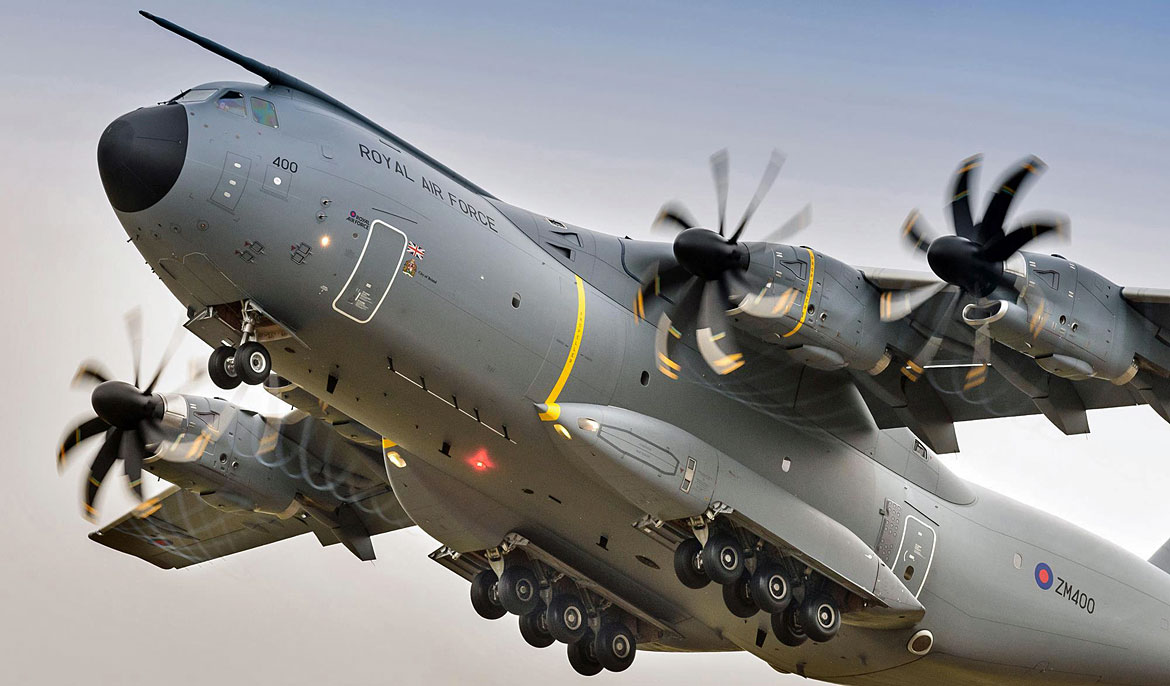

From: Barry Tappenden, Shortstown, Beds
Subject: First posting following the Movements School
Good evening Tony,
Nothing quite so exciting as going to Aden, my first posting following the Air Movements School was to RAF Lyneham and joining Blue Shift. If memory serves, I was at home on leave for Christmas when my father took the telephone call for me to return to duty ASAP.
If you can recall, December 1963 was a bit “dodgy” weather-wise and so my father (ex Army, member of the famous Coup de Main) insisted on driving me back to Lyneham through some really bad conditions in his Skoda! (Heating didn’t work). I made it safely and so did my Dad on the return trip. Lots of the Movements lads didn’t make it so it was left to a few of us to load the Britannias (Whispering Giants) by ourselves for the troop movements to Cyprus.
Towards the end of the year I would be sent to the Far East to join FEAF MAMS.
Barry
Subject: First posting following the Movements School
Good evening Tony,
Nothing quite so exciting as going to Aden, my first posting following the Air Movements School was to RAF Lyneham and joining Blue Shift. If memory serves, I was at home on leave for Christmas when my father took the telephone call for me to return to duty ASAP.
If you can recall, December 1963 was a bit “dodgy” weather-wise and so my father (ex Army, member of the famous Coup de Main) insisted on driving me back to Lyneham through some really bad conditions in his Skoda! (Heating didn’t work). I made it safely and so did my Dad on the return trip. Lots of the Movements lads didn’t make it so it was left to a few of us to load the Britannias (Whispering Giants) by ourselves for the troop movements to Cyprus.
Towards the end of the year I would be sent to the Far East to join FEAF MAMS.
Barry


From: Brian Everett, Darlington, County Durham
Subject: First posting following the Movements School
Hi Tony,
This was to be my third tour after having been commissioned. The first was at the Central Signals Establishment at RAF Watton, in Norfolk and the second at a nuclear weapons establishment. However, I had previously been out in Malaya as a National Serviceman in the early 1950s.
In the Spring of 1961, I was sent down to Kidbrooke in South London to attend the Movements Course, which in those days covered all aspects of road/rail, shipping, and air movements. At the end of this training I found myself on the way to Khormaksar, Aden, where I arrived after 13 hours in a very cramped Britannia aircraft. My arrival was totally unexpected by the admin staff and Movements Squadron alike, which meant hanging around in UK civilian clothes in the mid-day sun with temperatures in excess of 39ºC... ah, the days before air conditioning, HR and all those other pleasantries! After finding a bed, and dumping what kit I had with me, this was also the time when the KD uniform for such places was akin to hessian sacking, supplied by Moss Bros at exorbitant prices. I was then informed, that I was on shift the following day – 12 hrs on/12 off.
The airfield at RAF Khormaksar at that time was the busiest in the world and was heavily overcrowded. It was at the hub of air routes to the Far East, to Africa, and the Gulf and was therefore an essential element in protecting British trade routes and interests in the area. In addition to the nine operational squadrons, fighter, bomber, maritime, reconnaissance and transport aircraft, the base provided essential facilities for many transiting aircraft, including simultaneous quick turnrounds (QTRs) in which passenger aircraft had to be serviced, refuelled, replenished in less than 2 hours, whilst the passengers, were off the aircraft. The most sensitive of these aircraft were the ‘hot loads’ with nuclear cargo destined for testing grounds in Australia. It was not unusual for us to be dealing with up to 20 transport aircraft in a single night.
It was into this setting that I was launched as a ‘rookie mover’. One of two officers on the same shift. Unfortunately, this was not to be the case with me for this first shift. No sooner had we started then we lost the number one, John Coles, the Flying Officer heading the team. He was supervising the loading of a bomb trolley onto a Beverley aircraft by local Arab labourers when the restraining chains gave way (or so it was alleged) resulting in his leg being broken. Whilst I was sorting this problem out, one of the labourers in a separate section of the team, loading the mail onto a Britannia, fell and broke his back. I spent the following day (without sleep) going from one Board of Enquiry to the other, before going back on shift. Hardly the best of introductions to Air Movements but one you quickly learn from, and never forget.
Brian
Subject: First posting following the Movements School
Hi Tony,
This was to be my third tour after having been commissioned. The first was at the Central Signals Establishment at RAF Watton, in Norfolk and the second at a nuclear weapons establishment. However, I had previously been out in Malaya as a National Serviceman in the early 1950s.
In the Spring of 1961, I was sent down to Kidbrooke in South London to attend the Movements Course, which in those days covered all aspects of road/rail, shipping, and air movements. At the end of this training I found myself on the way to Khormaksar, Aden, where I arrived after 13 hours in a very cramped Britannia aircraft. My arrival was totally unexpected by the admin staff and Movements Squadron alike, which meant hanging around in UK civilian clothes in the mid-day sun with temperatures in excess of 39ºC... ah, the days before air conditioning, HR and all those other pleasantries! After finding a bed, and dumping what kit I had with me, this was also the time when the KD uniform for such places was akin to hessian sacking, supplied by Moss Bros at exorbitant prices. I was then informed, that I was on shift the following day – 12 hrs on/12 off.
The airfield at RAF Khormaksar at that time was the busiest in the world and was heavily overcrowded. It was at the hub of air routes to the Far East, to Africa, and the Gulf and was therefore an essential element in protecting British trade routes and interests in the area. In addition to the nine operational squadrons, fighter, bomber, maritime, reconnaissance and transport aircraft, the base provided essential facilities for many transiting aircraft, including simultaneous quick turnrounds (QTRs) in which passenger aircraft had to be serviced, refuelled, replenished in less than 2 hours, whilst the passengers, were off the aircraft. The most sensitive of these aircraft were the ‘hot loads’ with nuclear cargo destined for testing grounds in Australia. It was not unusual for us to be dealing with up to 20 transport aircraft in a single night.
It was into this setting that I was launched as a ‘rookie mover’. One of two officers on the same shift. Unfortunately, this was not to be the case with me for this first shift. No sooner had we started then we lost the number one, John Coles, the Flying Officer heading the team. He was supervising the loading of a bomb trolley onto a Beverley aircraft by local Arab labourers when the restraining chains gave way (or so it was alleged) resulting in his leg being broken. Whilst I was sorting this problem out, one of the labourers in a separate section of the team, loading the mail onto a Britannia, fell and broke his back. I spent the following day (without sleep) going from one Board of Enquiry to the other, before going back on shift. Hardly the best of introductions to Air Movements but one you quickly learn from, and never forget.
Brian

From: Roger Gough, Dubai
Subject: Aden Today
Hi Tony,
I've just been to Aden Airport in Yemen. It was before my time, but I understand that it used to be RAF Khormaksar - the largest RAF station in the world. I've included some photographs of the airfield and surroundings that might bring back memories for some. One of the only places that wants the UK to colonise it again; so poor…
Subject: Aden Today
Hi Tony,
I've just been to Aden Airport in Yemen. It was before my time, but I understand that it used to be RAF Khormaksar - the largest RAF station in the world. I've included some photographs of the airfield and surroundings that might bring back memories for some. One of the only places that wants the UK to colonise it again; so poor…
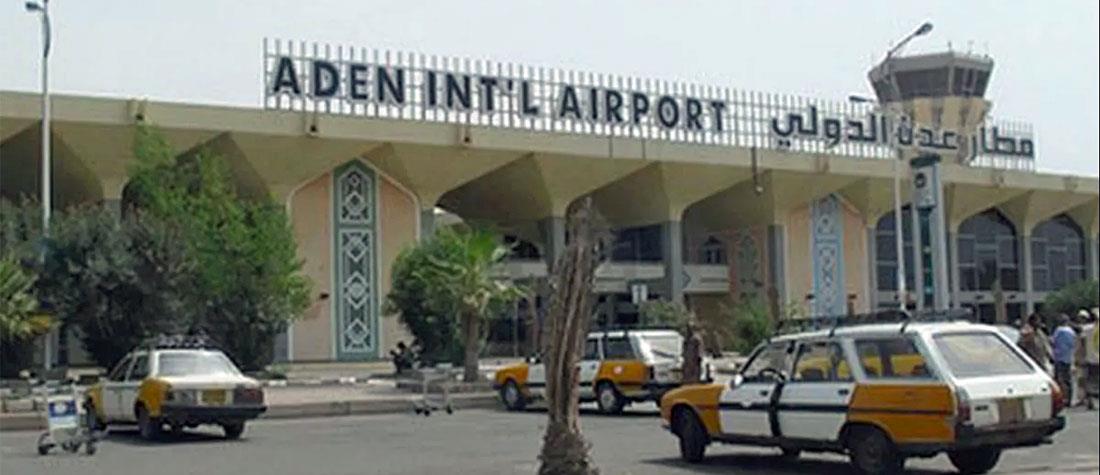

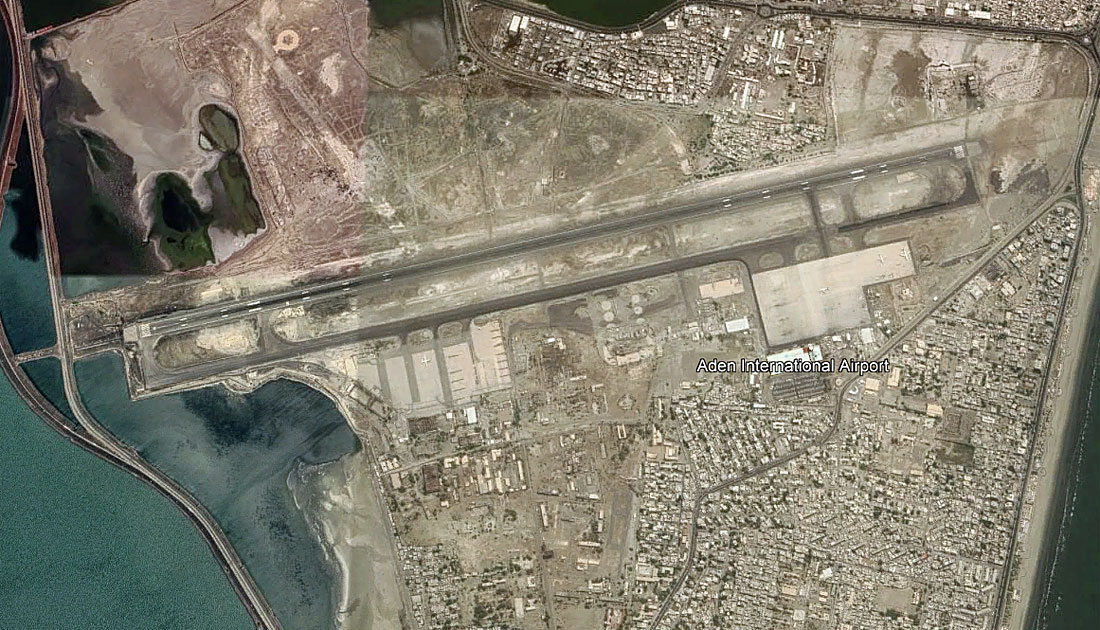
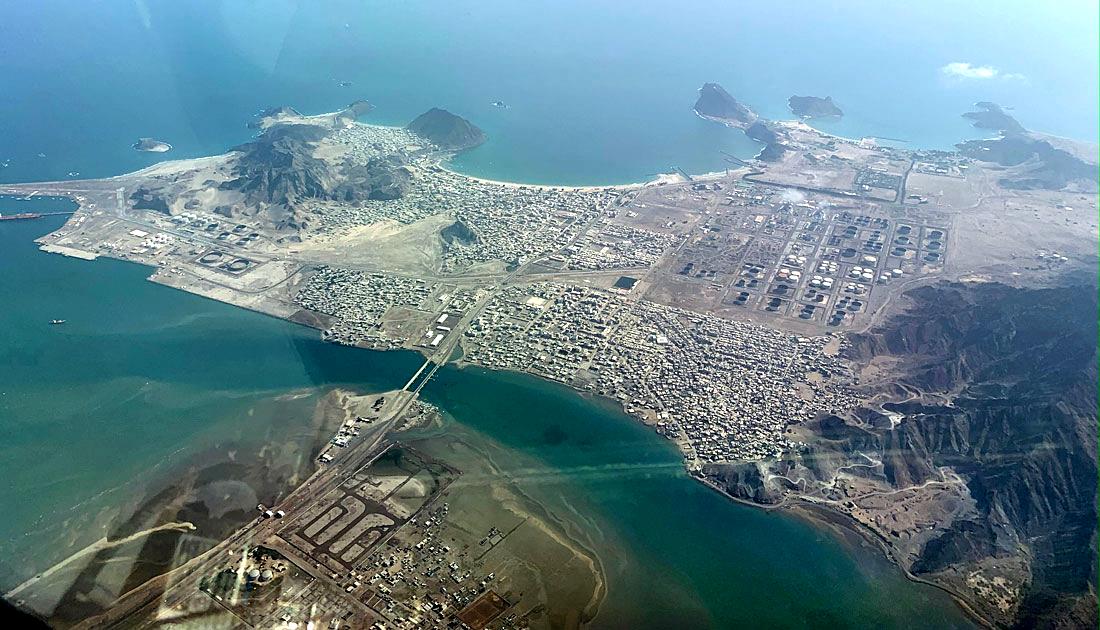
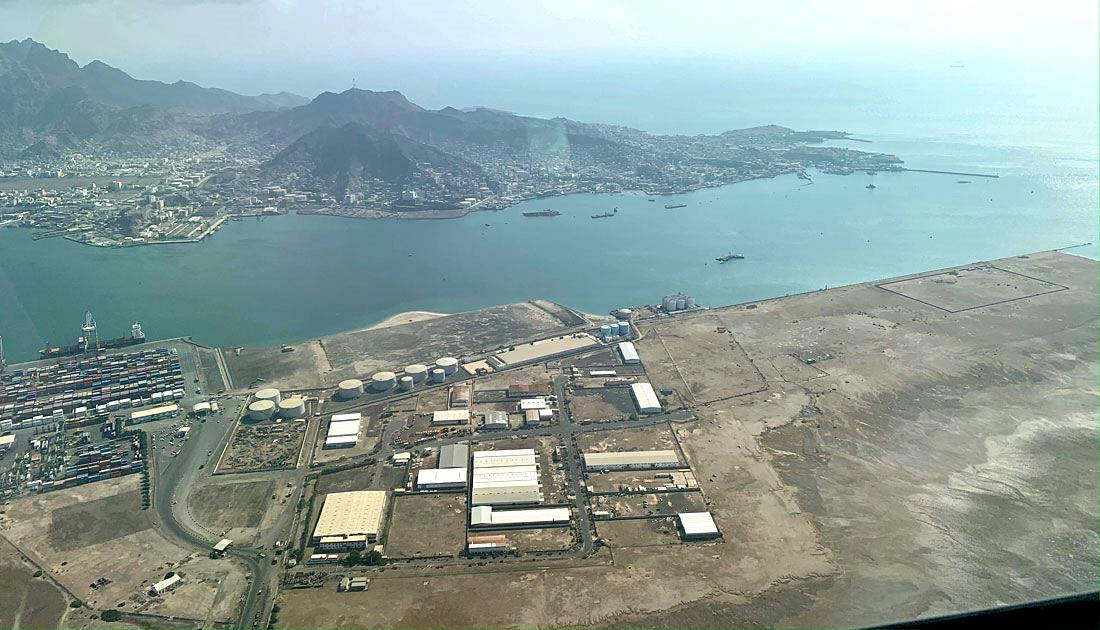
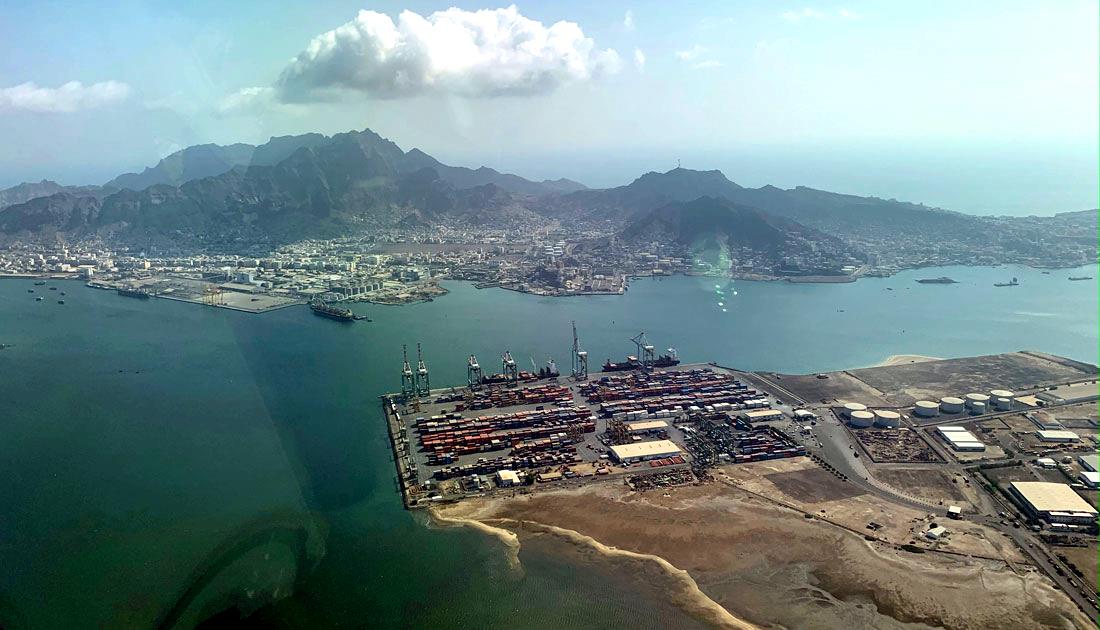
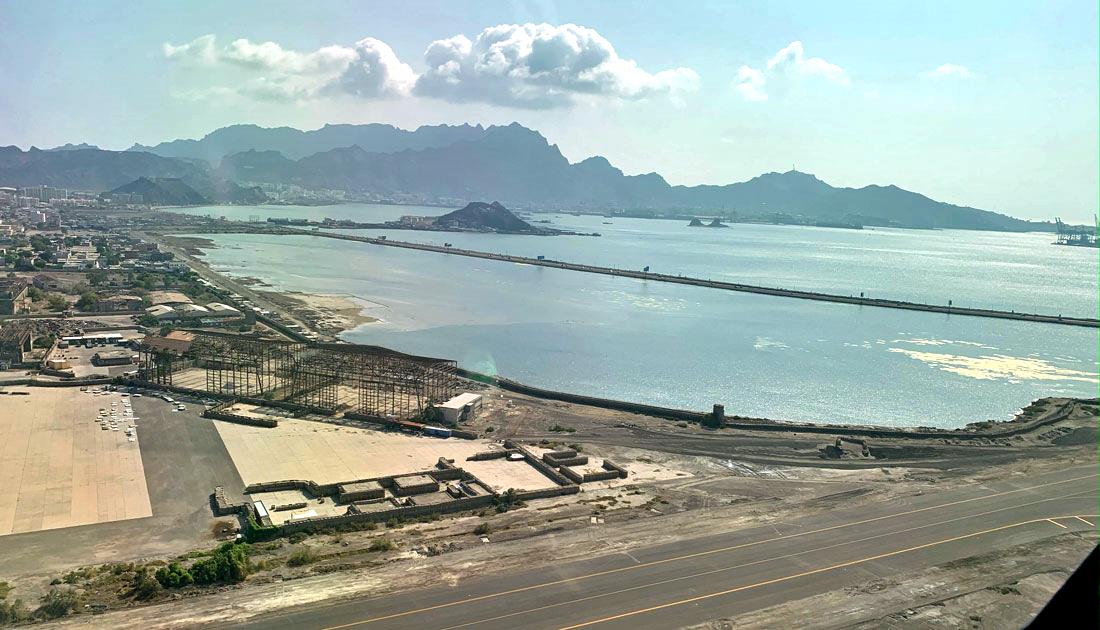
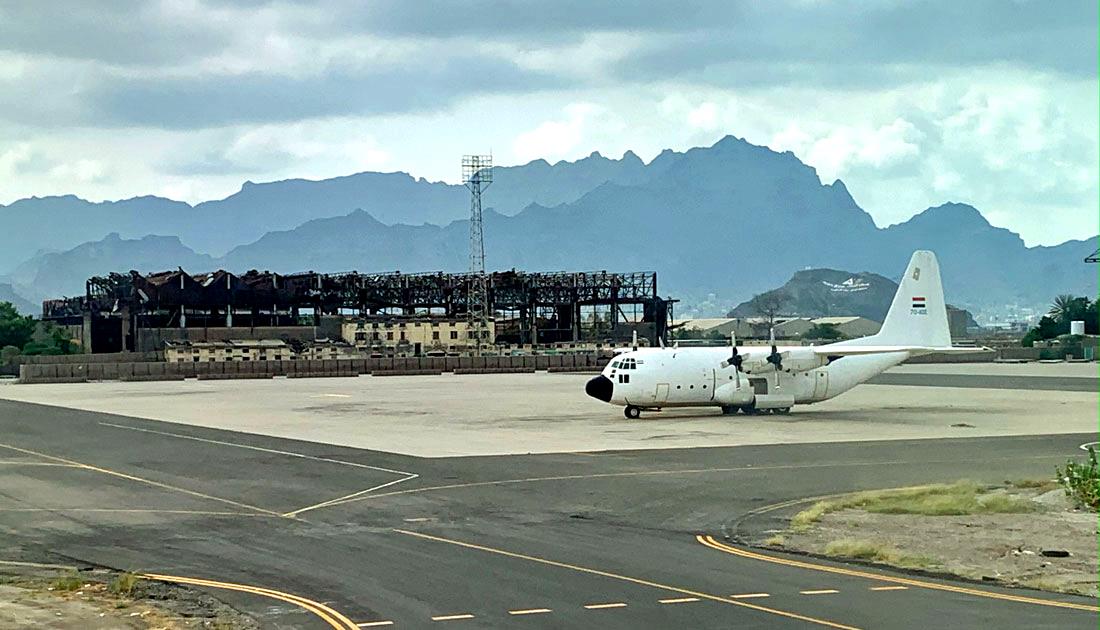
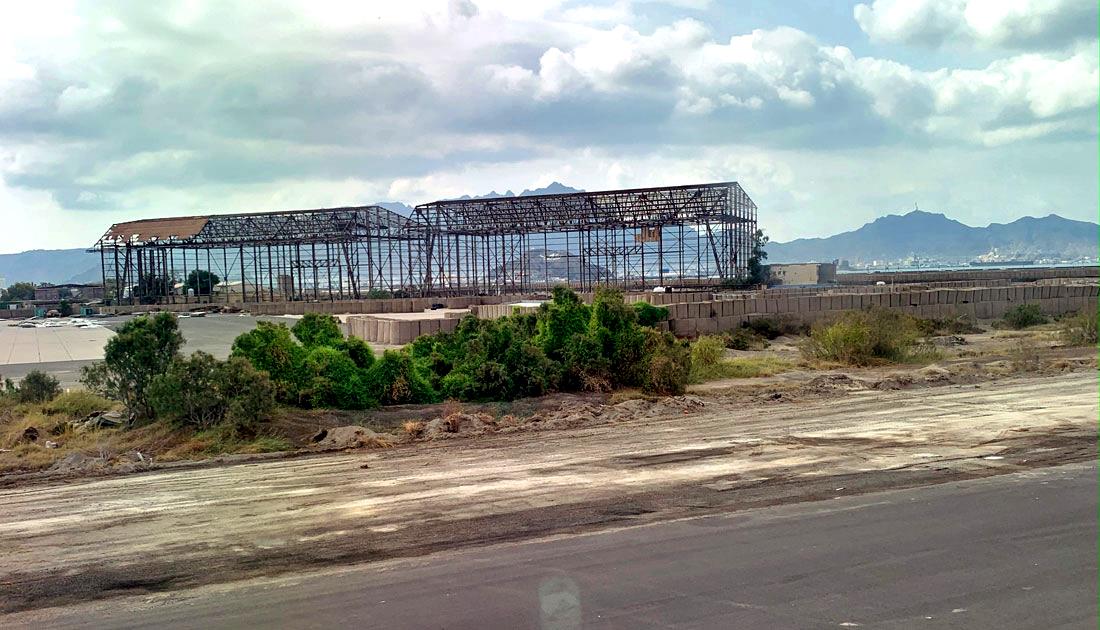
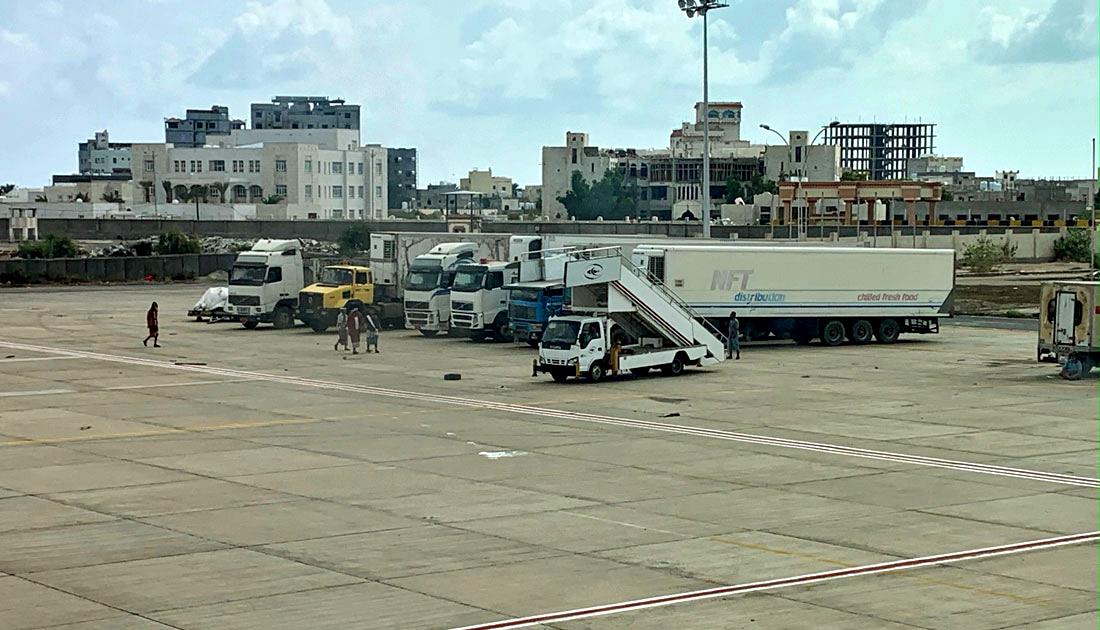
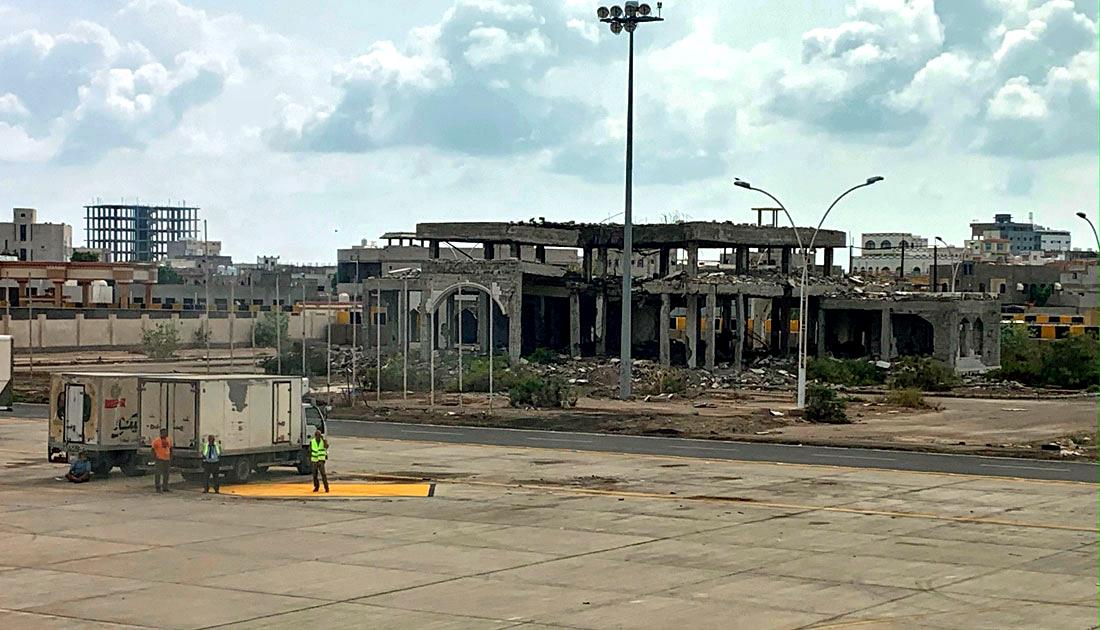
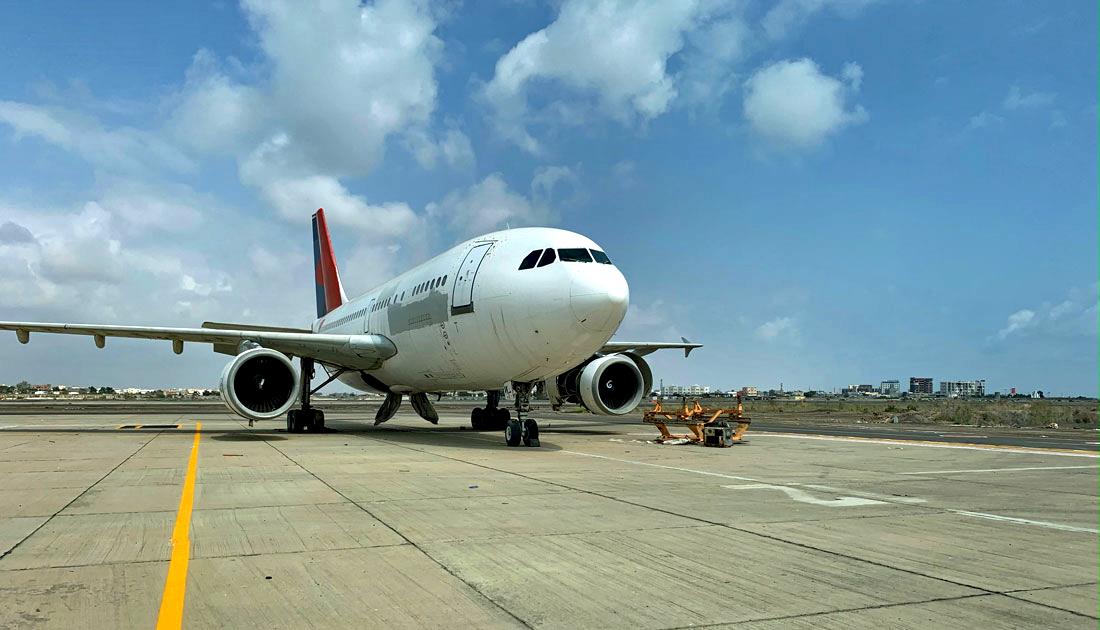
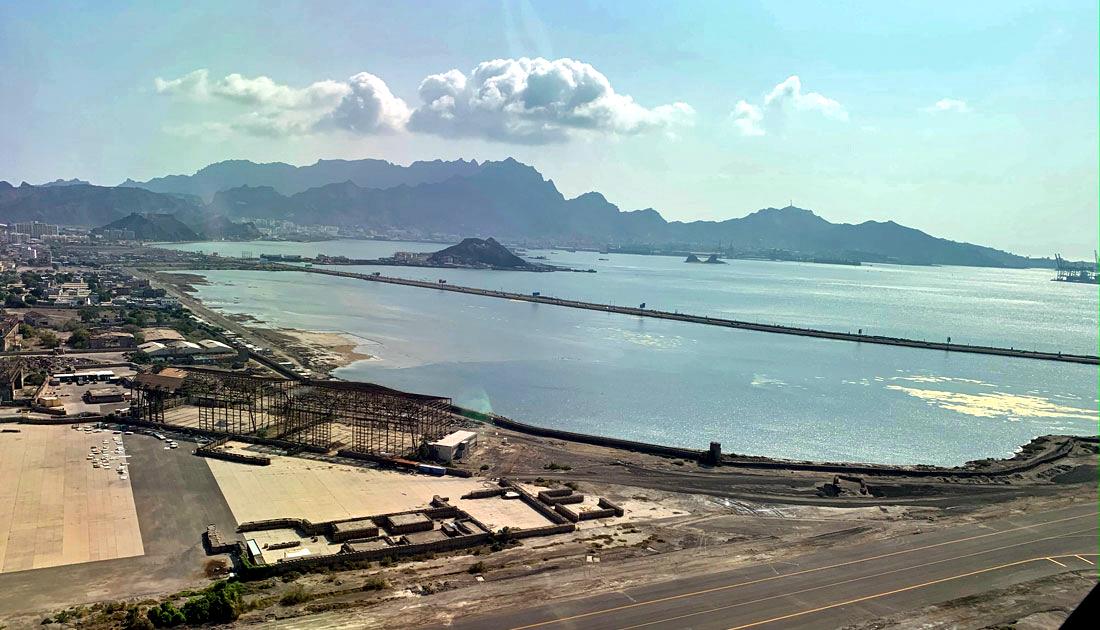
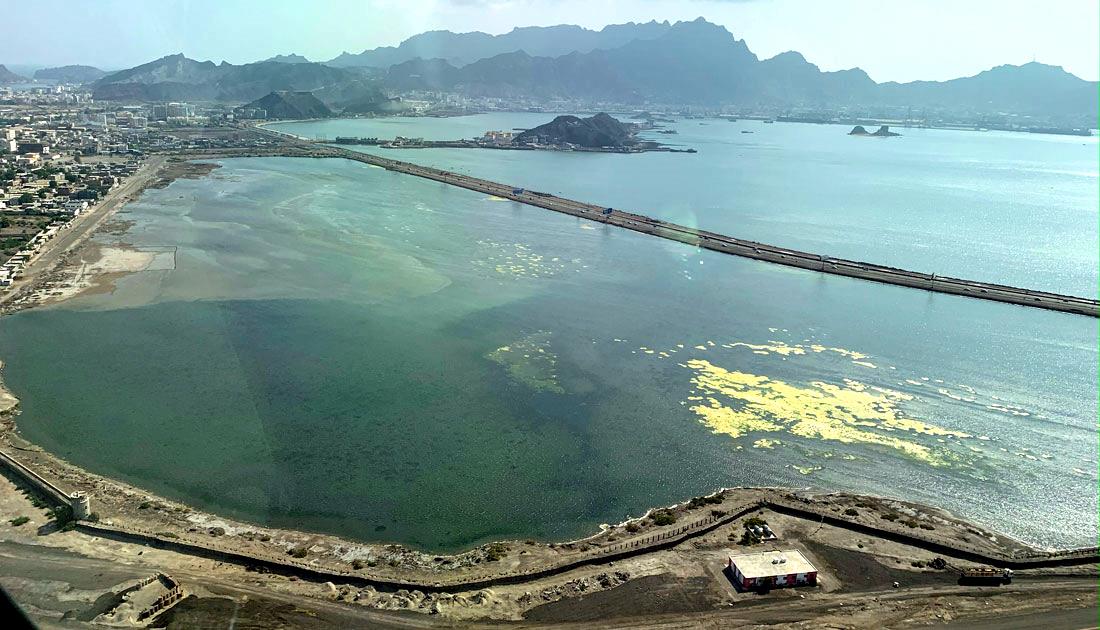
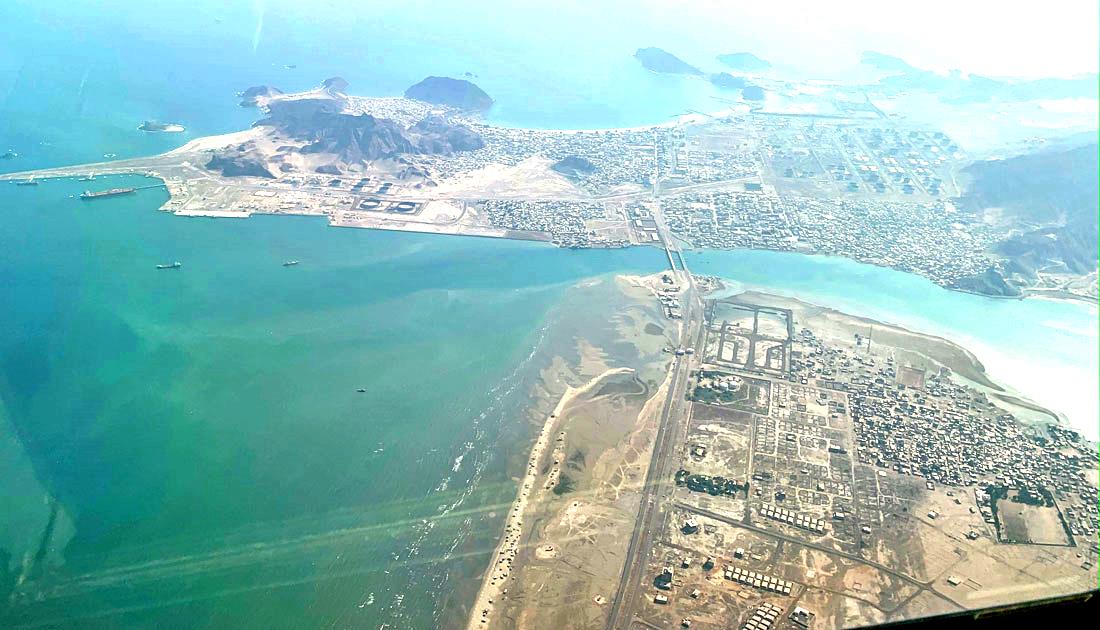
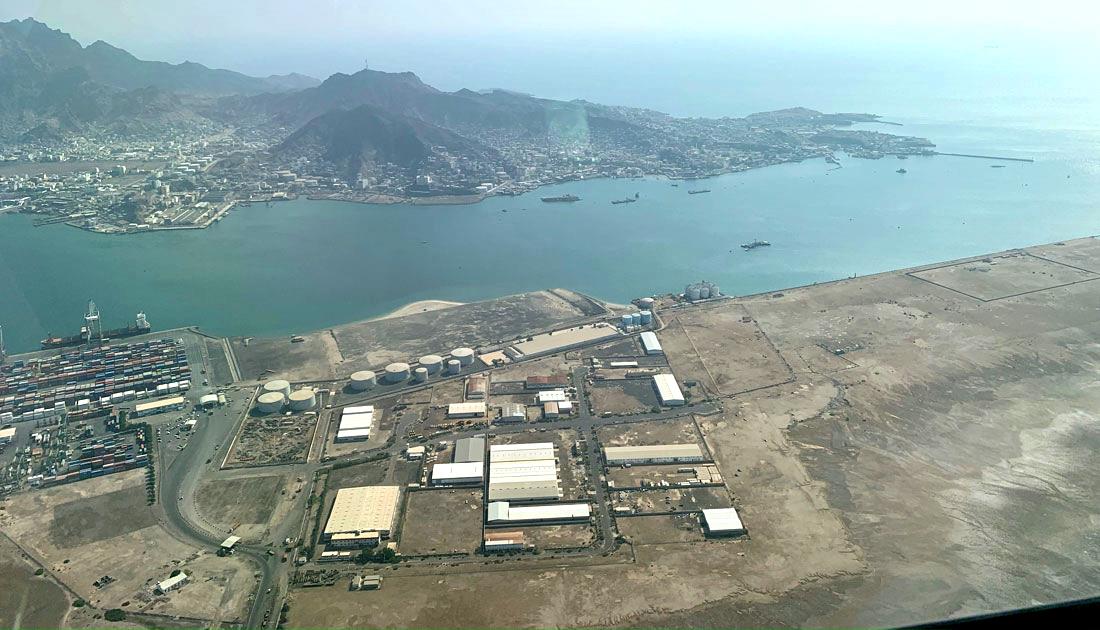
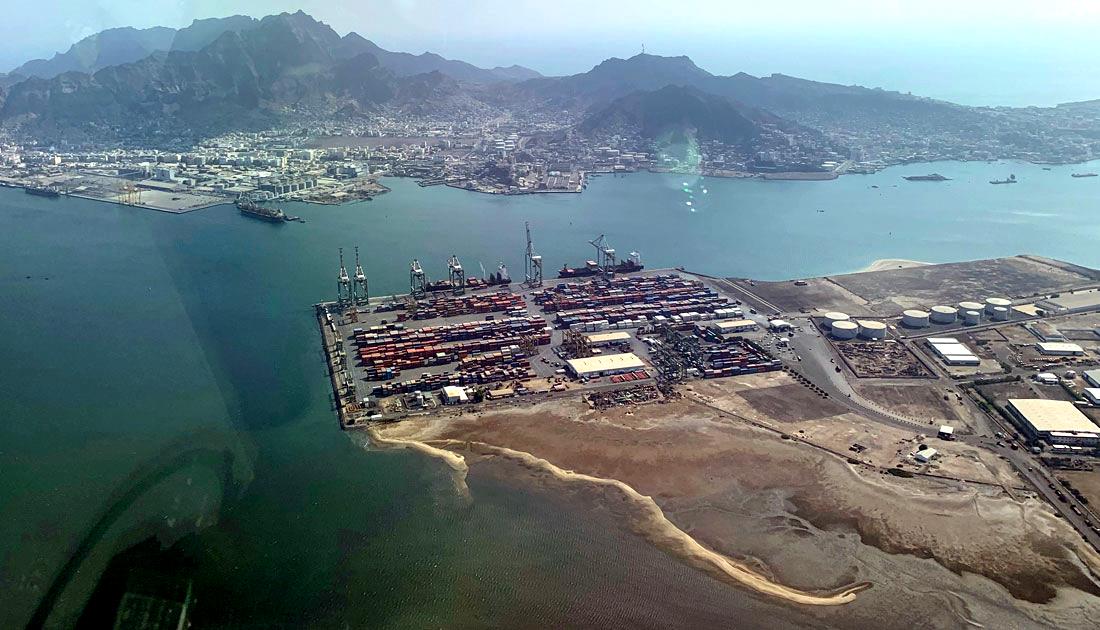
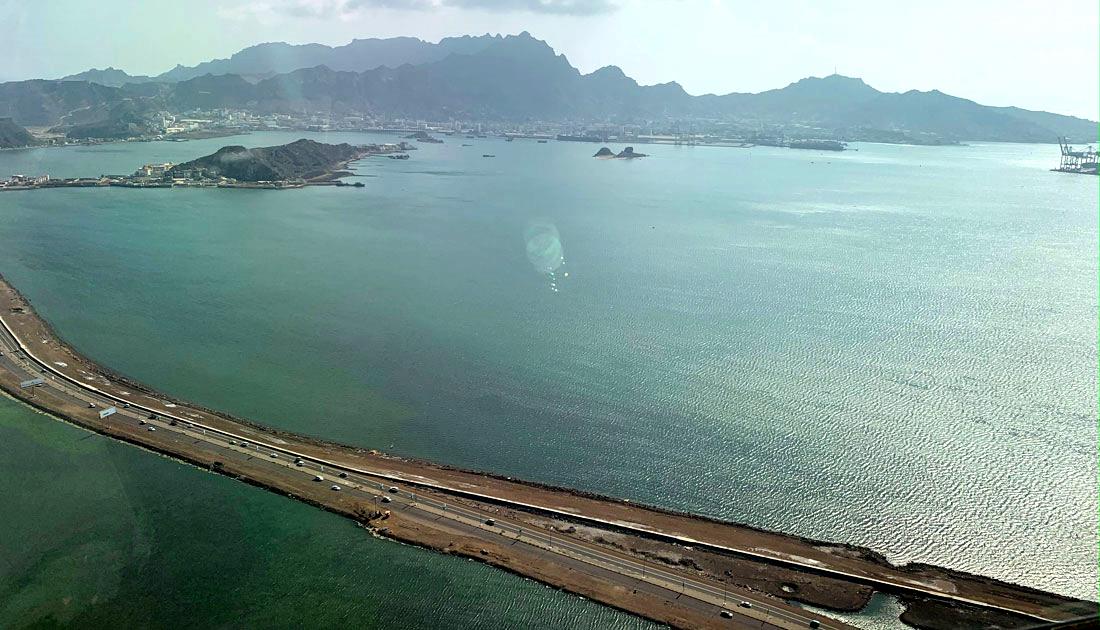
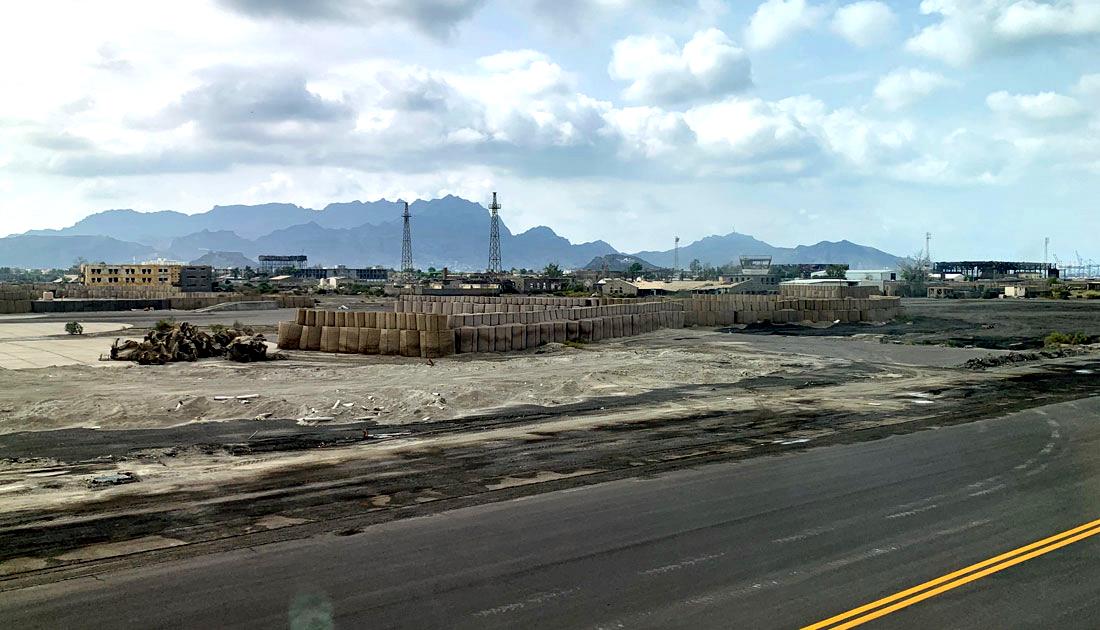
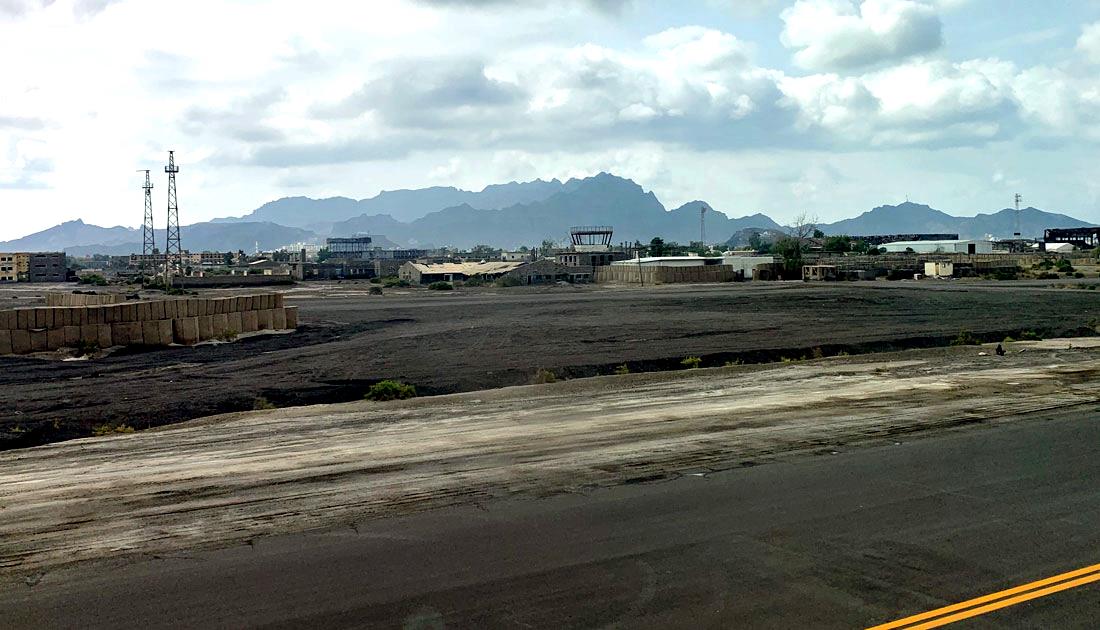
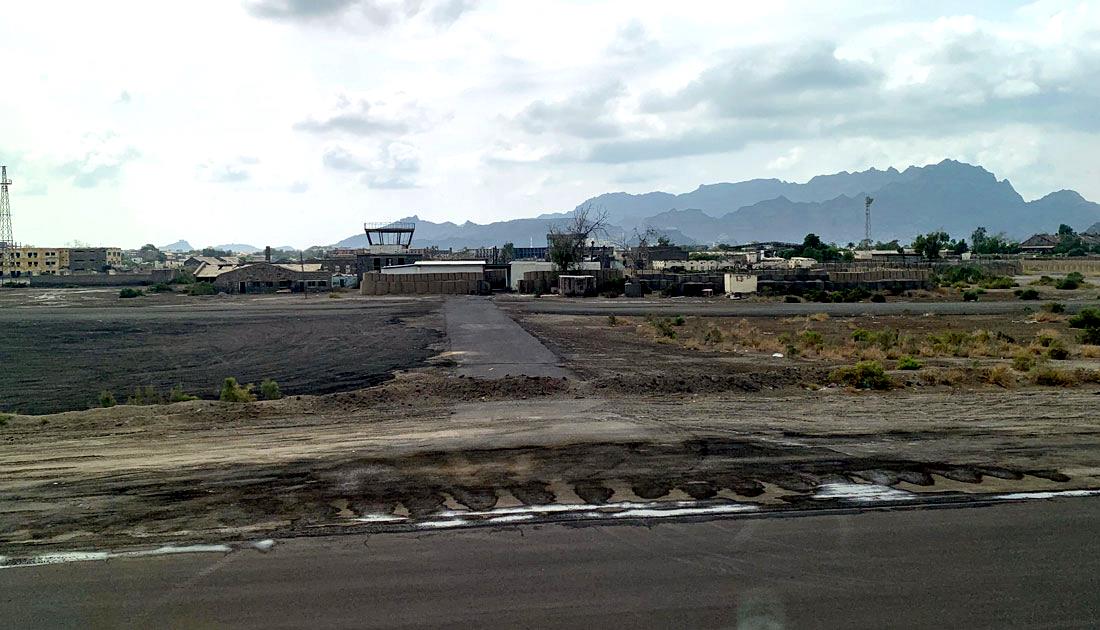
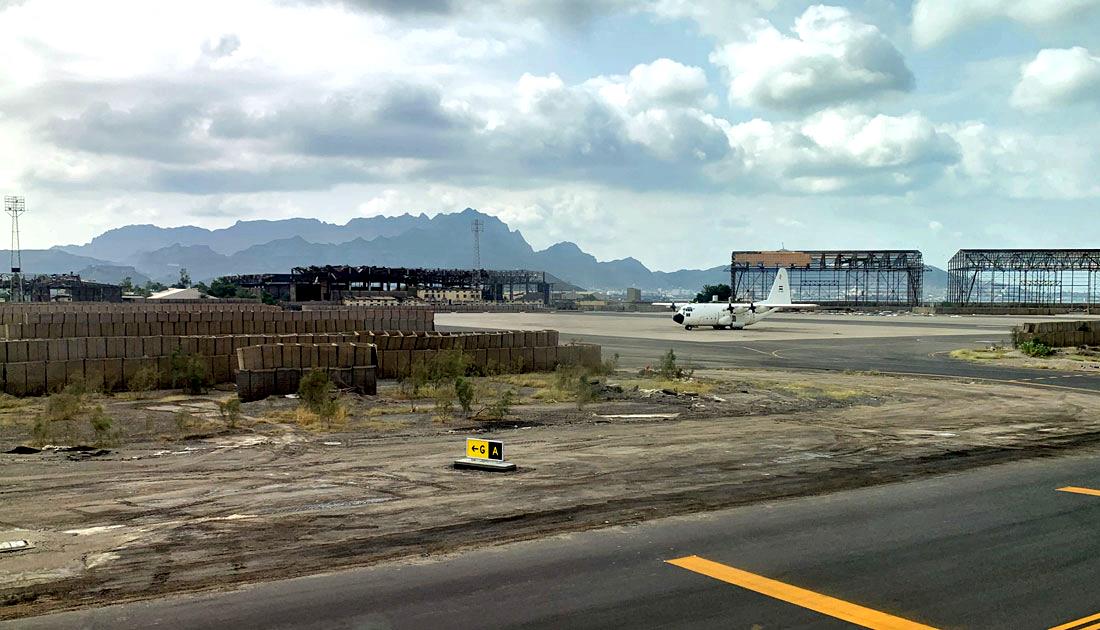
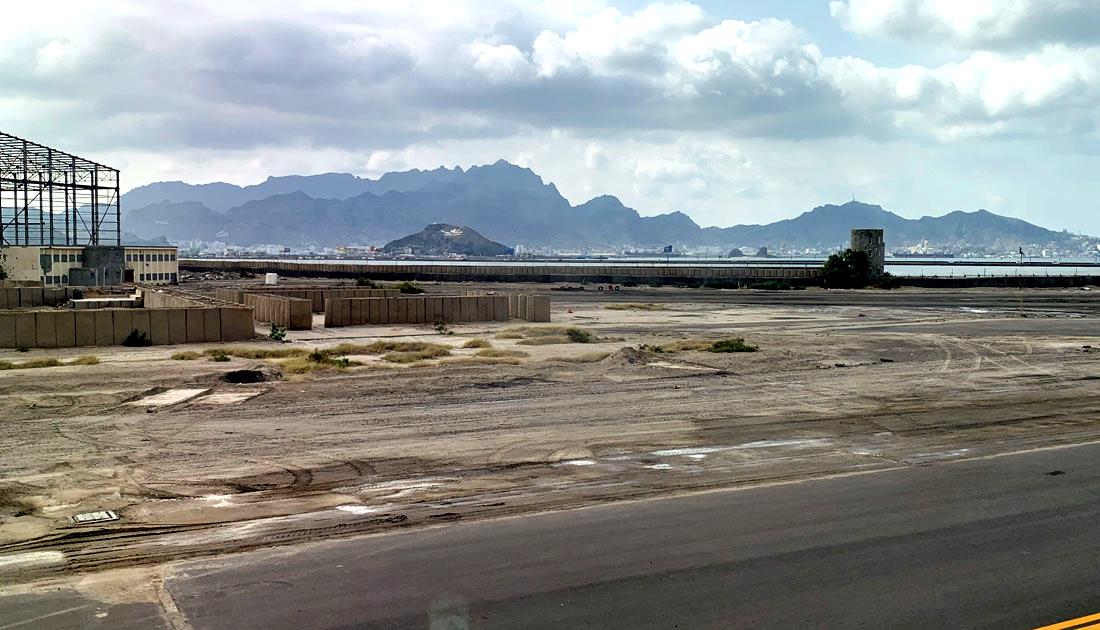


From: Stephen Davey, Tadcaster, North Yorks
Subject: First posting following the Movements School
Tony,
My movements course ended sometime in early May 1970 and I returned to Leuchars and my job in ESG, interestingly enough the RAF decided to volunteer me for a LOX course at Cardington!
My memory is very hazy about when I got posted to Brize Norton but it was either later that year or the following Spring. Anyway, my first job in Air Movements was a day job in Air Cargo filing and linking F1380's prior to call forward instructions. It was not exactly exciting and more boring than the internal voucher registry I had to endure at Leuchars during a stint in SCAF, I never did get those 3 weeks back! My torture was ended when they transferred me to A Shift Traffic. I can't say I enjoyed the total experience at Brize and was quite relieved when I received my posting to Bruggen in November 1973.
Best wishes,
Steve
Subject: First posting following the Movements School
Tony,
My movements course ended sometime in early May 1970 and I returned to Leuchars and my job in ESG, interestingly enough the RAF decided to volunteer me for a LOX course at Cardington!
My memory is very hazy about when I got posted to Brize Norton but it was either later that year or the following Spring. Anyway, my first job in Air Movements was a day job in Air Cargo filing and linking F1380's prior to call forward instructions. It was not exactly exciting and more boring than the internal voucher registry I had to endure at Leuchars during a stint in SCAF, I never did get those 3 weeks back! My torture was ended when they transferred me to A Shift Traffic. I can't say I enjoyed the total experience at Brize and was quite relieved when I received my posting to Bruggen in November 1973.
Best wishes,
Steve


From: Mark Attrill, Tallinn
Subject: First posting following the Movements School
Hi Tony,
My first posting after the RAF Officers' Movements School was my first choice - UKMAMS - probably by dint of the fact that I, after some miracle, came top of my course. Not only that but I discovered quite quickly that I would be going straight to Mobile as India Team Leader.
It was a welcome return to RAF Lyneham, where I had previously served during a Holding Posting (which included a stint with UKMAMS working with the amiable WO Merv Corke on Shift and shadowing F/O Ian Russell on Mobile). The legendary Wg Cdr Bob Dixon was the recently arrived OC UKMAMS with Charles Cruse as OC Mobile and Jim Stewart running MAMS OPS, ably assisted by WO Terry Roberts.
It was less than a year after the end of the Falklands War and the Squadron was still recovering from the impact of extended hours, lack of manpower etc., but still with a significant commitment to Cold War and routine tasking. The first three months were, quite frankly, completed in a whir with all of the introductory and mandatory pre-deployment training under the watchful eye of our Training Officer, Jerry Allen. The highlight of this was, without doubt, the culmination of the FTX at RAF Kemble which was completed in close cooperation with 5 MAPS from RAF Mildenhall and witnessed the inadvertent employment of what had been euphemistically described as a 'Nuclear Bomb simulator' which was employed during the NBC phase of the exercise and released a rather large mushroom cloud which caused significant consternation among the local population who had not been pre-warned about its deployment!
In spite of our u/t status, we were also actively involved in the Station TACEVAL [See "Rompers Green" later in this issue] during which the Squadron, under the superb leadership of Bob Dixon performed very well; the NATO team struggled to come up with any significant lessons identified apart from observing that Bob had seemed to insist on wearing his steel helmet the wrong way around throughout the entire event!
All too soon, we were released into the propwash and I recall several fascinating trips throughout my all-too-brief tour on UKMAMS, including several 'Red' and 'Green Flag' tasks to the USA and Canada, Far East and Australasian trainers/route proving and deploying the Royal Signals to Jamaica and an endless raft of NATO AMF(A) and AMF(L) tasks. I was also privileged to be teamed up with Jim Norfolk's crew from 47(S&D) Flight to undertake numerous Tac Demos around the UK and to be one of the first MACs on the Tristar. Alas, all good things come to an end and before I knew it, I was short-toured to fill an urgent requirement as OC MSF at RAF Coltishall in the summer of 1984.
Cheers!
Mark A
Subject: First posting following the Movements School
Hi Tony,
My first posting after the RAF Officers' Movements School was my first choice - UKMAMS - probably by dint of the fact that I, after some miracle, came top of my course. Not only that but I discovered quite quickly that I would be going straight to Mobile as India Team Leader.
It was a welcome return to RAF Lyneham, where I had previously served during a Holding Posting (which included a stint with UKMAMS working with the amiable WO Merv Corke on Shift and shadowing F/O Ian Russell on Mobile). The legendary Wg Cdr Bob Dixon was the recently arrived OC UKMAMS with Charles Cruse as OC Mobile and Jim Stewart running MAMS OPS, ably assisted by WO Terry Roberts.
It was less than a year after the end of the Falklands War and the Squadron was still recovering from the impact of extended hours, lack of manpower etc., but still with a significant commitment to Cold War and routine tasking. The first three months were, quite frankly, completed in a whir with all of the introductory and mandatory pre-deployment training under the watchful eye of our Training Officer, Jerry Allen. The highlight of this was, without doubt, the culmination of the FTX at RAF Kemble which was completed in close cooperation with 5 MAPS from RAF Mildenhall and witnessed the inadvertent employment of what had been euphemistically described as a 'Nuclear Bomb simulator' which was employed during the NBC phase of the exercise and released a rather large mushroom cloud which caused significant consternation among the local population who had not been pre-warned about its deployment!
In spite of our u/t status, we were also actively involved in the Station TACEVAL [See "Rompers Green" later in this issue] during which the Squadron, under the superb leadership of Bob Dixon performed very well; the NATO team struggled to come up with any significant lessons identified apart from observing that Bob had seemed to insist on wearing his steel helmet the wrong way around throughout the entire event!
All too soon, we were released into the propwash and I recall several fascinating trips throughout my all-too-brief tour on UKMAMS, including several 'Red' and 'Green Flag' tasks to the USA and Canada, Far East and Australasian trainers/route proving and deploying the Royal Signals to Jamaica and an endless raft of NATO AMF(A) and AMF(L) tasks. I was also privileged to be teamed up with Jim Norfolk's crew from 47(S&D) Flight to undertake numerous Tac Demos around the UK and to be one of the first MACs on the Tristar. Alas, all good things come to an end and before I knew it, I was short-toured to fill an urgent requirement as OC MSF at RAF Coltishall in the summer of 1984.
Cheers!
Mark A
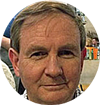

From: Dave Hardy, Lake, Isle of Wight
Subject: First posting following the Movements School
Hi Tony,
My first posting after the Air Movements course at RAF Abingdon was back to RAF Stafford as a Supplier General QAM. I had to wait for the Trade Group 18 to split into 18 (Supplier) and 18a (Air Movements). I opted for 18a and then was posted in 1971 to RAF Masirah. The only thing I remember about the trip was 23 hours in a Britannia stopping at every blade of grass on the way to Masirah.
What I enjoyed about that posting was that we regularly went down to RAF Salalah to help out; a nice trip in a Skyvan of the SOAF.
What I didn't enjoy was the fact I lost the top half of my right hand middle finger loading a CL44 with a 10 ton pile driver and then spent a week in the Med centre. The pile driver had to be lifted dead straight to slide into the back of the CL44 the only way we could do it was to put chains around it. It didn't initially lift straight up, so muggings went to move the chain up a link and the chain moved taking my finger with it! We didn't know what health and safety was in those days.
Dave
Subject: First posting following the Movements School
Hi Tony,
My first posting after the Air Movements course at RAF Abingdon was back to RAF Stafford as a Supplier General QAM. I had to wait for the Trade Group 18 to split into 18 (Supplier) and 18a (Air Movements). I opted for 18a and then was posted in 1971 to RAF Masirah. The only thing I remember about the trip was 23 hours in a Britannia stopping at every blade of grass on the way to Masirah.
What I enjoyed about that posting was that we regularly went down to RAF Salalah to help out; a nice trip in a Skyvan of the SOAF.
What I didn't enjoy was the fact I lost the top half of my right hand middle finger loading a CL44 with a 10 ton pile driver and then spent a week in the Med centre. The pile driver had to be lifted dead straight to slide into the back of the CL44 the only way we could do it was to put chains around it. It didn't initially lift straight up, so muggings went to move the chain up a link and the chain moved taking my finger with it! We didn't know what health and safety was in those days.
Dave


The first airdrop by an A400 has been completed at Sky Blu, in Antarctica
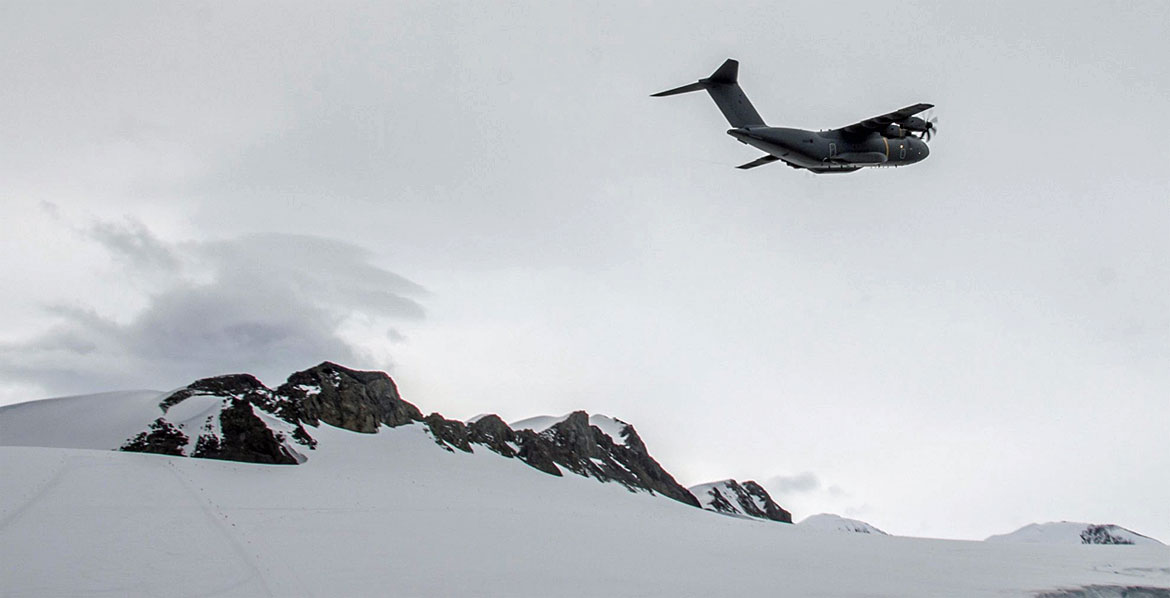
The A400M departed from the Falkand Islands heading south to Antarctica.
The aircraft first performed a flyby at Rothera, a research station is the BAS logistics centre for the Antarctic and home of well-equipped biological laboratories and facilities for a wide range of research. The station is situated on a rock and raised beach promontory at the southern extremity of Wormald Ice Piedmont, south-eastern Adelaide Island.
Then the military aircraft performed a fuel drop at Sky Blu station in order to continue deep-field science campaigns.
Sky Blu is a forward operating station for the British Antarctic Survey located in southern Palmer Land, Antarctica. It is in an area of blue ice, an extremely hard and dense ice which has lost the air bubbles that normally cloud the ice.
A RAF A330 voyager was also part of the mission support.
airlive.net
The aircraft first performed a flyby at Rothera, a research station is the BAS logistics centre for the Antarctic and home of well-equipped biological laboratories and facilities for a wide range of research. The station is situated on a rock and raised beach promontory at the southern extremity of Wormald Ice Piedmont, south-eastern Adelaide Island.
Then the military aircraft performed a fuel drop at Sky Blu station in order to continue deep-field science campaigns.
Sky Blu is a forward operating station for the British Antarctic Survey located in southern Palmer Land, Antarctica. It is in an area of blue ice, an extremely hard and dense ice which has lost the air bubbles that normally cloud the ice.
A RAF A330 voyager was also part of the mission support.
airlive.net

From: Terry Jackson, St Albans, Herts
Subject: First posting following the Movements School
Hi Tony,
I was a career Supplier but did a Movements Course at Abingdon in 1970. On New Years Eve 1971, I left UK to take up my first Movements post at RAF Changi (the Labour Government were withdrawing troops from Singapore). I was destined to take control of the air cargo hangar, but as a novice Mover spent the first month familiarising myself with every aspect of the Movements Squadron.
I found the air cargo aspect particularly interesting. I very much enjoyed the night shift with very competent and professional colleagues (I had never worked nights before other than as Orderly Sergeant). I worked with C130’s, Belfasts, Britannias and VC10s. We also worked with chartered CL44’s an aircraft based on the Britannia. You could unhook the back end and open up the aircraft; fascinating stuff! The Britannia from UK used to arrive in the late evening. We would unload and then take the pre loaded Condecs to the aircraft with the load for UK. I watched and learned from a very, very professional group of loaders nearly always led by a corporal.
On one occasion we had completed the first load and the team returned to the hangar for the second. The shift leader suggested I remained on the aircraft. I took the opportunity to explore the flight deck. A little while later my arm was tugged by the shift leader. My inexperience of night work had caught up with me and I had fallen asleep. I asked if we were ready for the next load.
"All done" he said, "time to go."
"Are we finished?" I asked.
"Yes" he said, "with your questions we would be here all night! The lads need to get their heads down." It was done very politely. Years later I was in Gibraltar on holiday and walking towards me was the young corporal, now a sergeant, who had let me sleep on the Britannia. Small world. Lovely memories.
So, then it was time for me to take charge of the air cargo hangar and again with a very professional experienced crew. It was very busy with freight coming in from all over the island. Air Freight was loaded by priority but there was an element of Indulgence Freight that we as a team could select on a fill up basis. Families returning home had a lot of personal effects to shift. We would receive the odd bottle of wine to oil the process. It would of course have no effect on our selection of indulgence freight but we did finish up with quite a wine cellar.
I returned to UK in October 1971 and on promotion to Flight Sergeant joined JSATC at RAF Hendon for my second tour as a Mover.
Very best wishes to all Movers for the new year!
Terry
Subject: First posting following the Movements School
Hi Tony,
I was a career Supplier but did a Movements Course at Abingdon in 1970. On New Years Eve 1971, I left UK to take up my first Movements post at RAF Changi (the Labour Government were withdrawing troops from Singapore). I was destined to take control of the air cargo hangar, but as a novice Mover spent the first month familiarising myself with every aspect of the Movements Squadron.
I found the air cargo aspect particularly interesting. I very much enjoyed the night shift with very competent and professional colleagues (I had never worked nights before other than as Orderly Sergeant). I worked with C130’s, Belfasts, Britannias and VC10s. We also worked with chartered CL44’s an aircraft based on the Britannia. You could unhook the back end and open up the aircraft; fascinating stuff! The Britannia from UK used to arrive in the late evening. We would unload and then take the pre loaded Condecs to the aircraft with the load for UK. I watched and learned from a very, very professional group of loaders nearly always led by a corporal.
On one occasion we had completed the first load and the team returned to the hangar for the second. The shift leader suggested I remained on the aircraft. I took the opportunity to explore the flight deck. A little while later my arm was tugged by the shift leader. My inexperience of night work had caught up with me and I had fallen asleep. I asked if we were ready for the next load.
"All done" he said, "time to go."
"Are we finished?" I asked.
"Yes" he said, "with your questions we would be here all night! The lads need to get their heads down." It was done very politely. Years later I was in Gibraltar on holiday and walking towards me was the young corporal, now a sergeant, who had let me sleep on the Britannia. Small world. Lovely memories.
So, then it was time for me to take charge of the air cargo hangar and again with a very professional experienced crew. It was very busy with freight coming in from all over the island. Air Freight was loaded by priority but there was an element of Indulgence Freight that we as a team could select on a fill up basis. Families returning home had a lot of personal effects to shift. We would receive the odd bottle of wine to oil the process. It would of course have no effect on our selection of indulgence freight but we did finish up with quite a wine cellar.
I returned to UK in October 1971 and on promotion to Flight Sergeant joined JSATC at RAF Hendon for my second tour as a Mover.
Very best wishes to all Movers for the new year!
Terry


From: George Fouhey, Bedford
Subject: First posting following the Movements School
Hi Tony and Happy New Year!
On the 8th June, 1970, I joined Junior Air Movements Course #108 at RAF Abingdon and had a great 8 weeks. It was very hard work, but the other trainees I was with were a good bunch of blokes and we had a great time. I was on PWR's and it was the one that you could get either an accompanied tour or unaccompanied for one year; I had just been married the previous June so my fingers were crossed. When we got the postings envelopes my mate, Ben Gunn, pulled an unaccompanied tour. I was lucky and got a 3-year accompanied tour at RAF Akrotiri - absolute magic!
We flew out in the September and I met up with another good mate, Dave Davis and his wife. We were in for a bit of a shock after we arrived, as temporary accommodation had been arranged for us at the Panorama Hotel on Heroes Square in Limassol. What a dive that was - complete with ladies of the evening! We had two days to find a "hiring" and furniture. Fortunately, we had a friend who was already settled and he sorted it out for us.
I recall saying to him, "Let's go to the Ladies Mile beach!" To us, the temperature was just right, but he was reluctant saying it was far too cold right now (it was Autumn!). The following year, in the Autumn, we were wearing jumpers like him! Very fond memories.
Regards,
George
Subject: First posting following the Movements School
Hi Tony and Happy New Year!
On the 8th June, 1970, I joined Junior Air Movements Course #108 at RAF Abingdon and had a great 8 weeks. It was very hard work, but the other trainees I was with were a good bunch of blokes and we had a great time. I was on PWR's and it was the one that you could get either an accompanied tour or unaccompanied for one year; I had just been married the previous June so my fingers were crossed. When we got the postings envelopes my mate, Ben Gunn, pulled an unaccompanied tour. I was lucky and got a 3-year accompanied tour at RAF Akrotiri - absolute magic!
We flew out in the September and I met up with another good mate, Dave Davis and his wife. We were in for a bit of a shock after we arrived, as temporary accommodation had been arranged for us at the Panorama Hotel on Heroes Square in Limassol. What a dive that was - complete with ladies of the evening! We had two days to find a "hiring" and furniture. Fortunately, we had a friend who was already settled and he sorted it out for us.
I recall saying to him, "Let's go to the Ladies Mile beach!" To us, the temperature was just right, but he was reluctant saying it was far too cold right now (it was Autumn!). The following year, in the Autumn, we were wearing jumpers like him! Very fond memories.
Regards,
George


From: Jacques Guay, Port Charlotte, FL
Subject: First posting following the Movements School
Hey Tony,
The year was 1973 when I graduated my PL 3 course and my first posting from CFB Borden was to CFS Moosonee, Ontario. The station was a radar site for NORAD and the CF. At first, I did not take the news too well. That particular station was located at the south end of James Bay. Totally isolated from driving your own car. The only way in or out was either by train or air travel. When I saw the train, it was labelled "The Polar Bear Express". The distance was about 186 miles and it took at least 14 hours to get there. The journey was from Cochrane, Ontario and final destination was the town of Moosonee. A very small town with mostly indigenous Cree, a small OPP contingent, and a few churches, a liquor store, a Chinese take-out restaurant and most importantly, a Hudson's Bay general store.
I then thought, "Oh well, I might as well make the best of it."
Upon arriving, I was met by my new boss, M/Cpl Gord Wheatley. He showed me to my barracks, a triple H affair. The bonus in those accommodations is that everyone had a private room. He then briefed me that we were the only two movers at said station. Oy! Being fresh out of school, I knew that I had no knowledge whatsoever as to the work routine and what it entailed. He told me that I was to handle all freight in and out, and personal effects of all members on the station; he handled all personnel movements to and fro.
Since I was single, I was to spend only one year with the possibility of staying one more year if I so wished. Married personnel had to stay for a two year stint. At any rate, I decided to have a few part time jobs which made my stay seem to go faster and more enjoyable.
If you are going to ask me if I ever went back to the station, the short of it is NO - I believe it was closed in 1975. I was transferred to 2 AMU in Trenton to a MAMS team. What a life.
Jacques
Subject: First posting following the Movements School
Hey Tony,
The year was 1973 when I graduated my PL 3 course and my first posting from CFB Borden was to CFS Moosonee, Ontario. The station was a radar site for NORAD and the CF. At first, I did not take the news too well. That particular station was located at the south end of James Bay. Totally isolated from driving your own car. The only way in or out was either by train or air travel. When I saw the train, it was labelled "The Polar Bear Express". The distance was about 186 miles and it took at least 14 hours to get there. The journey was from Cochrane, Ontario and final destination was the town of Moosonee. A very small town with mostly indigenous Cree, a small OPP contingent, and a few churches, a liquor store, a Chinese take-out restaurant and most importantly, a Hudson's Bay general store.
I then thought, "Oh well, I might as well make the best of it."
Upon arriving, I was met by my new boss, M/Cpl Gord Wheatley. He showed me to my barracks, a triple H affair. The bonus in those accommodations is that everyone had a private room. He then briefed me that we were the only two movers at said station. Oy! Being fresh out of school, I knew that I had no knowledge whatsoever as to the work routine and what it entailed. He told me that I was to handle all freight in and out, and personal effects of all members on the station; he handled all personnel movements to and fro.
Since I was single, I was to spend only one year with the possibility of staying one more year if I so wished. Married personnel had to stay for a two year stint. At any rate, I decided to have a few part time jobs which made my stay seem to go faster and more enjoyable.
If you are going to ask me if I ever went back to the station, the short of it is NO - I believe it was closed in 1975. I was transferred to 2 AMU in Trenton to a MAMS team. What a life.
Jacques

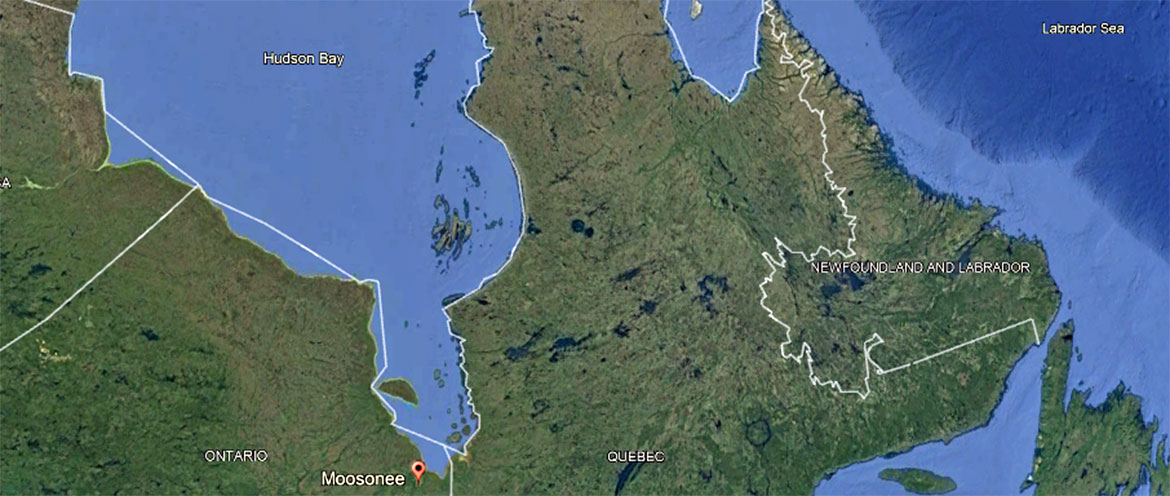

Spartans carry Fitzroy Crossing families to safety
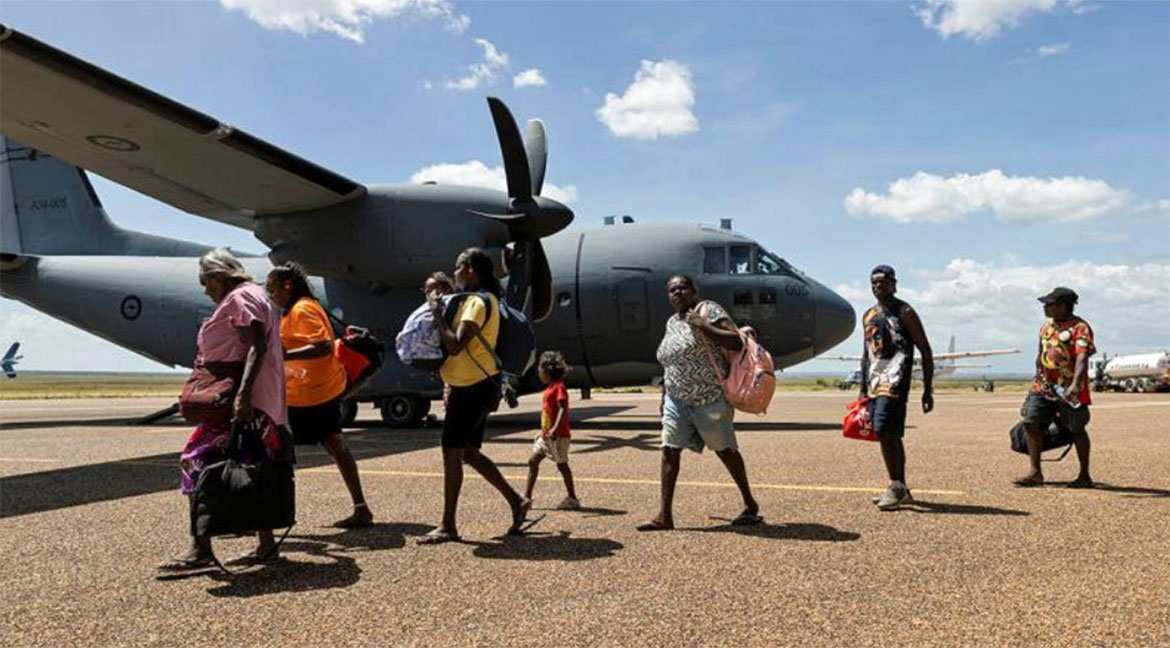
12 January 2023 - The Australian Defence Force (ADF) is working with the Western Australian Department of Communities to relocate Fitzroy Crossing area families whose houses have been hit by the state's worst flood disaster on record. Having evacuated people with severe health conditions earlier, the department is using C-27J Spartan aircraft to transport community members who are unable to access their homes because of flood damage in the aftermath of Ex-Tropical Cyclone Ellie.
Senior Project Officer with the Department of Communities, Jeanette Gould, said the agency supports people with accommodation or helps them to move in with family or relatives, where possible. “There are many people whose houses have been inundated with flood waters and there is no timeframe on when they will be able to move back in,” Ms Gould said. “We are working with Defence to transfer those people to Broome, from where we will provide them with food, money, emergency clothing, help reunify them with family and, if needed, offer them counselling.”
The airstrip at Fitzroy Crossing was initially cut off by flooding, but Defence aircraft are now able to use it to move supplies and personnel around the region.
Air Force loadmaster Corporal Deniele Oehm was part of the crew that helped 14 people from three families on one of the first Defence evacuation flights out of Fitzroy Crossing. “These families are so thankful, and it’s great to see the kids so excited,” Corporal Oehm said. “It was just a matter of making them feel comfortable, because this was their first time on a military aircraft.”
At the request of the National Emergency Management Agency, Defence will continue to provide transport aircraft, helicopters and personnel to assist flood-affected residents.
defence.gov.au
Senior Project Officer with the Department of Communities, Jeanette Gould, said the agency supports people with accommodation or helps them to move in with family or relatives, where possible. “There are many people whose houses have been inundated with flood waters and there is no timeframe on when they will be able to move back in,” Ms Gould said. “We are working with Defence to transfer those people to Broome, from where we will provide them with food, money, emergency clothing, help reunify them with family and, if needed, offer them counselling.”
The airstrip at Fitzroy Crossing was initially cut off by flooding, but Defence aircraft are now able to use it to move supplies and personnel around the region.
Air Force loadmaster Corporal Deniele Oehm was part of the crew that helped 14 people from three families on one of the first Defence evacuation flights out of Fitzroy Crossing. “These families are so thankful, and it’s great to see the kids so excited,” Corporal Oehm said. “It was just a matter of making them feel comfortable, because this was their first time on a military aircraft.”
At the request of the National Emergency Management Agency, Defence will continue to provide transport aircraft, helicopters and personnel to assist flood-affected residents.
defence.gov.au

From: Dougie Russell, Carlisle, Cumbria
Subject: First posting following the Movements School
Hi Tony,
First Posting from Movements School - October 1978 - RAF Brize Norton A Shift - Welcome to the world of Air Movements!
I spent short spell on Traffic before moving to PAX working with Jim Marchant. The following year I went into Load Control for 3 months prior to a Controller’s Course. On returning was allocated to Traffic until October 1982.
Subject: First posting following the Movements School
Hi Tony,
First Posting from Movements School - October 1978 - RAF Brize Norton A Shift - Welcome to the world of Air Movements!
I spent short spell on Traffic before moving to PAX working with Jim Marchant. The following year I went into Load Control for 3 months prior to a Controller’s Course. On returning was allocated to Traffic until October 1982.

Loaded various civilian aircraft and in 1979 we handled C141's and C5's during Operation Agila. Busy time in 1982 as SAC team leader during the Falklands War.
Some of my mates at Brize - I have many fond memories of Colin Hawson, Brian Greenwood and Ian Townsend, to name just a few.
The picture was taken during one of our coldest winters ever, -27ºC, and we had to use the Land Rovers assigned to TCW Norway so we didn’t freeze to death as we had no winterized ones of our own. During the cold weather a lot of loading was done inside the base hangar until they stopped us due to the weight of the snow on the roof and the danger of a collapse.
Dougie Russell
1978-2002
Some of my mates at Brize - I have many fond memories of Colin Hawson, Brian Greenwood and Ian Townsend, to name just a few.
The picture was taken during one of our coldest winters ever, -27ºC, and we had to use the Land Rovers assigned to TCW Norway so we didn’t freeze to death as we had no winterized ones of our own. During the cold weather a lot of loading was done inside the base hangar until they stopped us due to the weight of the snow on the roof and the danger of a collapse.
Dougie Russell
1978-2002
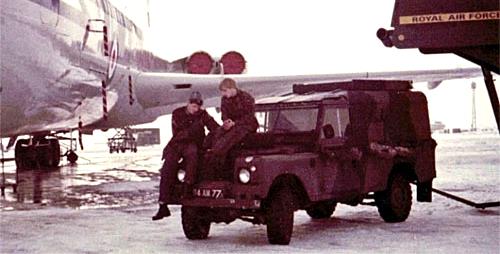

From: Bryan Morgan, Abingdon, Oxon
Subject: Training for the first Movements tour
Tony,
In 1964 Ernie Helsby and I, both members of the Physical Education Branch and syndicate officers at No.1 Parachute Training School at RAF Abingdon, were seconded to Air Movements duties because of the shortage of movers during the Confrontation with Indonesia. We made a promise not to let our parent branch down and set about doing the best we could during the following training, ie., the Senior Air Movements Course. We were lucky, of course, in that the Air Movements School was in the next hangar to the one we had worked in for the previous four years. With three weeks of the course remaining and two weeks before our final exams, Alf Wigley, the officer running our course, called us in to tell us both that because we were not of the Equipment Branch, as was, those responsible for postings had decreed that we had to be kept under close supervision and that we were both to be posted to RAF Lyneham. Accepting our fate I, myself, bought a new No.1 uniform for VIP duties and changed the rather dilapidated car for a newer model.
Having sat our final exams we awaited the results. These brought us both a further interview with Alf to be told that we not supposed to come first and second out of sixteen. What he did not realise, until we told him, was that we were both three year trained teachers before joining the RAF and we both had four years instructing experience on the Parachute School. As a result, our postings to Lyneham were cancelled with Ernie posted to RAF Luqa and myself to RAF Changi. Before we left, I had to sell the replacement car but, considering the change of posting, the financial loss was easy to bear. My family and I went on to enjoy one of the best times we had in 29 years service. However, the No.1 uniform needed a good airing out on our return to the UK having been sat in one of my parents wardrobes, with copious numbers of mothballs, for two and a half years.
Regards,
Bryan
Subject: Training for the first Movements tour
Tony,
In 1964 Ernie Helsby and I, both members of the Physical Education Branch and syndicate officers at No.1 Parachute Training School at RAF Abingdon, were seconded to Air Movements duties because of the shortage of movers during the Confrontation with Indonesia. We made a promise not to let our parent branch down and set about doing the best we could during the following training, ie., the Senior Air Movements Course. We were lucky, of course, in that the Air Movements School was in the next hangar to the one we had worked in for the previous four years. With three weeks of the course remaining and two weeks before our final exams, Alf Wigley, the officer running our course, called us in to tell us both that because we were not of the Equipment Branch, as was, those responsible for postings had decreed that we had to be kept under close supervision and that we were both to be posted to RAF Lyneham. Accepting our fate I, myself, bought a new No.1 uniform for VIP duties and changed the rather dilapidated car for a newer model.
Having sat our final exams we awaited the results. These brought us both a further interview with Alf to be told that we not supposed to come first and second out of sixteen. What he did not realise, until we told him, was that we were both three year trained teachers before joining the RAF and we both had four years instructing experience on the Parachute School. As a result, our postings to Lyneham were cancelled with Ernie posted to RAF Luqa and myself to RAF Changi. Before we left, I had to sell the replacement car but, considering the change of posting, the financial loss was easy to bear. My family and I went on to enjoy one of the best times we had in 29 years service. However, the No.1 uniform needed a good airing out on our return to the UK having been sat in one of my parents wardrobes, with copious numbers of mothballs, for two and a half years.
Regards,
Bryan
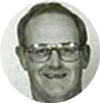

Canada finalizes deal to buy 88 F-35 fighter jets by 2032
Defence Minister Anita Anand announced the deal on January 9, calling the F-35 “the right aircraft” for Canada. “As our world grows darker, with Russia’s illegal and unjustifiable invasion of Ukraine, and China’s increasingly assertive behaviour in the Indo-Pacific, this project has taken on heightened significance, especially given the importance of interoperability with our allies,” Anand told the press conference.
News of the deal comes about eight months after the government confirmed it was moving ahead with purchasing the stealth fighters produced by Lockheed-Martin — and seven years after the Trudeau Liberals vowed never to buy them.
“This investment is estimated at $19 billion, making it the largest investment in our Royal Canadian Air Force in 30 years,” she said.
Fort McMurray Today
News of the deal comes about eight months after the government confirmed it was moving ahead with purchasing the stealth fighters produced by Lockheed-Martin — and seven years after the Trudeau Liberals vowed never to buy them.
“This investment is estimated at $19 billion, making it the largest investment in our Royal Canadian Air Force in 30 years,” she said.
Fort McMurray Today
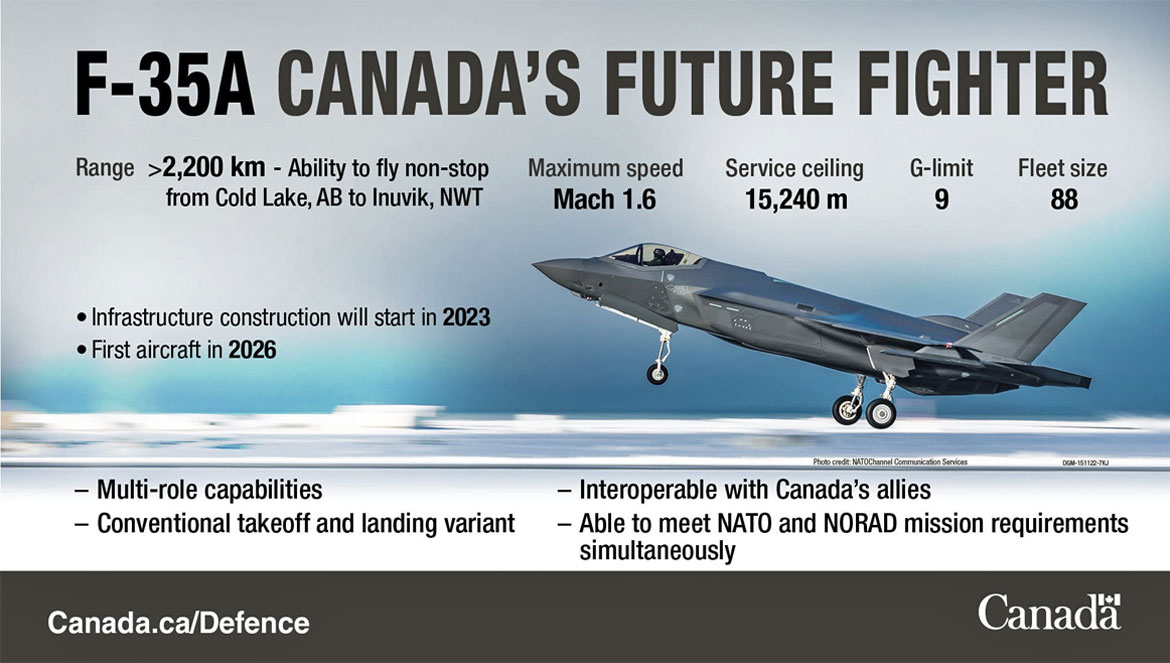

From: Alec Angus, Leeds, West Yorkshire
Subject: First posting following the Movements School
Hi Tony,
As you stated, several of the 50th Entry Boy Entrants were on JAMC 21, and a number of us went onward to Khormaksar, a 4- shift pattern was in operation. I saw very little of my fellow 50rs as it turned out as I was the only one on D shift.
I was led astray with the ATLO driver when we climbed Jebel Shamsan without adhering to the regulations. Myself and one other (whose name is lost to the sands of time) were the unlucky ones to recover the diplomatic mail from the Britannia that overshot the runway and slid into the mud, (which, by the way, stank something evil, and clung like it loved you), not great, but we all took the rough with the smooth.
I think we must have had some smooth, it was a good place for sun tanning, it's pity it was a dump though. Cheap booze and fags and duty free goods made it bearable. One fatality, Jude Whittle was killed in an aircraft loading accident, not good.
Anyway, enough of my rant, I'll leave room for the other Aden vets. Take care mate.
Alec
Subject: First posting following the Movements School
Hi Tony,
As you stated, several of the 50th Entry Boy Entrants were on JAMC 21, and a number of us went onward to Khormaksar, a 4- shift pattern was in operation. I saw very little of my fellow 50rs as it turned out as I was the only one on D shift.
I was led astray with the ATLO driver when we climbed Jebel Shamsan without adhering to the regulations. Myself and one other (whose name is lost to the sands of time) were the unlucky ones to recover the diplomatic mail from the Britannia that overshot the runway and slid into the mud, (which, by the way, stank something evil, and clung like it loved you), not great, but we all took the rough with the smooth.
I think we must have had some smooth, it was a good place for sun tanning, it's pity it was a dump though. Cheap booze and fags and duty free goods made it bearable. One fatality, Jude Whittle was killed in an aircraft loading accident, not good.
Anyway, enough of my rant, I'll leave room for the other Aden vets. Take care mate.
Alec

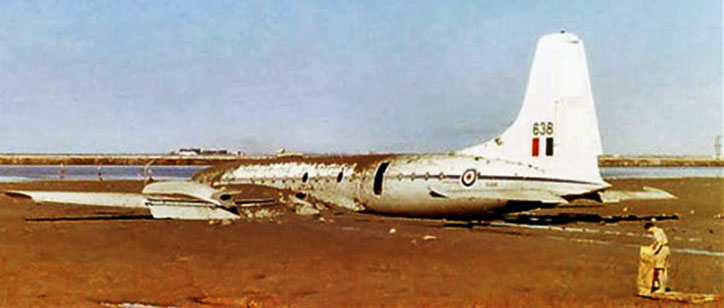

From: David Gillinder, Lowestoft, Suffolk
Subject: First posting following Movements School
Hi Tony,
I completed my Junior Movements Course at RAF Kidbrooke in the summer of 1962 (the course number escapes me) along with such movements luminaries as Dave Giles and 'Dick' Barton. I was sent on the course because the previous candidate from my first posting after Boy Entrants graduation at RAF Bassingbourne failed the course and the O/C Supply Flight took it personally and sent me (the best decision he ever made IHMO). The course in those days was 4 weeks Air Movements and 2 weeks Surface Movements with visits to RAF Lyneham and London Docks. It was at Kidbrooke that I first heard the name Khormaksar because every weighbill, manifest and trim sheet was made out to there.
Having successfully (somehow!) passed the course, I went back to Bassingbourne and in November 1962 I was PWR'd for RAF Masirah (somewhere else I had never heard of!). The winter of 1962/63 was a pretty bad one so I was happy to head off for warmer climes. So, I pitched up at Stansted Airport in the middle of January '63 and boarded an Eagle Airways Britannia for, you guessed it, Aden. I arrived in Khormaksar on a Saturday and as there were no flights up the Gulf until Monday, I was billeted at the Red Sea Transit Hotel at one end of the Maala Straight. On the Sunday night some disenchanted locals tried to blow up the Marine Craft Unit situated midway between the hotel and Khormaksar, so I was quiet happy to get my Aden Airways DC3 Monday morning flight up the Gulf calling at Riyan and Salalah.
Masirah proved to be a very large culture shock to a young, never been out of England, airman. In 1963 the accommodation was 8 man Twynehams. The Movements Section was a sergeant (Pete Skelhorne) and me with supplementary labour for incoming flights of 2 locally employed labourers and the duty supplier. The Movements Section shared a wooden building with VASF, Met office, Station Headquarters and ATC. The Control tower was an open sided lean-to stuck on top.
The weekly schedules consisted of a twice weekly Aden Airways rations run up from Khormaksar, an Argosy down from Muharraq through to Salalah and return, a Pembroke down from Muharraq and a Valetta up from Khormaksar. Wednesday was usually free of arrivals but was kept for any specials. The Valetta aircraft were crewed by Master Pilot aircrew.
ACHE consisted Pete Skelhorne, myself, the duty storeman and a flatbed 3-ton lorry with some "acquired" Beverley roller conveyer.
The Valletta was a pain because most of the weight had to be loaded forward of the wing spar which ran right scross the main cabin. This was OK when it was manhandlable boxes but when the Combined Services Entertainment party visited they bought their own upright piano which had to be "humped" over the spar.
Despite having completed the Surface Movements part of the course at Kidbrooke, our Air Movements Section never got involved with the Fleet Auxiliary vessels that called at Masirah, they were handled by the Supply Squadron.
The population of Masirah (all male) consisted of approximately 90 Europeans (a mix of service and civilian contractors working for Mothercat, Costain and Press and AMWD (Air Ministry Works Department later to be MPBW).
Despite of my initial misgivings I enjoyed my time there and Innsworth must have got wind of this because my next overseas posts were to Muharraq in 1966 and then back to Masirah in 1970.
Regards to all,
Dave
Subject: First posting following Movements School
Hi Tony,
I completed my Junior Movements Course at RAF Kidbrooke in the summer of 1962 (the course number escapes me) along with such movements luminaries as Dave Giles and 'Dick' Barton. I was sent on the course because the previous candidate from my first posting after Boy Entrants graduation at RAF Bassingbourne failed the course and the O/C Supply Flight took it personally and sent me (the best decision he ever made IHMO). The course in those days was 4 weeks Air Movements and 2 weeks Surface Movements with visits to RAF Lyneham and London Docks. It was at Kidbrooke that I first heard the name Khormaksar because every weighbill, manifest and trim sheet was made out to there.
Having successfully (somehow!) passed the course, I went back to Bassingbourne and in November 1962 I was PWR'd for RAF Masirah (somewhere else I had never heard of!). The winter of 1962/63 was a pretty bad one so I was happy to head off for warmer climes. So, I pitched up at Stansted Airport in the middle of January '63 and boarded an Eagle Airways Britannia for, you guessed it, Aden. I arrived in Khormaksar on a Saturday and as there were no flights up the Gulf until Monday, I was billeted at the Red Sea Transit Hotel at one end of the Maala Straight. On the Sunday night some disenchanted locals tried to blow up the Marine Craft Unit situated midway between the hotel and Khormaksar, so I was quiet happy to get my Aden Airways DC3 Monday morning flight up the Gulf calling at Riyan and Salalah.
Masirah proved to be a very large culture shock to a young, never been out of England, airman. In 1963 the accommodation was 8 man Twynehams. The Movements Section was a sergeant (Pete Skelhorne) and me with supplementary labour for incoming flights of 2 locally employed labourers and the duty supplier. The Movements Section shared a wooden building with VASF, Met office, Station Headquarters and ATC. The Control tower was an open sided lean-to stuck on top.
The weekly schedules consisted of a twice weekly Aden Airways rations run up from Khormaksar, an Argosy down from Muharraq through to Salalah and return, a Pembroke down from Muharraq and a Valetta up from Khormaksar. Wednesday was usually free of arrivals but was kept for any specials. The Valetta aircraft were crewed by Master Pilot aircrew.
ACHE consisted Pete Skelhorne, myself, the duty storeman and a flatbed 3-ton lorry with some "acquired" Beverley roller conveyer.
The Valletta was a pain because most of the weight had to be loaded forward of the wing spar which ran right scross the main cabin. This was OK when it was manhandlable boxes but when the Combined Services Entertainment party visited they bought their own upright piano which had to be "humped" over the spar.
Despite having completed the Surface Movements part of the course at Kidbrooke, our Air Movements Section never got involved with the Fleet Auxiliary vessels that called at Masirah, they were handled by the Supply Squadron.
The population of Masirah (all male) consisted of approximately 90 Europeans (a mix of service and civilian contractors working for Mothercat, Costain and Press and AMWD (Air Ministry Works Department later to be MPBW).
Despite of my initial misgivings I enjoyed my time there and Innsworth must have got wind of this because my next overseas posts were to Muharraq in 1966 and then back to Masirah in 1970.
Regards to all,
Dave


From: Duncan Grant, Edinburgh
Subject: First posting following Movements School
Hi Tony,
A Sharjah Story 1968 -1969. Air Movements - What Air Movements? What a blast! A 13 month unaccompanied tour with three dynamic DAMOs; McLeod, Shorter and Grant!
There were plenty of, “I learned about Movements from that...” moments. But where to start? How to manage awkward Majors, how to manage on 4 hours sleep before a shift, how to blag airlift, how to ensure paperwork is correct, how not to trust policemen? Perhaps most of all, how to recognise the professionalism and humour of your shift!
The core movements activities related to Andovers of 84 Squadron and the Argosy Gulf schedules (Muharraq-Sharjah-Masirah-Salalah), only served to provide a baseline for an important education! This extended to a day trip to Iran (Shiraz) courtesy of 84 Squadron and three days as a deputy convoy commander into Oman positioning Avtur where I had to carry a loaded weapon and learned about surface movements in the sticky heat.
There is great deal more I could recount but do not have the space here. In spite of the pilot’s best efforts I was not air sick during a Canberra sortie, but I could not manage to beat the Hunter detachment expertise stopping ceiling fans with a head!
Perhaps the most important memory is learning about people and teamwork and the superb leadership of the Station Commander, Group Captain Max Scannel, a Kiwi by birth. I also enjoyed rugby and of course the support of my shift; they were most understanding.
Finally, not many people welcome an old school mate (the late Colonel Clive Fairweather CBE) on his arrival in Sharjah undertaking his first SAS Mission when deaths were only caused by “car accidents” in Oman. It was the start of a long standing friendship.
While I remember - Les Nelson was S Mov O during most of my time at Sharjah as a DAMO. He had the privilege of being severely interrupted by me while he was holding a discussion with a Major in his office when I gave my forthright views regarding a change in "Lukfree" arrangements directly affecting me! The joys of youth!
Still, I did retire as a Group Captain so the black spot obviously faded - in spite of other bits of off-aircraft Sharjah fun. I learned about Moët et Chandon during my 13 months...
Cheers!
Duncan
Subject: First posting following Movements School
Hi Tony,
A Sharjah Story 1968 -1969. Air Movements - What Air Movements? What a blast! A 13 month unaccompanied tour with three dynamic DAMOs; McLeod, Shorter and Grant!
There were plenty of, “I learned about Movements from that...” moments. But where to start? How to manage awkward Majors, how to manage on 4 hours sleep before a shift, how to blag airlift, how to ensure paperwork is correct, how not to trust policemen? Perhaps most of all, how to recognise the professionalism and humour of your shift!
The core movements activities related to Andovers of 84 Squadron and the Argosy Gulf schedules (Muharraq-Sharjah-Masirah-Salalah), only served to provide a baseline for an important education! This extended to a day trip to Iran (Shiraz) courtesy of 84 Squadron and three days as a deputy convoy commander into Oman positioning Avtur where I had to carry a loaded weapon and learned about surface movements in the sticky heat.
There is great deal more I could recount but do not have the space here. In spite of the pilot’s best efforts I was not air sick during a Canberra sortie, but I could not manage to beat the Hunter detachment expertise stopping ceiling fans with a head!
Perhaps the most important memory is learning about people and teamwork and the superb leadership of the Station Commander, Group Captain Max Scannel, a Kiwi by birth. I also enjoyed rugby and of course the support of my shift; they were most understanding.
Finally, not many people welcome an old school mate (the late Colonel Clive Fairweather CBE) on his arrival in Sharjah undertaking his first SAS Mission when deaths were only caused by “car accidents” in Oman. It was the start of a long standing friendship.
While I remember - Les Nelson was S Mov O during most of my time at Sharjah as a DAMO. He had the privilege of being severely interrupted by me while he was holding a discussion with a Major in his office when I gave my forthright views regarding a change in "Lukfree" arrangements directly affecting me! The joys of youth!
Still, I did retire as a Group Captain so the black spot obviously faded - in spite of other bits of off-aircraft Sharjah fun. I learned about Moët et Chandon during my 13 months...
Cheers!
Duncan
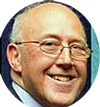
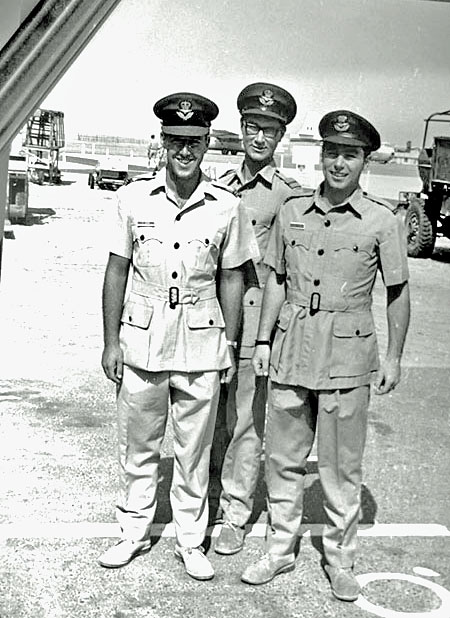
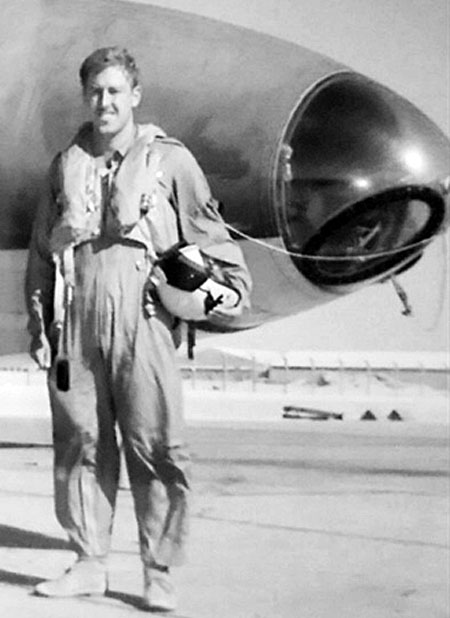
The Three Musketeers - Grant, Shorter and McLeod
All DAMOs on our first Movements tours
All DAMOs on our first Movements tours
Despite the pilot's best efforts, I managed to hold
on to my breakfast during a Canberra flight
on to my breakfast during a Canberra flight

From: Ian Place, Leeds, West Yorks
Subject: First posting following the Movements School
Tony,
My first posting following the movements school was to RAF Muharraq in Bahrain. It was a busy station, much larger than the international airport back in those days. In fact some civilian carriers who didn't look at their NOTAMS taxied onto our massive ramp with all our staff waving them off.
The first night there in the transit hut we were warned by posters on the wall not to switch the fans on as we would be decapitated if we climbed onto the double bunk beds. We never had air conditioning, that was reserved for them with rings on their shoulders. The favourite sport was bondu trecking the length of the runway and back , approximately 4 miles, in 100ºF heat. I had blonde hair and black skin back in those days.
Ian
Subject: First posting following the Movements School
Tony,
My first posting following the movements school was to RAF Muharraq in Bahrain. It was a busy station, much larger than the international airport back in those days. In fact some civilian carriers who didn't look at their NOTAMS taxied onto our massive ramp with all our staff waving them off.
The first night there in the transit hut we were warned by posters on the wall not to switch the fans on as we would be decapitated if we climbed onto the double bunk beds. We never had air conditioning, that was reserved for them with rings on their shoulders. The favourite sport was bondu trecking the length of the runway and back , approximately 4 miles, in 100ºF heat. I had blonde hair and black skin back in those days.
Ian


From: Stephen Bird, Chester
Subject: First posting following the Movements School
Hi Tony,
My first posting after eventually leaving the Movements School in early 1981 was RAF Coltishall. To get a posting to Coltishall was pretty rare then straight off the school, 90% of baby movers ended up at Brize Norton or Lyneham. I went there as a single lad and was accommodated in a surplus married quarter off camp with 2 chefs. To be honest it was not ideal due to the fact as an LAC and not living on the camp was a bit of a pain; it was a long walk to the Airmans' Mess and the NAAFI. It was a good first posting though to be honest, lots of detachments accompanying the squadrons of Jaguars to the likes of Bardufoss, Decimomannu, Laarbruch and many other exotic overseas destinations.
I think what sticks in my mind about the tour was great nights out down in Norwich, messing about on the Norfolk Broads and walking to the nearest village on summer evenings and even dark nights, without any cars passing to go to a couple of pubs called the Farmers and Weavers Arms. The Weavers in particular did the best bacon butties I've had to this day.
The MSF/Movs flight at Coltishall was a pretty big unit. The Movers there were Sgt Tony Fowler, Cpls Dave Leighton and Chris Keen and SAC's Andy Piesse, Skid Marks, Dave Morrow, Mike Lyke, Russell Parrish, Morph Richards and myself. There was a WO, George something, his last name escapes me. We were supported by a number of stackers and overall it was a very good posting. Most weekends we had Hercules or VC-10's arriving for deployments. Sadly I was only there for about 12 months due to the operators' posts being disestablished. I learnt a lot in that 12 months though.
A couple of other things I remember is being nobbled for Gate Guard on the day of the marriage of Prince Charles and Princess Diana, also breaking my ankle falling down the stairs of Bells Taxi office in Norwich after having one too many; I was due to be deployed to I think it was called Tirstrip or something like that. I was posted from there to Brize Norton the first of 3 postings over the following 22 years.
Regards,
Stephen
Subject: First posting following the Movements School
Hi Tony,
My first posting after eventually leaving the Movements School in early 1981 was RAF Coltishall. To get a posting to Coltishall was pretty rare then straight off the school, 90% of baby movers ended up at Brize Norton or Lyneham. I went there as a single lad and was accommodated in a surplus married quarter off camp with 2 chefs. To be honest it was not ideal due to the fact as an LAC and not living on the camp was a bit of a pain; it was a long walk to the Airmans' Mess and the NAAFI. It was a good first posting though to be honest, lots of detachments accompanying the squadrons of Jaguars to the likes of Bardufoss, Decimomannu, Laarbruch and many other exotic overseas destinations.
I think what sticks in my mind about the tour was great nights out down in Norwich, messing about on the Norfolk Broads and walking to the nearest village on summer evenings and even dark nights, without any cars passing to go to a couple of pubs called the Farmers and Weavers Arms. The Weavers in particular did the best bacon butties I've had to this day.
The MSF/Movs flight at Coltishall was a pretty big unit. The Movers there were Sgt Tony Fowler, Cpls Dave Leighton and Chris Keen and SAC's Andy Piesse, Skid Marks, Dave Morrow, Mike Lyke, Russell Parrish, Morph Richards and myself. There was a WO, George something, his last name escapes me. We were supported by a number of stackers and overall it was a very good posting. Most weekends we had Hercules or VC-10's arriving for deployments. Sadly I was only there for about 12 months due to the operators' posts being disestablished. I learnt a lot in that 12 months though.
A couple of other things I remember is being nobbled for Gate Guard on the day of the marriage of Prince Charles and Princess Diana, also breaking my ankle falling down the stairs of Bells Taxi office in Norwich after having one too many; I was due to be deployed to I think it was called Tirstrip or something like that. I was posted from there to Brize Norton the first of 3 postings over the following 22 years.
Regards,
Stephen


From: Jim Mackintosh, Glasgow, North Lanarkshire
Subject: First Posting after Movements School
Hi Tony,
In January 1961, as a raw recruit, I completed the Clerk Air Movements Course at the Movements School at RAF Kidbrooke. On the last day we were all given our course results and waited patiently for our postings. Most of the course were posted to Lyneham, Colerne, Aden and the Gulf States. My course mate, a fellow Scot named John Jenkins, got Nicosia and I thought lucky sod. It was my turn next and the instructor stated, "Joint Services Booking Centre, London. I have never heard of it!” After contacting the RAF Records Office I was told I had to report to RAF Hendon where I would be given further instructions. It turned out I was the first airman from the school to be posted there.
JSBC was formed in the autumn of 1960 to control the flight bookings of civil air trooping to Germany and replace the troopship service which operated from Harwich to Hook of Holland. At that time National Service was just running down and thousand of troops were stationed throughout Germany as well as RAF personnel.
Our Joint Service unit was located at 5 Great Scotland Yard, Whitehall, having four small offices within a building housing the Central London Recruiting Centre for the Army as well as the HQ of the Garrison Sergeant Major, London District. The Army element of our unit were Royal Engineers who were the army movers before becoming the RCT and comprised of Major (CO), WOII, Sergeant and 3 Cpls/L/Cpls. The RAF were a Flt/Lt (2 i/c), Sergeant John Jennings and myself as well as a civilian typist. We had two airmen on detachment from Lyneham who were extremely miffed to be returned to their unit shortly after my arrival.
At that time the trooping was conducted by Silver City Airways operating Handley Page Hermes aircraft from RAF Manston flying to Dusseldorf civil airport five days a week and RAF Wildenrath twice. In those days folks there were no computers, mobile phones or photocopiers etc., everything had to be handwritten. The day before each flight the nominal rolls were typed up onto a master skin then printed on a hand cranked Gestetner (talk about getting your hands black with ink!). These nominal rolls had to then be taken by hand to Manston courtesy of the Sgt and SAC Paddy Mcdonough, who operated daily on reserved train space from Victoria to Margate documenting passengers en route.
As a young lad who had never been out of Scotland before, this was an eye opener working in the centre of London.eing issued with a London Transport season ticket allowed travel all over the city and surrounds. At cease work we went to the Nuffield Centre just off the Strand, where at 5pm each day they dished out free tickets to shows. These were often for the best seats in the theatres which were unsold. I certainly never imagined when I signed up and viewed the photos of aircraft and airfields shown me by the recruiter that I would end up working with the Army in London.
Jim
Subject: First Posting after Movements School
Hi Tony,
In January 1961, as a raw recruit, I completed the Clerk Air Movements Course at the Movements School at RAF Kidbrooke. On the last day we were all given our course results and waited patiently for our postings. Most of the course were posted to Lyneham, Colerne, Aden and the Gulf States. My course mate, a fellow Scot named John Jenkins, got Nicosia and I thought lucky sod. It was my turn next and the instructor stated, "Joint Services Booking Centre, London. I have never heard of it!” After contacting the RAF Records Office I was told I had to report to RAF Hendon where I would be given further instructions. It turned out I was the first airman from the school to be posted there.
JSBC was formed in the autumn of 1960 to control the flight bookings of civil air trooping to Germany and replace the troopship service which operated from Harwich to Hook of Holland. At that time National Service was just running down and thousand of troops were stationed throughout Germany as well as RAF personnel.
Our Joint Service unit was located at 5 Great Scotland Yard, Whitehall, having four small offices within a building housing the Central London Recruiting Centre for the Army as well as the HQ of the Garrison Sergeant Major, London District. The Army element of our unit were Royal Engineers who were the army movers before becoming the RCT and comprised of Major (CO), WOII, Sergeant and 3 Cpls/L/Cpls. The RAF were a Flt/Lt (2 i/c), Sergeant John Jennings and myself as well as a civilian typist. We had two airmen on detachment from Lyneham who were extremely miffed to be returned to their unit shortly after my arrival.
At that time the trooping was conducted by Silver City Airways operating Handley Page Hermes aircraft from RAF Manston flying to Dusseldorf civil airport five days a week and RAF Wildenrath twice. In those days folks there were no computers, mobile phones or photocopiers etc., everything had to be handwritten. The day before each flight the nominal rolls were typed up onto a master skin then printed on a hand cranked Gestetner (talk about getting your hands black with ink!). These nominal rolls had to then be taken by hand to Manston courtesy of the Sgt and SAC Paddy Mcdonough, who operated daily on reserved train space from Victoria to Margate documenting passengers en route.
As a young lad who had never been out of Scotland before, this was an eye opener working in the centre of London.eing issued with a London Transport season ticket allowed travel all over the city and surrounds. At cease work we went to the Nuffield Centre just off the Strand, where at 5pm each day they dished out free tickets to shows. These were often for the best seats in the theatres which were unsold. I certainly never imagined when I signed up and viewed the photos of aircraft and airfields shown me by the recruiter that I would end up working with the Army in London.
Jim
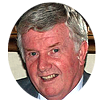

From: Mike McCann, Beckwithshaw, North Yorks
Subject: First posting following the Movements School
Hi Tony,
I completed No.103 Air Movs Course. Fellow “movers” included Dixie Dean, Dick De Caires, 2 x Tony Smith et all (photo attached). I'm back row far left.
I arrived on RAF Gan, in the Maldives, on 24 Jan '70 and it's fair to say that it was probably one of the best tours I had. I was met off the VC-10 at about 1000 by assorted movers and was whipped away to the VIP lounge at the Blue Lagoon, route hotel, for an early morning beer. Suffice to say, I don't recall many of the names from that day. I woke up next morning in a 4-man room and across the room was the room boy standing staring at a naked Reg Tudor. The other side and in the bed next to me was Bob White (See Pic). I kept in touch with Reg Till he died.
Memories of Air Movs - Half the tour on the pan, the rest as a Movements Co-ord in the office, prepping trim sheds, load plans etc. alongside John Joyce, Adrian Roberts and Pete Biggs - still in touch with John, and Pete. Other names, Dave Morris, Ken Morris, Norman Stamper. Chris Twyman, Alan Henchoz et al. Radio Gan, which I ended up running, prepping me for Veterans Radio Net. The smile on the face of Cpl John Stevens when the second Skynet cabin rolled off the Belfast, onto the condec and knocked the first one off the back. Both John and Sgt Arthur Cole had warned the DAMO that the brake lock at the back wasn’t on! The Marine Bar, the 180 Club, Pakistani and Ceylonese clubs - great curries and games nights and the civilian messes next to Movements, straight after shift. Dhonie races, round Gan bike races. Ex Bersatu Padu, when over a couple of weeks we handled more aircraft than we did for the rest of the year.
Being a mover and a famous Radio DJ (ha!) gave me opportunities to pass the time of day with AQMs and lady Air Stewards. Helped morale!
Up to Singapore for R & R and sport - nurses, Bugis Street, Changi Creek Hotel and village, eating lychees and drinking Tiger whilst waiting to get a suit and some shirts made.
There would be more, but times awasting? I’ve been back twice to the Equator Village Hotel; old SNCO’s mess. The people are still as lovely. I even met Mo Didi, the head Movs Maldi. He died a couple of years back
All in all, a hell tour!
Mike
Subject: First posting following the Movements School
Hi Tony,
I completed No.103 Air Movs Course. Fellow “movers” included Dixie Dean, Dick De Caires, 2 x Tony Smith et all (photo attached). I'm back row far left.
I arrived on RAF Gan, in the Maldives, on 24 Jan '70 and it's fair to say that it was probably one of the best tours I had. I was met off the VC-10 at about 1000 by assorted movers and was whipped away to the VIP lounge at the Blue Lagoon, route hotel, for an early morning beer. Suffice to say, I don't recall many of the names from that day. I woke up next morning in a 4-man room and across the room was the room boy standing staring at a naked Reg Tudor. The other side and in the bed next to me was Bob White (See Pic). I kept in touch with Reg Till he died.
Memories of Air Movs - Half the tour on the pan, the rest as a Movements Co-ord in the office, prepping trim sheds, load plans etc. alongside John Joyce, Adrian Roberts and Pete Biggs - still in touch with John, and Pete. Other names, Dave Morris, Ken Morris, Norman Stamper. Chris Twyman, Alan Henchoz et al. Radio Gan, which I ended up running, prepping me for Veterans Radio Net. The smile on the face of Cpl John Stevens when the second Skynet cabin rolled off the Belfast, onto the condec and knocked the first one off the back. Both John and Sgt Arthur Cole had warned the DAMO that the brake lock at the back wasn’t on! The Marine Bar, the 180 Club, Pakistani and Ceylonese clubs - great curries and games nights and the civilian messes next to Movements, straight after shift. Dhonie races, round Gan bike races. Ex Bersatu Padu, when over a couple of weeks we handled more aircraft than we did for the rest of the year.
Being a mover and a famous Radio DJ (ha!) gave me opportunities to pass the time of day with AQMs and lady Air Stewards. Helped morale!
Up to Singapore for R & R and sport - nurses, Bugis Street, Changi Creek Hotel and village, eating lychees and drinking Tiger whilst waiting to get a suit and some shirts made.
There would be more, but times awasting? I’ve been back twice to the Equator Village Hotel; old SNCO’s mess. The people are still as lovely. I even met Mo Didi, the head Movs Maldi. He died a couple of years back
All in all, a hell tour!
Mike

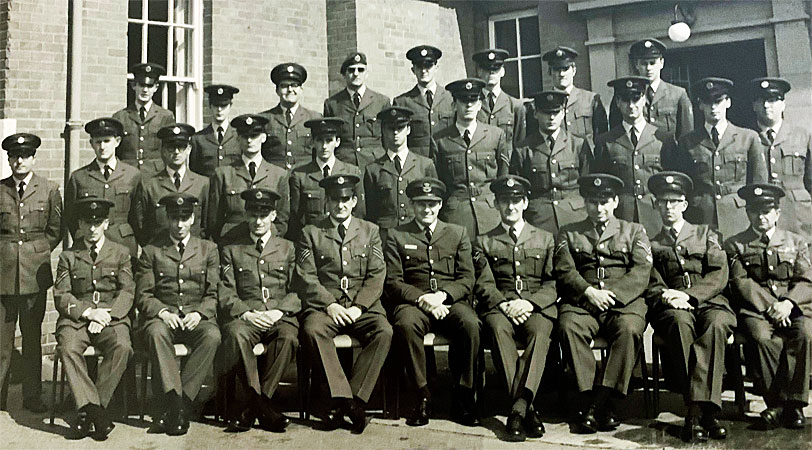
Air Movements Course 103 - I'm in the back row at the far left
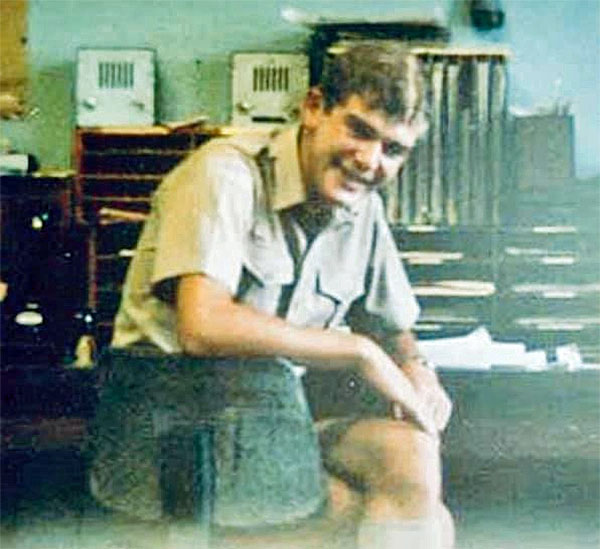
Mike McCann - RAF Gan, Maldives - 1970
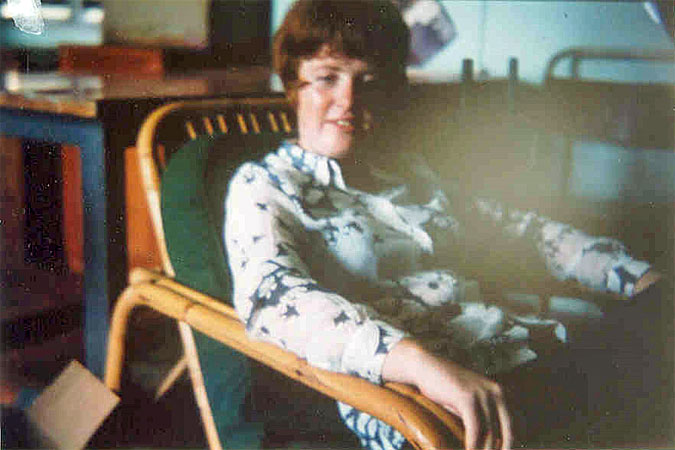
1970 - A VC-10 ALM in the Radio Gan Studio
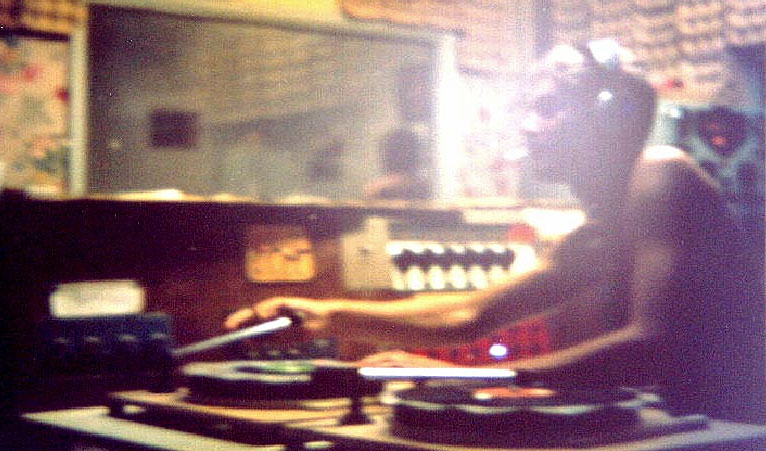
A shirtless Mike McCann on the turntable at Radio Gan
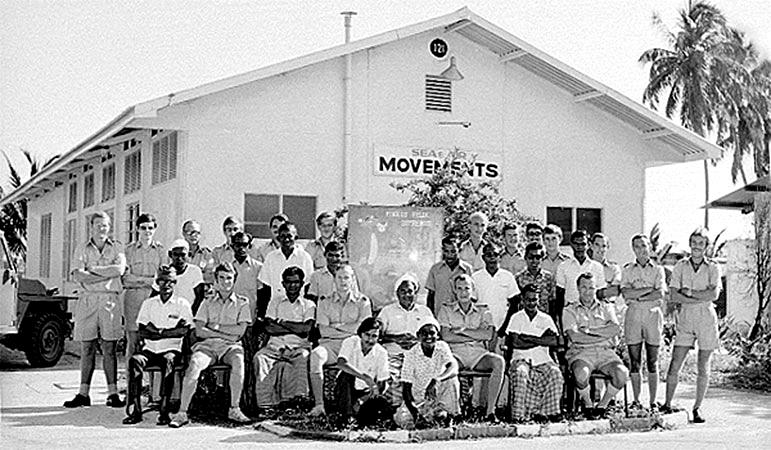
1970 - Air and Sea Movements RAF Gan
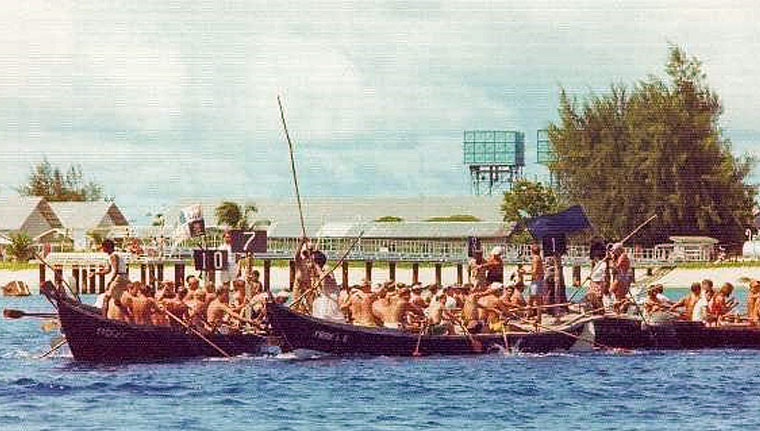
1970 - Dhoni race at Gan
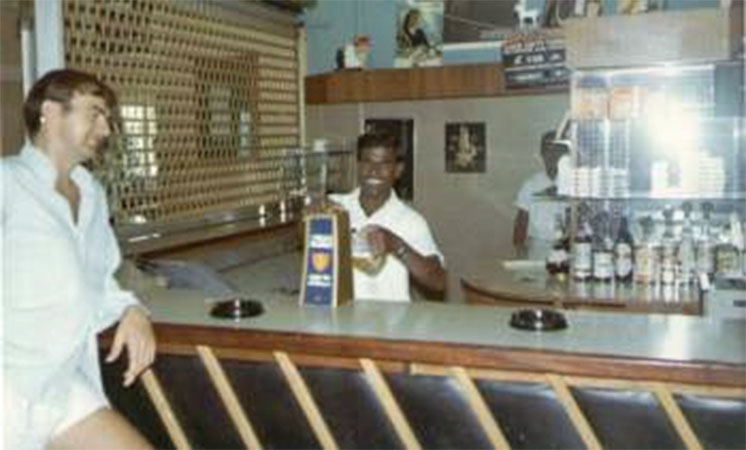
Bob White and Sandy the barman at the 180 Club
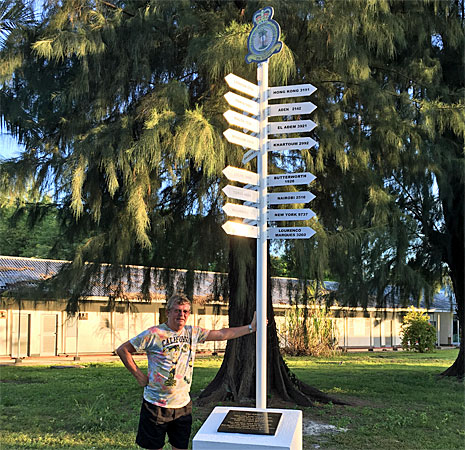
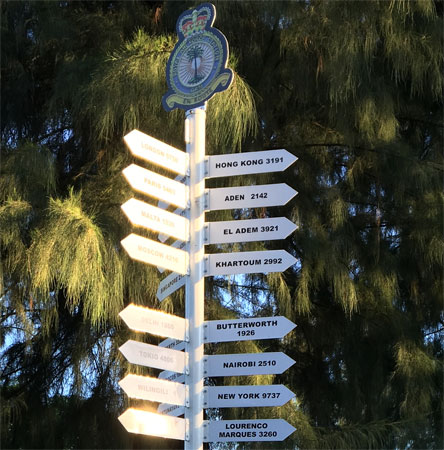
Decades later - Self with the renovated/upgraded milepost
Decades later - the milepost on RAF Gan
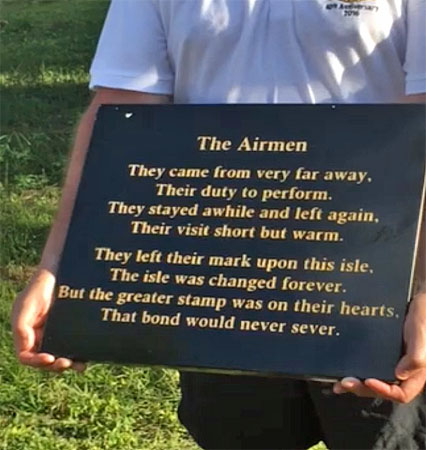
Self with the milepost plaque and pome wot I rote

From: Liam Devlin, Port Talbot, West Glamorgan
Subject: First posting following the Movements School
Good morning Tony,
Summer of 1963 I did my ‘Q’ Movements Course at Kirton Lindsey and through a friend of a friend at RAF Innsworth I got my first posting to RAF Seletar. Travelled out to Singapore on a Comet from Lyneham. Also on board was a lot of people joining a new the 5001 Airfield Construction Squadron, because I arrived with them the Chief Clerk assumed I was to be their Storeman! So, I spent a couple of weeks in a grotty stores tent with a miserable stores WO. On my way to and from work I used to pass FEAF MAMS where I felt I should be. One day there was an officer standing just inside the hangar and I thought I would speak to him about my horrible posting, gave him my story, then went on my way to lunch. In the afternoon an irate stores WO told me to get out and go to FEAF MAMS where I spent the next 2.5 years!
Best regards
Liam
Subject: First posting following the Movements School
Good morning Tony,
Summer of 1963 I did my ‘Q’ Movements Course at Kirton Lindsey and through a friend of a friend at RAF Innsworth I got my first posting to RAF Seletar. Travelled out to Singapore on a Comet from Lyneham. Also on board was a lot of people joining a new the 5001 Airfield Construction Squadron, because I arrived with them the Chief Clerk assumed I was to be their Storeman! So, I spent a couple of weeks in a grotty stores tent with a miserable stores WO. On my way to and from work I used to pass FEAF MAMS where I felt I should be. One day there was an officer standing just inside the hangar and I thought I would speak to him about my horrible posting, gave him my story, then went on my way to lunch. In the afternoon an irate stores WO told me to get out and go to FEAF MAMS where I spent the next 2.5 years!
Best regards
Liam


From: Mark Stephenson, Dieppe, NB
Subject: First Posting Following Movements School
Hi Tony,
My first posting from the Movements school was to Ascension Island. However, 6 months later I was to follow in the footsteps of Chris Goss who was posted to UKMAMS soon after I arrived on Ascension. I arrived in December 1984 to take over the “leadership” of the shift. This was my first experience of working with an experienced movements team working 2 days, 2 nights, 2 off shift schedule. My first SNCO was John Billinsgley (replaced later by Chris Keen) who really showed me what practical air movements is all about! I considered our shift to be the best of the 3 shifts (not that the other 2 DAMOs Vanessa Mitchell & Maria Djumic would agree). Working with Steve Biggs, Paul Wilson, Duncan Andrews, Neil Jenkinson, Ginge Barrett to name a few was a totally worthwhile experience with many lessons learned. One lesson I shall always remember is telling Chris Cahill in Load Control that his desk was quite messy, receiving the response “Well sir, a tidy desk is a sign of homosexuality!”
Apart from the movements work on VC10, Hercs and Belfast, we worked with the “new” Tristar fleet crewed by a mix of RAF & BA crews. On these troop roulements the RAF auxiliary movers came from UK to give us a hand. These guys were pretty good at building baggage stacks in cargo nets for the Wessex to take to awaiting passenger ships such as Uganda.
In our spare time we managed shift BBQs at English Bay, socialising with our American allies at the Volcano club as well as the odd night stop on the fuel tankers moored off Ascension (British Esk & MV Maersk) to play competitive darts. We also managed a cruise around Ascension on the Maersk to keep the crew and the engines ship shape.
During the tour, I was sent back to UK for a week to complete the Tristar Dispatchers course. On the VC10 freighter southbound a fellow passenger was Major General (later General) Sir Peter de la Billiere on his way south as to assume command of the Falklands Garrison. Quite an impressive man with an SF background – his autobiography is a great read. Speaking of the Falklands, I had a few beers with an old school friend in transit to FI. I promised him that when he returned northbound the next beers would be on me. Sadly, he was one of the pilots on the RN Sea King that collided with a Herc in the skies around FI, with no survivors from the helicopter.
Towards the end of my tour the new terminal was completed (with real air conditioning - unlike the open windows of the nose hangar) and we received the first BA Boeing 747 transiting to the new Mount Pleasant airport. Although my shift was on duty it seemed that whole of the RAF station came out to be close to the action! I am pleased to say that my “gozome” bird in June 1985 was a BA 747 in the first class section.
An excellent tour as my baptism to the movements world with some great characters to help me gain good experience in a short time.
Mark
Subject: First Posting Following Movements School
Hi Tony,
My first posting from the Movements school was to Ascension Island. However, 6 months later I was to follow in the footsteps of Chris Goss who was posted to UKMAMS soon after I arrived on Ascension. I arrived in December 1984 to take over the “leadership” of the shift. This was my first experience of working with an experienced movements team working 2 days, 2 nights, 2 off shift schedule. My first SNCO was John Billinsgley (replaced later by Chris Keen) who really showed me what practical air movements is all about! I considered our shift to be the best of the 3 shifts (not that the other 2 DAMOs Vanessa Mitchell & Maria Djumic would agree). Working with Steve Biggs, Paul Wilson, Duncan Andrews, Neil Jenkinson, Ginge Barrett to name a few was a totally worthwhile experience with many lessons learned. One lesson I shall always remember is telling Chris Cahill in Load Control that his desk was quite messy, receiving the response “Well sir, a tidy desk is a sign of homosexuality!”
Apart from the movements work on VC10, Hercs and Belfast, we worked with the “new” Tristar fleet crewed by a mix of RAF & BA crews. On these troop roulements the RAF auxiliary movers came from UK to give us a hand. These guys were pretty good at building baggage stacks in cargo nets for the Wessex to take to awaiting passenger ships such as Uganda.
In our spare time we managed shift BBQs at English Bay, socialising with our American allies at the Volcano club as well as the odd night stop on the fuel tankers moored off Ascension (British Esk & MV Maersk) to play competitive darts. We also managed a cruise around Ascension on the Maersk to keep the crew and the engines ship shape.
During the tour, I was sent back to UK for a week to complete the Tristar Dispatchers course. On the VC10 freighter southbound a fellow passenger was Major General (later General) Sir Peter de la Billiere on his way south as to assume command of the Falklands Garrison. Quite an impressive man with an SF background – his autobiography is a great read. Speaking of the Falklands, I had a few beers with an old school friend in transit to FI. I promised him that when he returned northbound the next beers would be on me. Sadly, he was one of the pilots on the RN Sea King that collided with a Herc in the skies around FI, with no survivors from the helicopter.
Towards the end of my tour the new terminal was completed (with real air conditioning - unlike the open windows of the nose hangar) and we received the first BA Boeing 747 transiting to the new Mount Pleasant airport. Although my shift was on duty it seemed that whole of the RAF station came out to be close to the action! I am pleased to say that my “gozome” bird in June 1985 was a BA 747 in the first class section.
An excellent tour as my baptism to the movements world with some great characters to help me gain good experience in a short time.
Mark
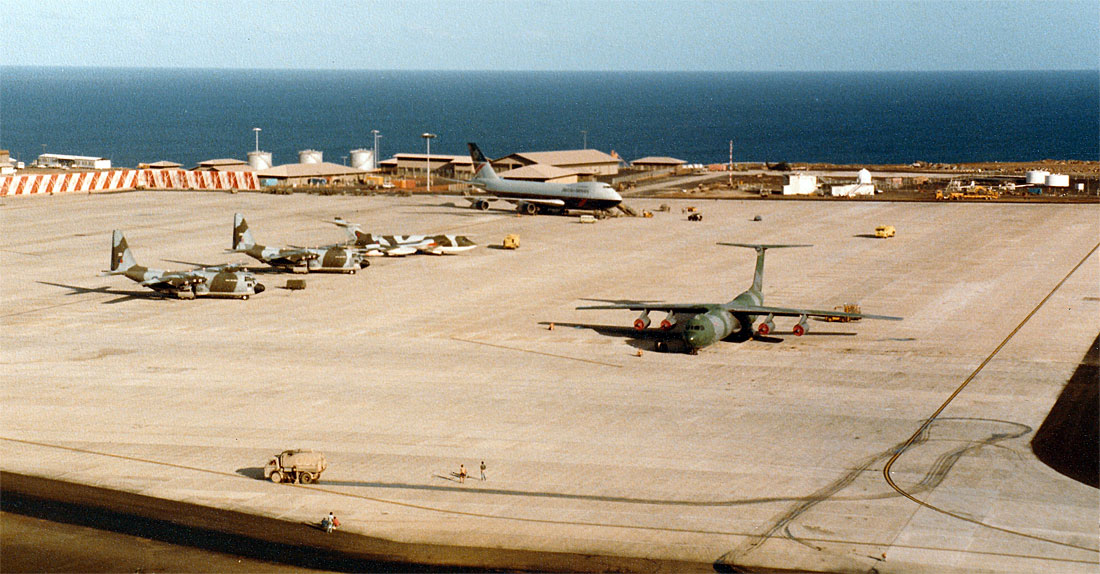
The aircraft pan on Ascension
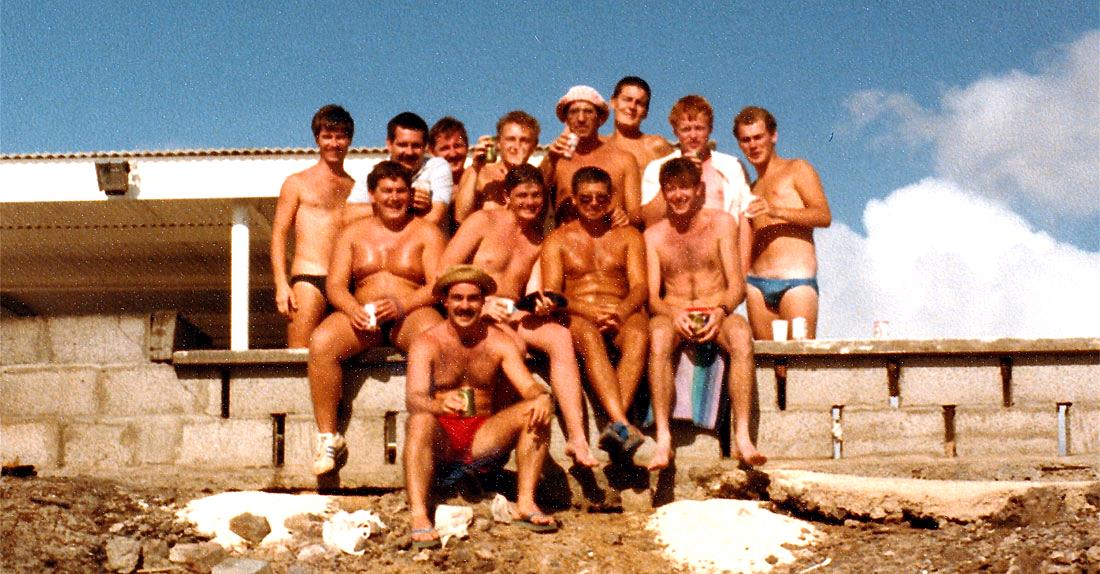
Shift BBQ with guest firemen
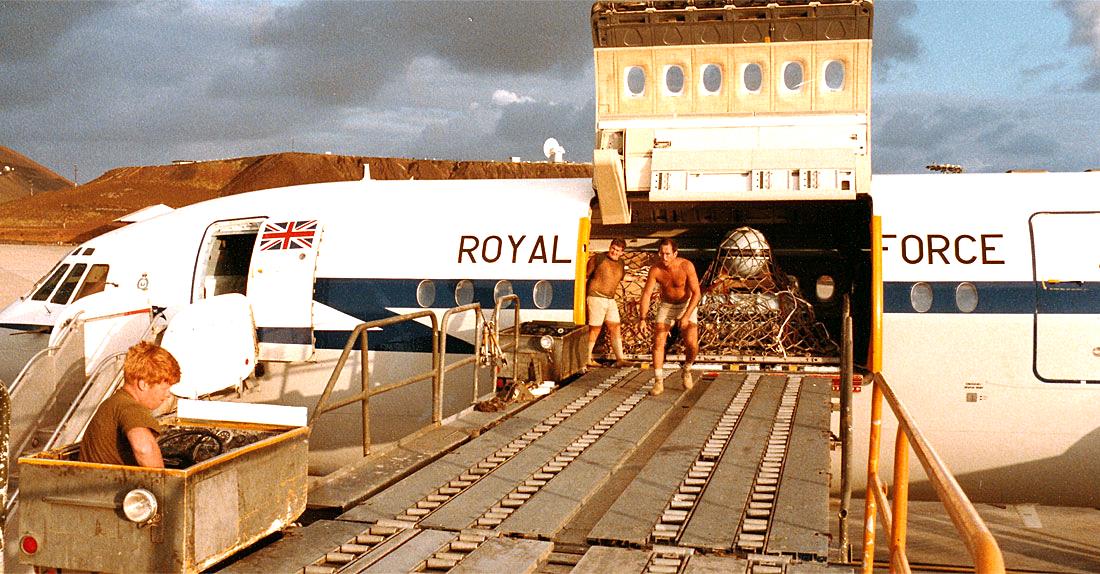
Ginge Barrett and Chris Keen offloading (or loading?) a VC-10
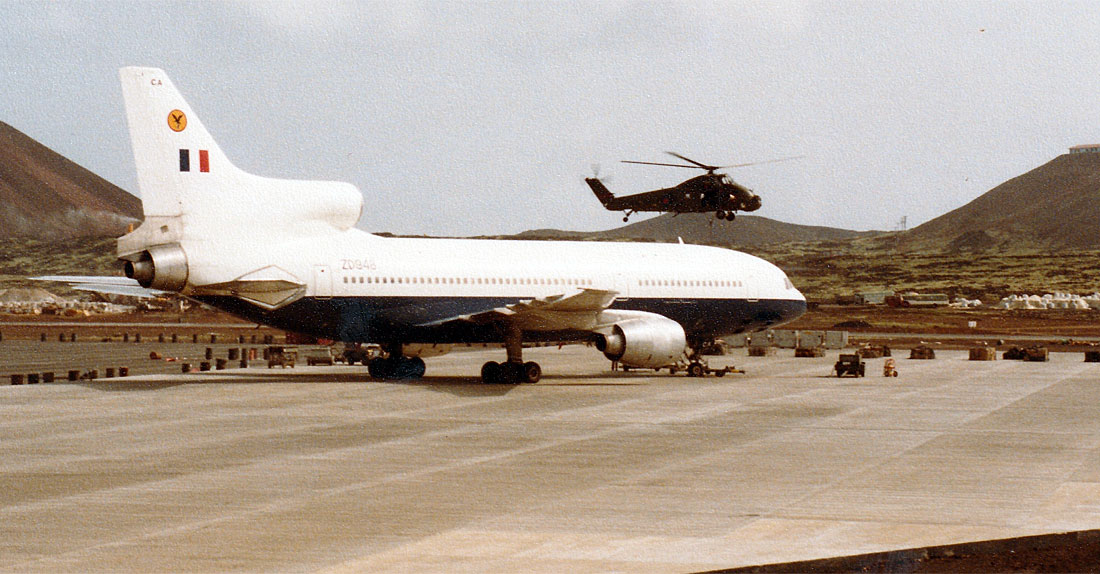
Lockheed L-1011 TriStar with Westland Wessex Helicopter
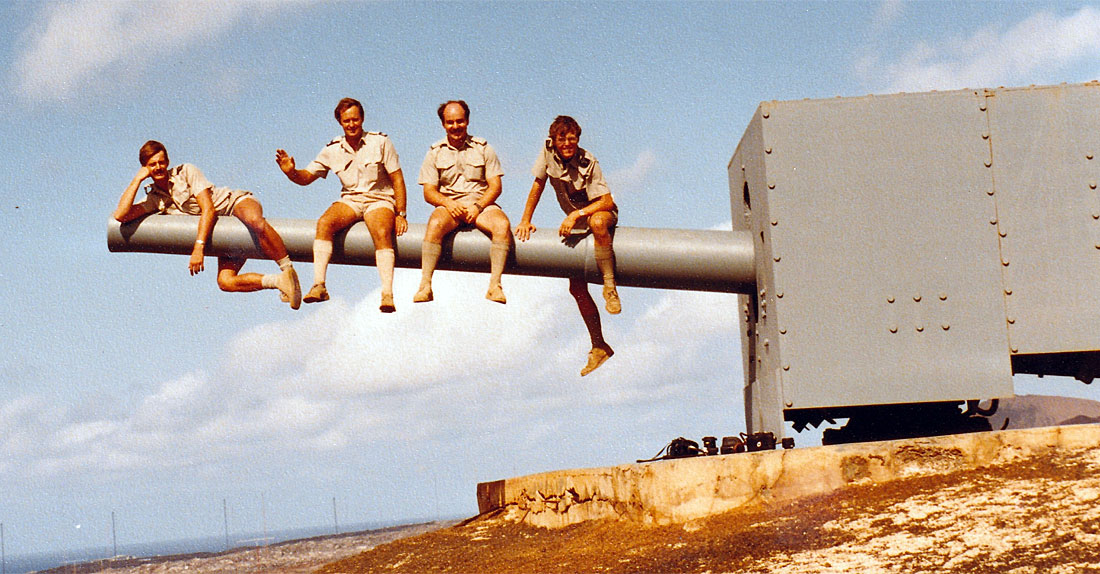
Team resting on a 5.5" caliber gun from HMS Hood
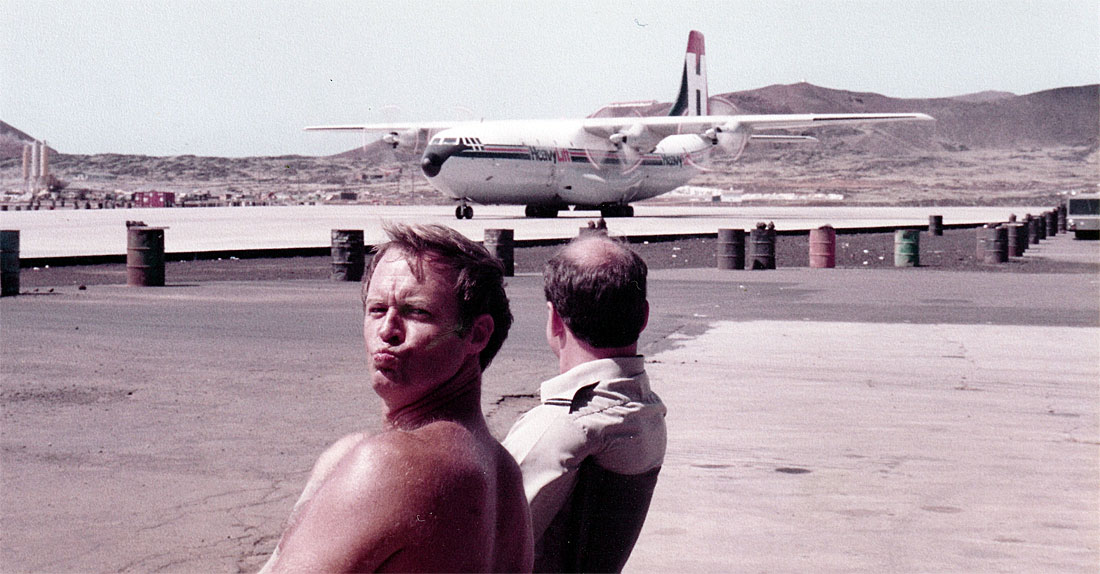
John Billingsley and self waiting for the HeavyLift Belfast


From: Pete Orton, Camberley, Surrey
Subject: First posting following the Movements School
Hi Tony,
Leaving 28 JAMC in Jan 1967, in common with most of our peer group, I started my movements career in the Gulf. My arrival in Muharraq in July '67 was the start of my growing up process (never completed). The build-up in the Gulf was to acclimatise and prepare for the Aden withdrawal in November of that year. Home squadrons at that time were 30 Sqn (Beveleys) and 105 Sqn (Argosys) ; a steady stream of UK based VC-10s , Comets, Britannias and Belslows provided a full Movs education . The shiny C130 Hercules just came in on line to play a major part in the tactical part of the operation. It'ss just a shame that Trump and Biden failed to prepare in the same way for the Afghanistan airlift!
Thanks for all your bril efforts,
Pete
Subject: First posting following the Movements School
Hi Tony,
Leaving 28 JAMC in Jan 1967, in common with most of our peer group, I started my movements career in the Gulf. My arrival in Muharraq in July '67 was the start of my growing up process (never completed). The build-up in the Gulf was to acclimatise and prepare for the Aden withdrawal in November of that year. Home squadrons at that time were 30 Sqn (Beveleys) and 105 Sqn (Argosys) ; a steady stream of UK based VC-10s , Comets, Britannias and Belslows provided a full Movs education . The shiny C130 Hercules just came in on line to play a major part in the tactical part of the operation. It'ss just a shame that Trump and Biden failed to prepare in the same way for the Afghanistan airlift!
Thanks for all your bril efforts,
Pete


From: Ian Berry, Eastleaze, Swindon, Wilts
Subject: First posting following the Movements School
Hi Tony,
My time in Aden preceded my course when I was detached to 114MU Steamer Point Jan-May 1967. Then in August whilst stationed at RAF Acklington, Northumberland, I was sent to AMTS (Air Movements Training School) at Abingdon to join No 37 JAMC (Junior Air Movements Course). I loved it all and excelled at it and the end of course trip to RAF Wildenrath, Germany on a Beverley was a bonus.
The course finished in October and as Aden closed down in November I escaped that. It wasn't until a year later in November 1968 that I was posted to the Air Movements Squadron in RAF El Adem, Libya. A station even worse than Aden and some 20 miles inland from Tobruk on the edge of the Sahara Desert! Yes, we had flies too. My first Sgt was Ken Browne and amazingly some five years later he was my team FSgt on UKMAMS.
Ian
Subject: First posting following the Movements School
Hi Tony,
My time in Aden preceded my course when I was detached to 114MU Steamer Point Jan-May 1967. Then in August whilst stationed at RAF Acklington, Northumberland, I was sent to AMTS (Air Movements Training School) at Abingdon to join No 37 JAMC (Junior Air Movements Course). I loved it all and excelled at it and the end of course trip to RAF Wildenrath, Germany on a Beverley was a bonus.
The course finished in October and as Aden closed down in November I escaped that. It wasn't until a year later in November 1968 that I was posted to the Air Movements Squadron in RAF El Adem, Libya. A station even worse than Aden and some 20 miles inland from Tobruk on the edge of the Sahara Desert! Yes, we had flies too. My first Sgt was Ken Browne and amazingly some five years later he was my team FSgt on UKMAMS.
Ian
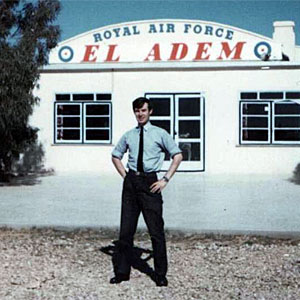
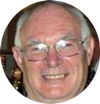

New members who have joined us recently:
Welcome to the OBA!
Sean Blythe, Darlington, County Durham
Jon Gould, Enford, Wilts

From: Mick Craner, Yeovil, Somerset
Subject: Movements School?
From National Service Cook to MALM
Hello Tony,
I did not attend Movements School, and what follows is what happened when I joined. In 1950, I was happy driving a Muir Hill dumper at the Rover works in Solihull Birmingham, I earned £17 a week; a very good wage in those days.
My world was about to change, I became 18. The King wrote asking me to help with his armed services and would I help for 2 Years? I was asked to go to Worcester for a medical and to decide what service I would like to help. I was informed that there was a place for me in the Royal Air Force and I would be informed when to attend.
In August 1950 the King wrote again asking me to travel to R.A.F. Padgate, included in his letter was a railway warrant to proceed from Birmingham New Street to Warrington, transport was arranged to Padgate. So, off I went with my little case arriving later at Warrington, a group of bewildered young men, we were accosted by some very rude junior NCOs who told us to move our arses and get aboard some blue Bedford lorries. Arriving at Padgate driving through the main gate we noticed some very smart armed guards. We concluded that they must have been members for a considerable time, little did we realise that in about six weeks we would be marching up and down guarding the camp and it’s valuable contents.
We were issued with a mug and irons and taken for a meal, bloody awful fish and chips, lots of marge jam and bread, after this repast we were taken to wooden huts containing old iron beds 3 biscuits very thin blankets and a straw filled pillow. Next day barbers for a short back and sides then to be issued with uniforms, boots, a complete set of webbing, mess tins and all the necessary kit to make the complete airman. There followed weeks of marching everywhere, polishing everything that did not move and saluting every thing that did. But we finished as the smartest group ever to leave Padgate.
We were called before an officer to decide what trades we would have, no problem, I had a new driving licence. The officer asked if I knew any thing about catering, I had been taught how to bake bread by the bakers in my village, so I told the officer I could bake Bread... Error, I was a Cook! I was posted to Waterbeach where I completed my National Service.
Six months later, on 1st April 1953, I rejoined and was posted to Bridgnorth, then to Gibraltar. I worked in the Airmans' Mess at Northfront ,did a lot of night shifts and met members of the Movements who came for suppers and supplies of tea and sugar. Gibraltar was a very good posting; I bought my first car there when I became tourex. my friends in Movements shipped my car to Lyneham on a Hastings.
After Gibraltar, Henlow then Penang, still as a Cook; a dead end for promotion. I had thought many times about becoming an A.Q.M. but it meant about two years as a an acting Sgt and the return to basic trade and rank. Posted to Rudloe Manor and things changed. Q.M. became a permanent trade with aircrew promotion. I applied but wastold I was too old, but had a terrific C.O. who got me an age waiver.
I completed the course; Parchuting at Abingdon, Movements and airmanship at Thorney Island, then was posted to 36 Squadron at Colerne. I was very fortunate with promotion as I had completed eleven years, I was promoted from Cpl acting Sgt to F/Sgt and posted to 48 Squadron Changi - the cream of postings.
After Changi it was Number one Hercules course at Thorney and posting to 36 Squadron at Lyneham. An incredible time at Lyneham, I was promoted to Master AQM (later known as Master Air Loadmaster). Traveled the world - stayed in the best of digs - absolute MAGIC. Do it again? I don’t think it would be half as good.
Cheers!
Mick
Subject: Movements School?
From National Service Cook to MALM
Hello Tony,
I did not attend Movements School, and what follows is what happened when I joined. In 1950, I was happy driving a Muir Hill dumper at the Rover works in Solihull Birmingham, I earned £17 a week; a very good wage in those days.
My world was about to change, I became 18. The King wrote asking me to help with his armed services and would I help for 2 Years? I was asked to go to Worcester for a medical and to decide what service I would like to help. I was informed that there was a place for me in the Royal Air Force and I would be informed when to attend.
In August 1950 the King wrote again asking me to travel to R.A.F. Padgate, included in his letter was a railway warrant to proceed from Birmingham New Street to Warrington, transport was arranged to Padgate. So, off I went with my little case arriving later at Warrington, a group of bewildered young men, we were accosted by some very rude junior NCOs who told us to move our arses and get aboard some blue Bedford lorries. Arriving at Padgate driving through the main gate we noticed some very smart armed guards. We concluded that they must have been members for a considerable time, little did we realise that in about six weeks we would be marching up and down guarding the camp and it’s valuable contents.
We were issued with a mug and irons and taken for a meal, bloody awful fish and chips, lots of marge jam and bread, after this repast we were taken to wooden huts containing old iron beds 3 biscuits very thin blankets and a straw filled pillow. Next day barbers for a short back and sides then to be issued with uniforms, boots, a complete set of webbing, mess tins and all the necessary kit to make the complete airman. There followed weeks of marching everywhere, polishing everything that did not move and saluting every thing that did. But we finished as the smartest group ever to leave Padgate.
We were called before an officer to decide what trades we would have, no problem, I had a new driving licence. The officer asked if I knew any thing about catering, I had been taught how to bake bread by the bakers in my village, so I told the officer I could bake Bread... Error, I was a Cook! I was posted to Waterbeach where I completed my National Service.
Six months later, on 1st April 1953, I rejoined and was posted to Bridgnorth, then to Gibraltar. I worked in the Airmans' Mess at Northfront ,did a lot of night shifts and met members of the Movements who came for suppers and supplies of tea and sugar. Gibraltar was a very good posting; I bought my first car there when I became tourex. my friends in Movements shipped my car to Lyneham on a Hastings.
After Gibraltar, Henlow then Penang, still as a Cook; a dead end for promotion. I had thought many times about becoming an A.Q.M. but it meant about two years as a an acting Sgt and the return to basic trade and rank. Posted to Rudloe Manor and things changed. Q.M. became a permanent trade with aircrew promotion. I applied but wastold I was too old, but had a terrific C.O. who got me an age waiver.
I completed the course; Parchuting at Abingdon, Movements and airmanship at Thorney Island, then was posted to 36 Squadron at Colerne. I was very fortunate with promotion as I had completed eleven years, I was promoted from Cpl acting Sgt to F/Sgt and posted to 48 Squadron Changi - the cream of postings.
After Changi it was Number one Hercules course at Thorney and posting to 36 Squadron at Lyneham. An incredible time at Lyneham, I was promoted to Master AQM (later known as Master Air Loadmaster). Traveled the world - stayed in the best of digs - absolute MAGIC. Do it again? I don’t think it would be half as good.
Cheers!
Mick
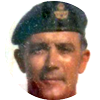

From: Terry Jackson, St Albans, Herts
Subject: Aden Arrival
Tony,
I was interested to read your view of arrival in Aden. My experience was much the same. I was posted to Aden in June 1960. 114 Mu Explosives Site, just across the road from Khormaksar. I was 23 years old and had never been overseas. We flew in a Britannia which as you know would have taken an age. Being a junior rank, I was towards the rear of the aircraft. They opened the aircraft door and let families and officers off. As you will know, the aircraft became an oven. At the aircraft door my first thought was, I cannot live here. I was met at the bottom of the aircraft steps. I asked the question. “Is it this hot all the time?” Reply, “Two temperatures here, hot and bloody hot”. “This is just hot”. Service humour at its best. Even so, after acclimatisation I enjoyed the tour. We worked from 7am until 1pm. You never saw a European on the streets until after 4pm.
Regards,
Terry
Subject: Aden Arrival
Tony,
I was interested to read your view of arrival in Aden. My experience was much the same. I was posted to Aden in June 1960. 114 Mu Explosives Site, just across the road from Khormaksar. I was 23 years old and had never been overseas. We flew in a Britannia which as you know would have taken an age. Being a junior rank, I was towards the rear of the aircraft. They opened the aircraft door and let families and officers off. As you will know, the aircraft became an oven. At the aircraft door my first thought was, I cannot live here. I was met at the bottom of the aircraft steps. I asked the question. “Is it this hot all the time?” Reply, “Two temperatures here, hot and bloody hot”. “This is just hot”. Service humour at its best. Even so, after acclimatisation I enjoyed the tour. We worked from 7am until 1pm. You never saw a European on the streets until after 4pm.
Regards,
Terry


Where are they now? The DPOW
(Real name withheld - those who know, will know!)
(Real name withheld - those who know, will know!)
Gordon Gourdie, Euxton, Lancs
Any idea what happened to the DPOW? Funny the things that come to mind all of a sudden.
Any idea what happened to the DPOW? Funny the things that come to mind all of a sudden.
Ken Davie, Palm Beach Gardens, FL
OMG, the stories we could tell! I was on 'I' team with the DPOW in 1968/69 for 1 1/2 years or so. I have PTSD because of it. So much incompetence in one person! The Clouseau of the RAF!
OMG, the stories we could tell! I was on 'I' team with the DPOW in 1968/69 for 1 1/2 years or so. I have PTSD because of it. So much incompetence in one person! The Clouseau of the RAF!
This Newsletter is Dedicated
to the Memories of
Stephen George (RAF)
John Russel Harries (RCAF)
to the Memories of
Stephen George (RAF)
John Russel Harries (RCAF)
Tony Gale
ukmamsoba@gmail.com
ukmamsoba@gmail.com







